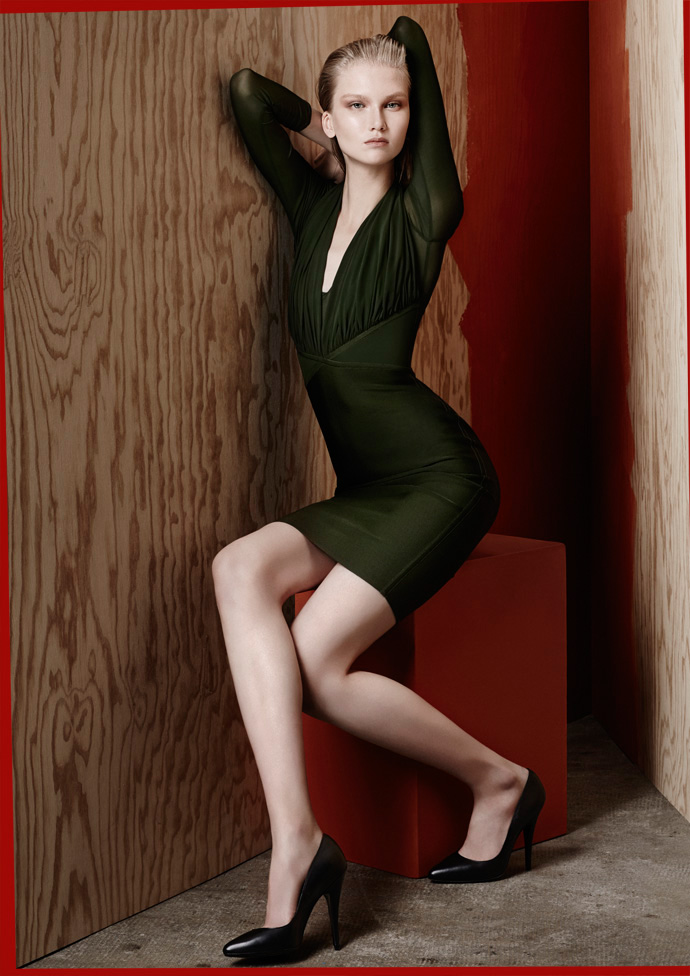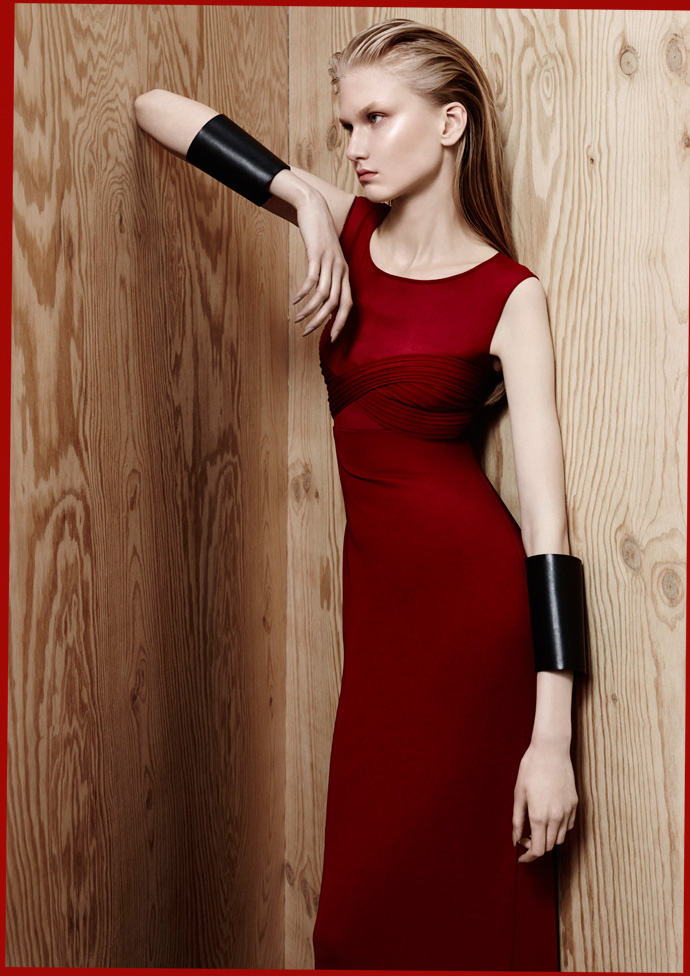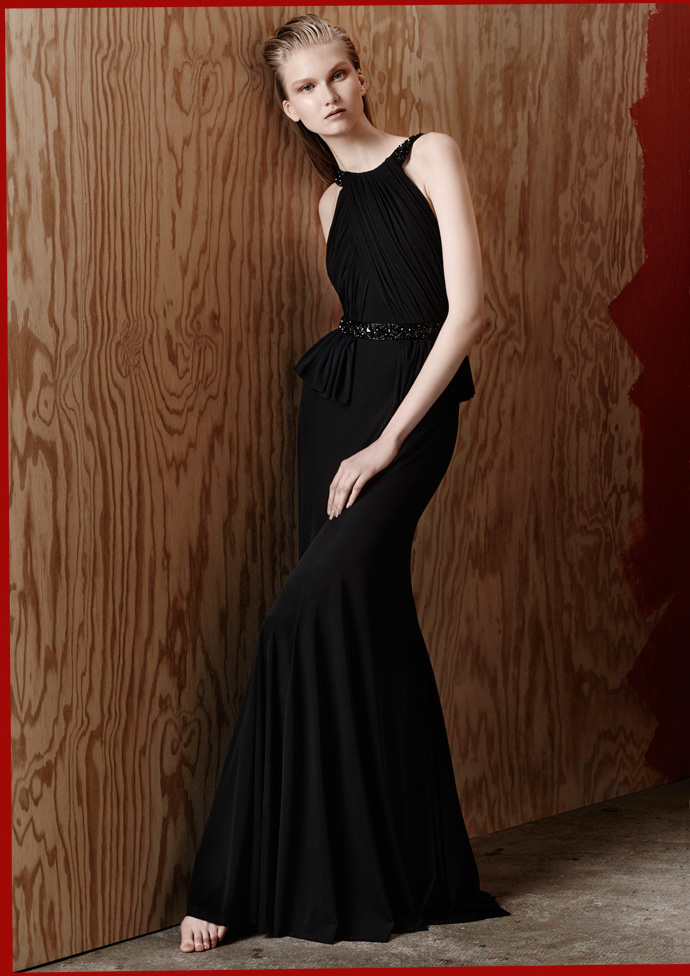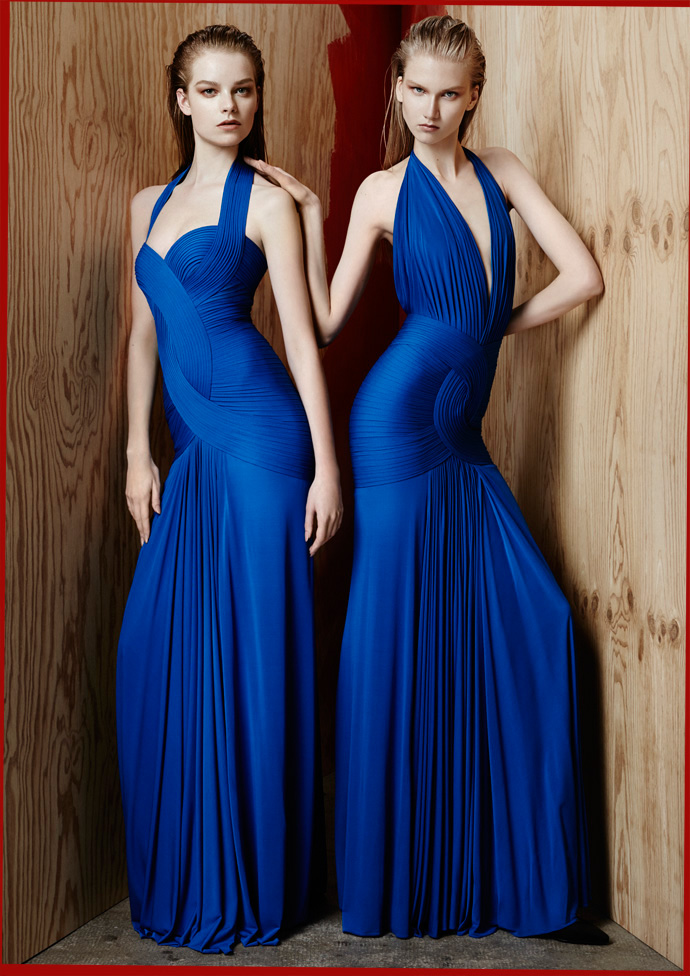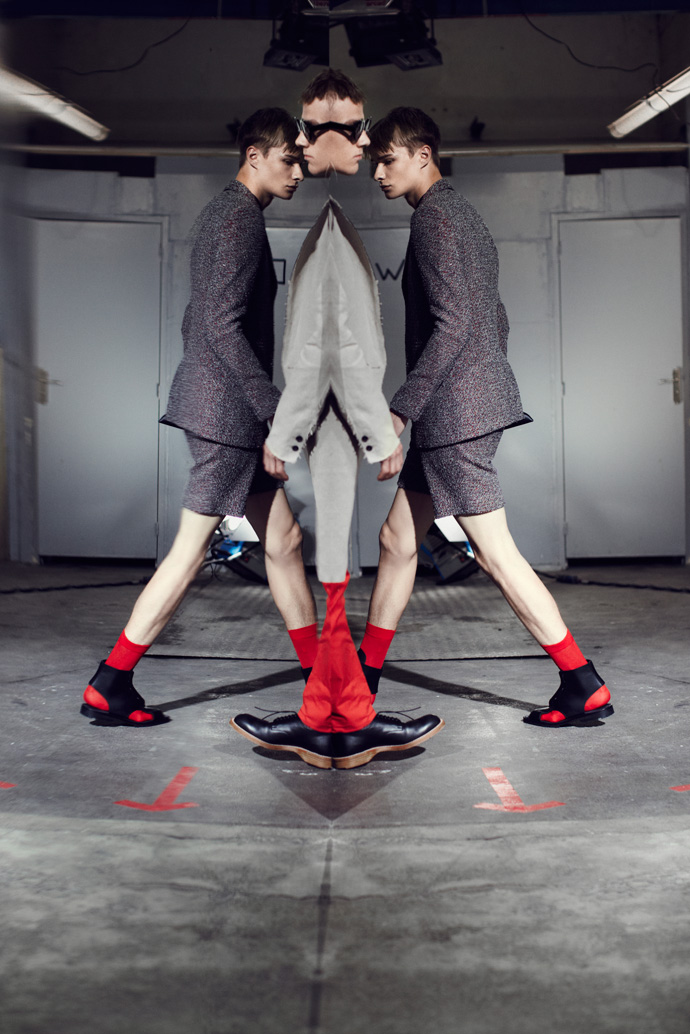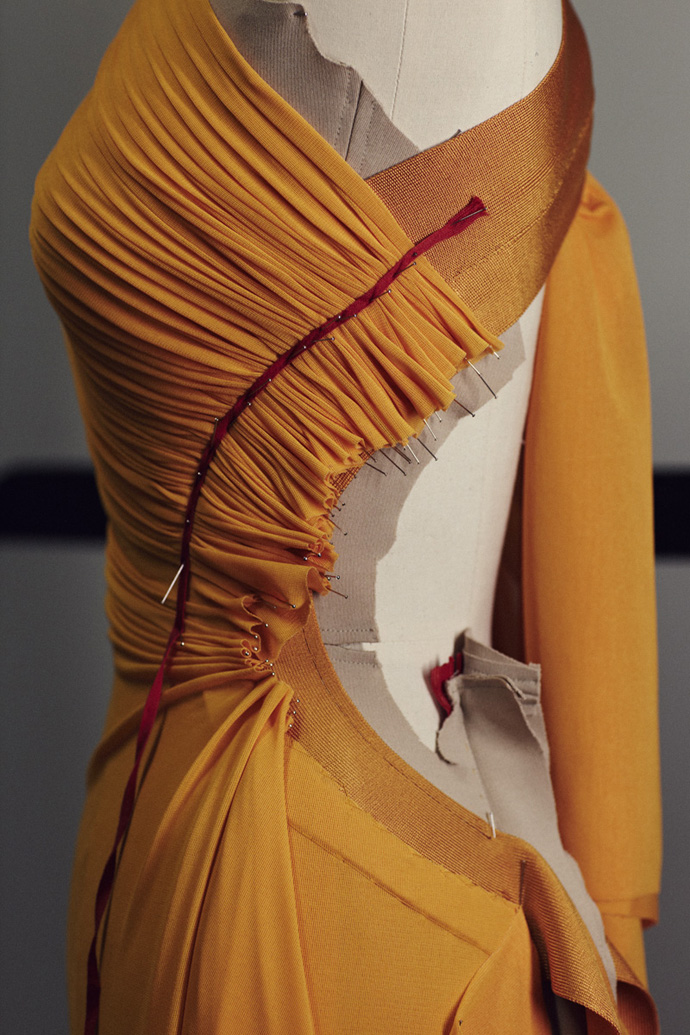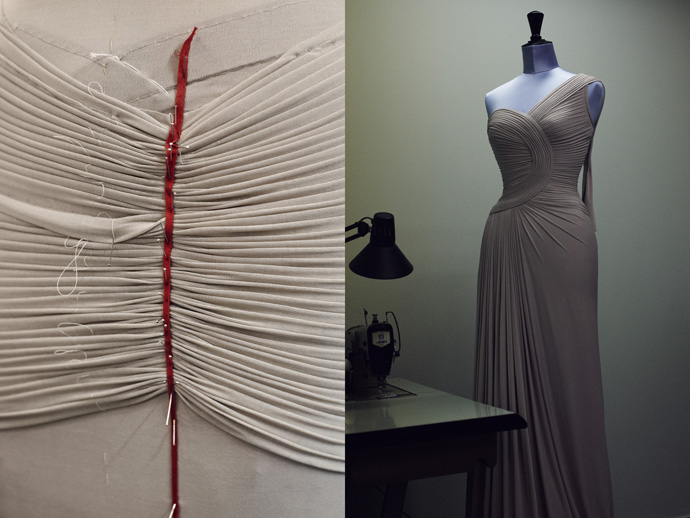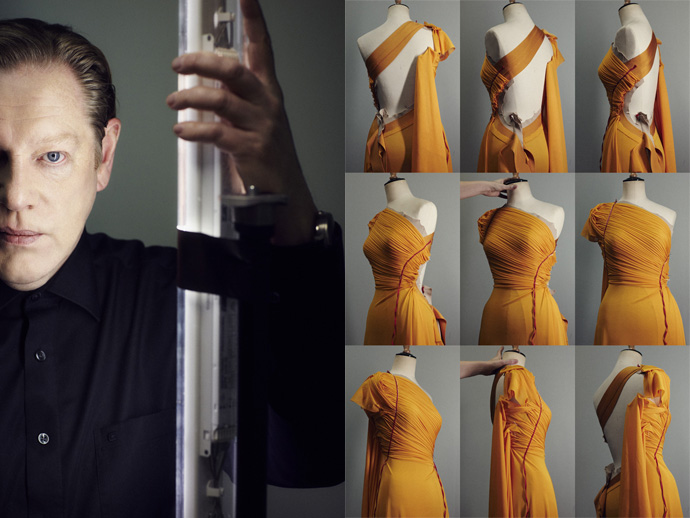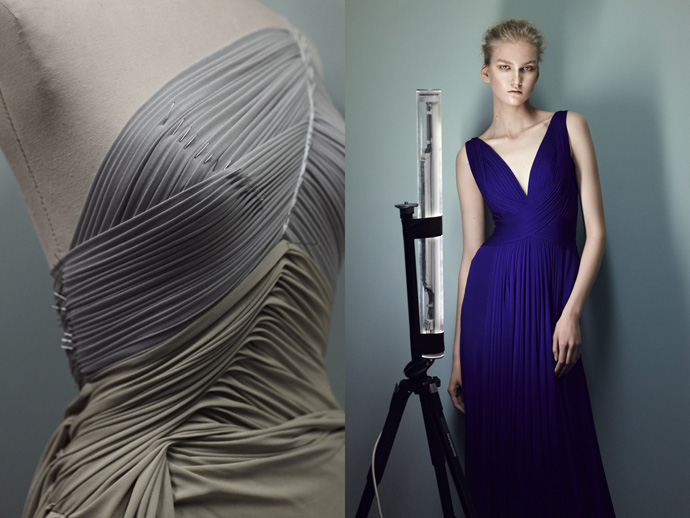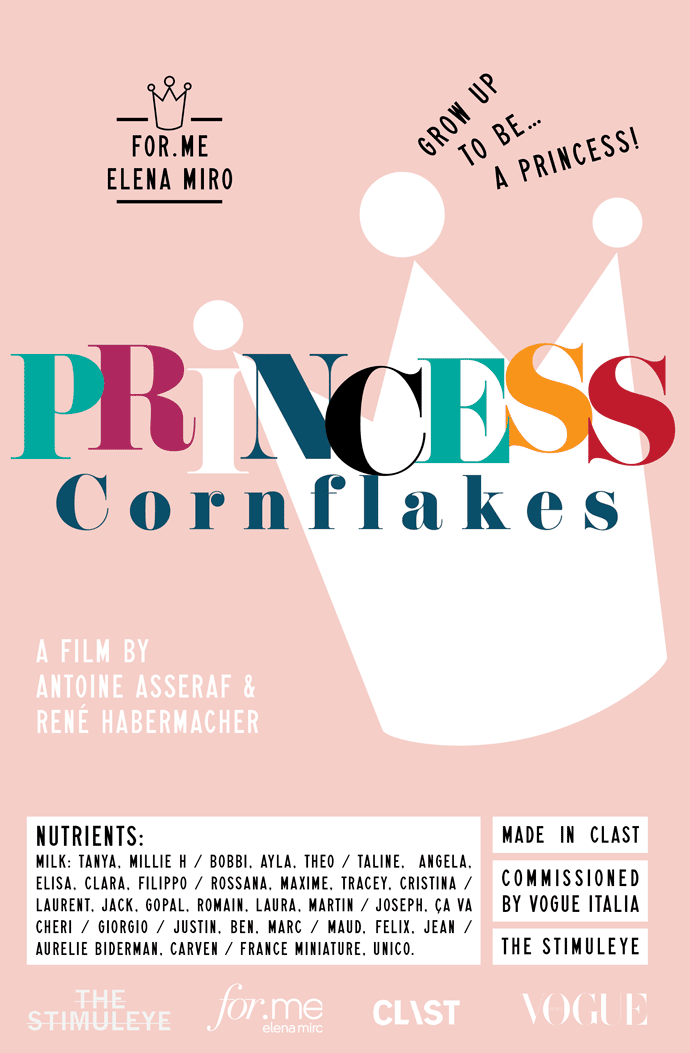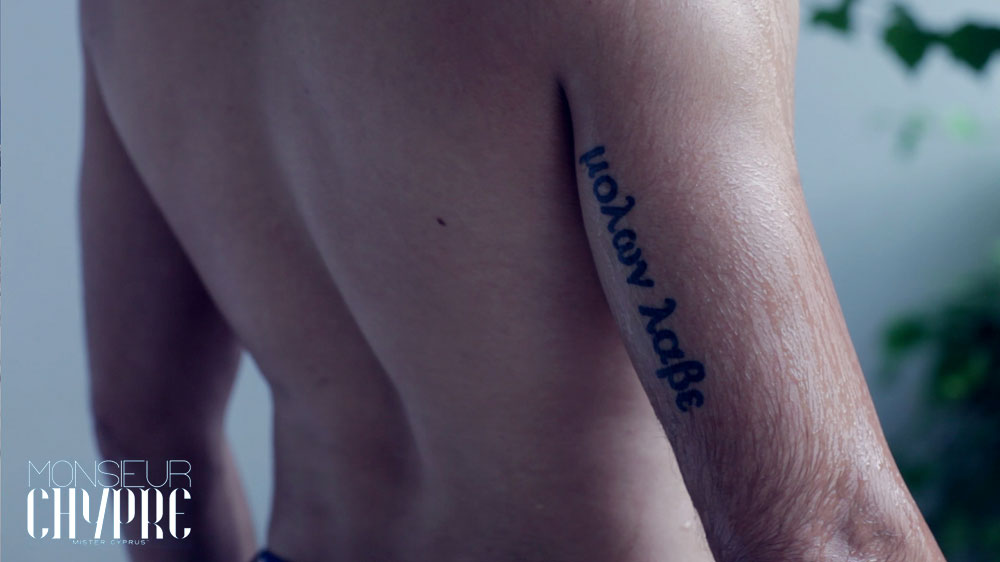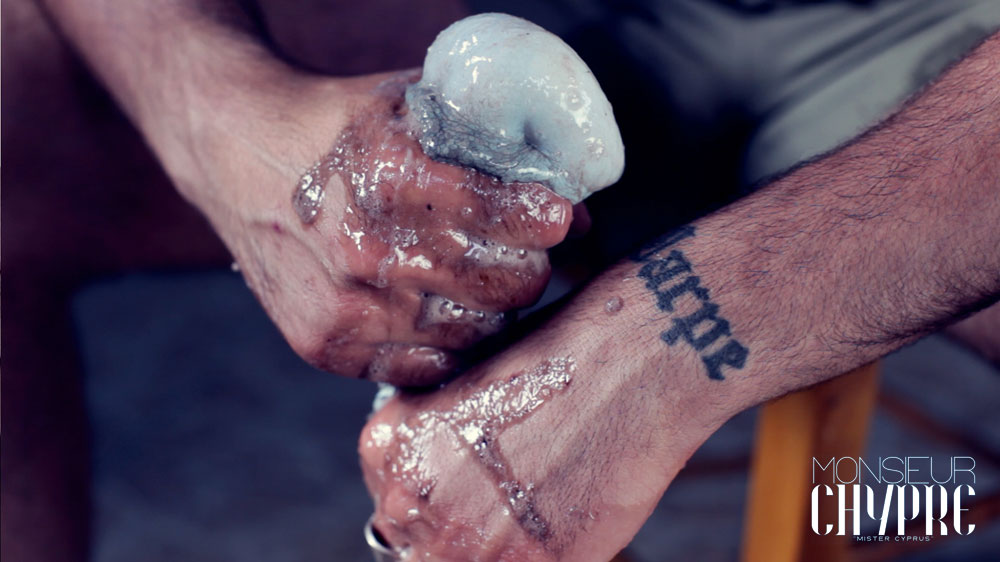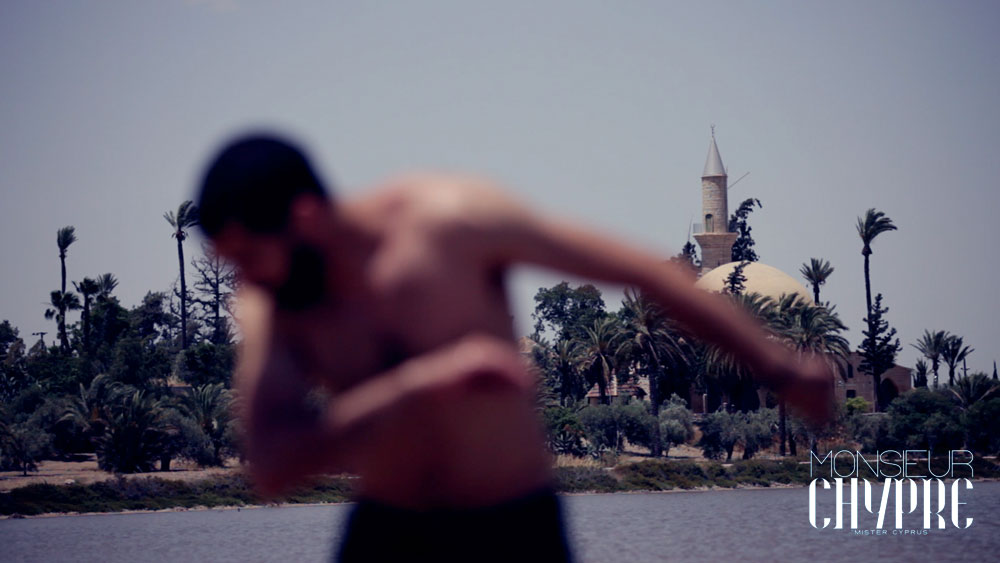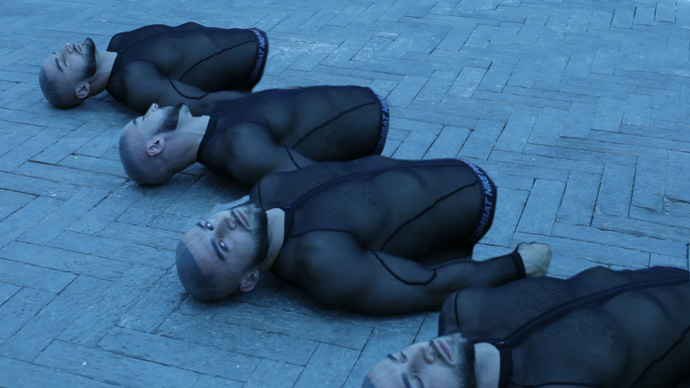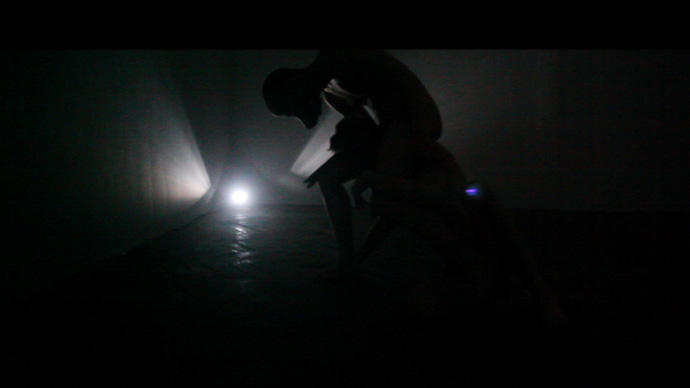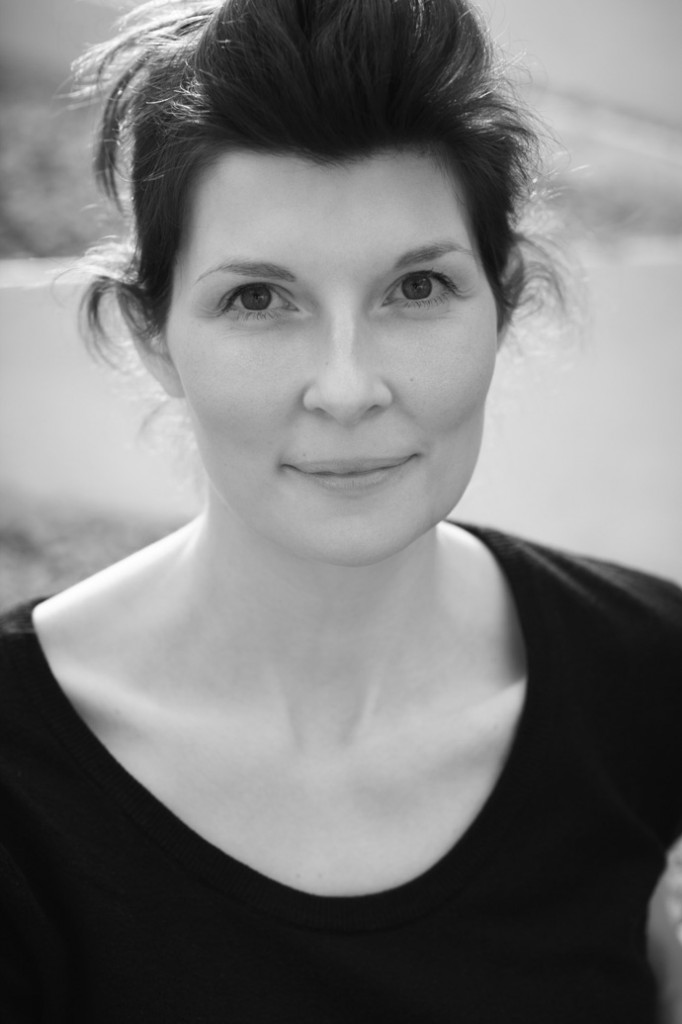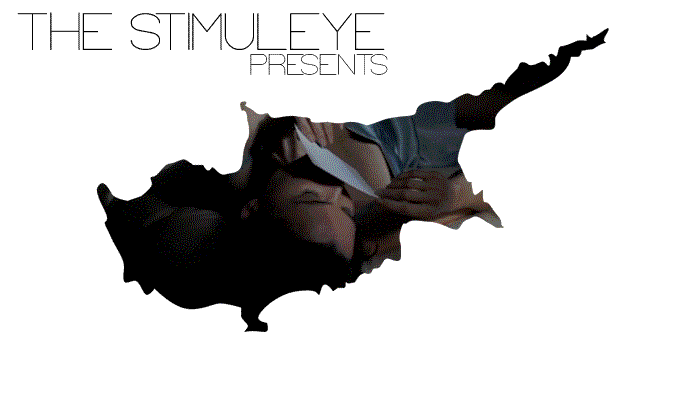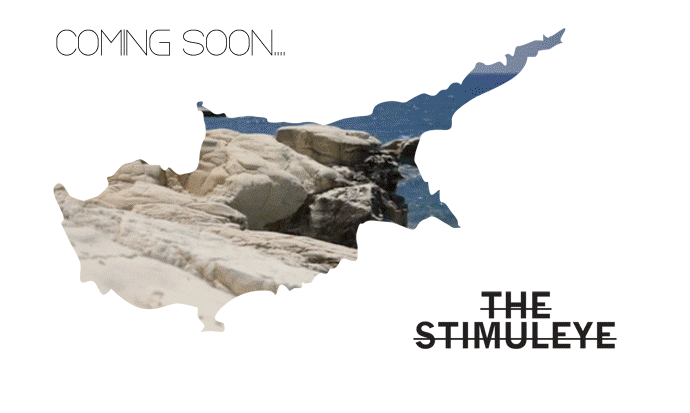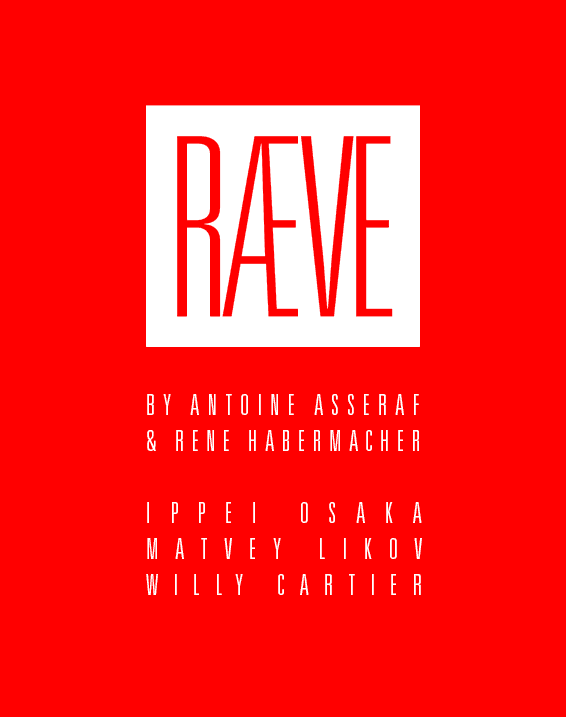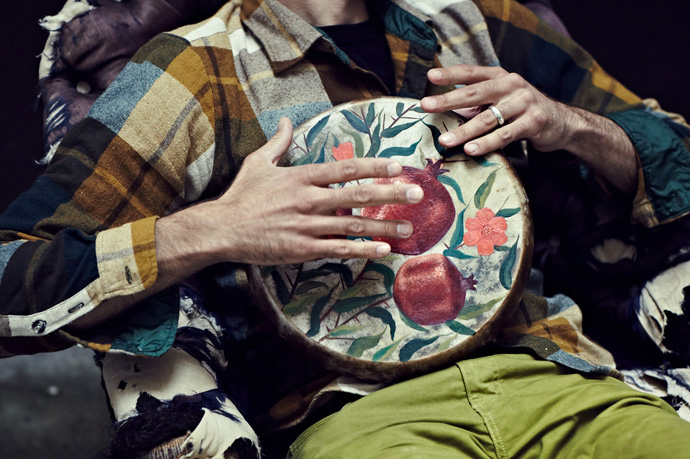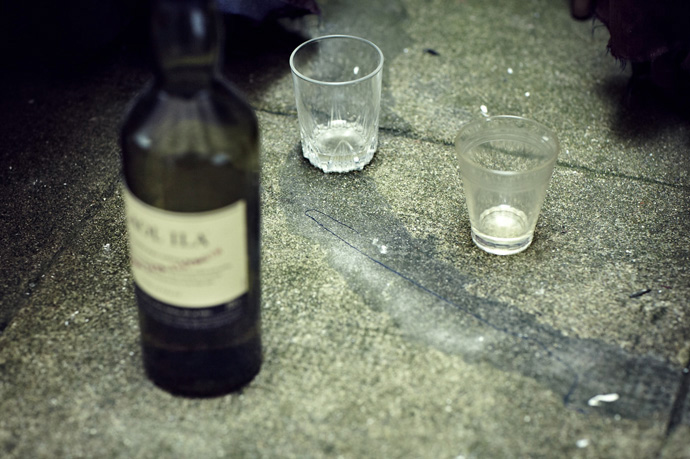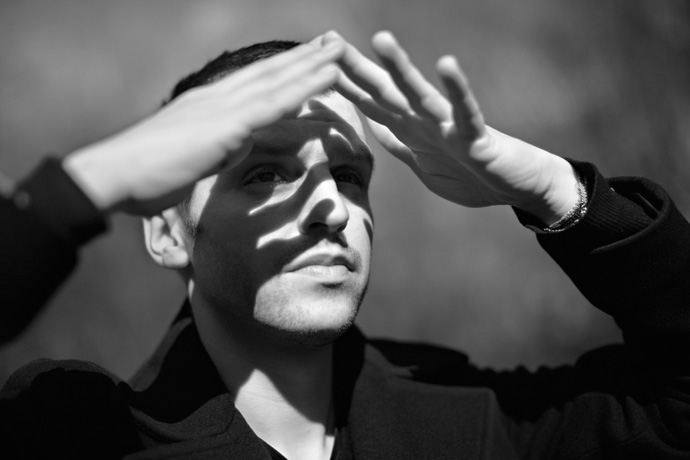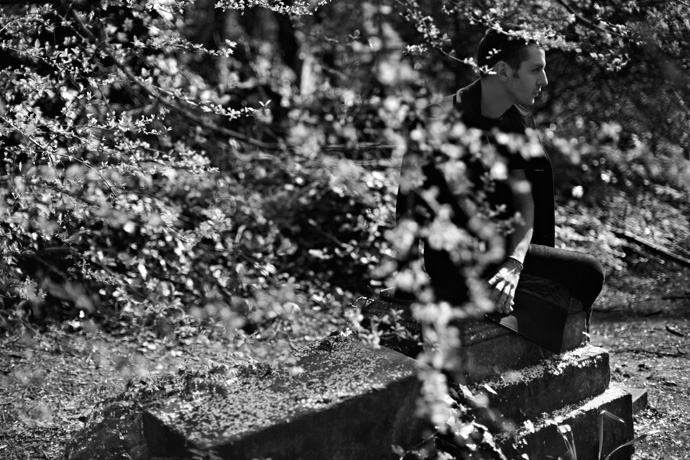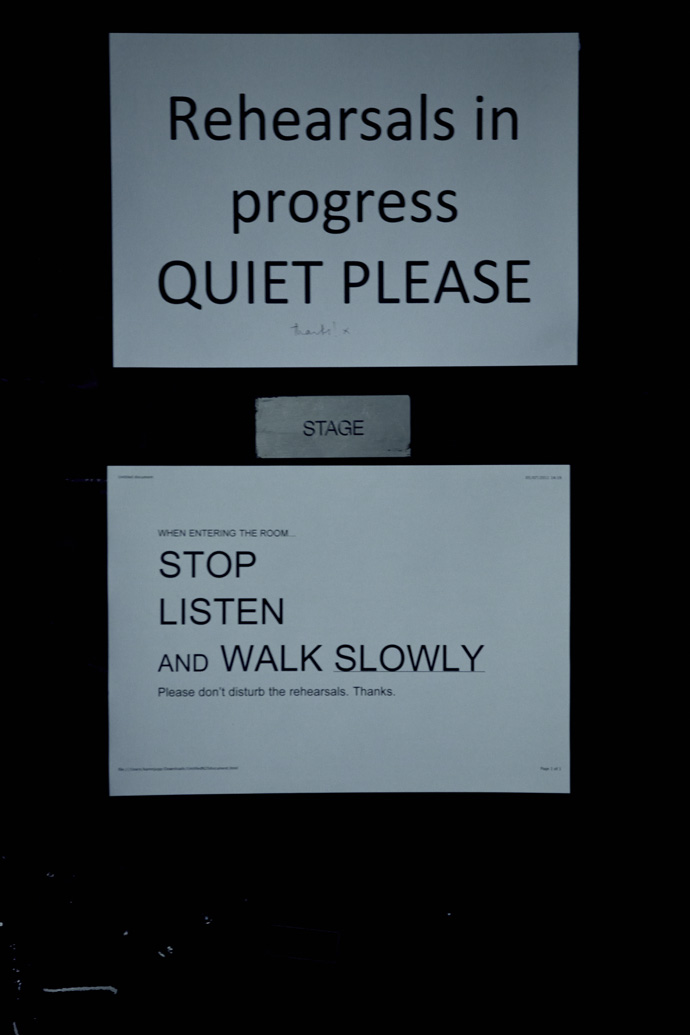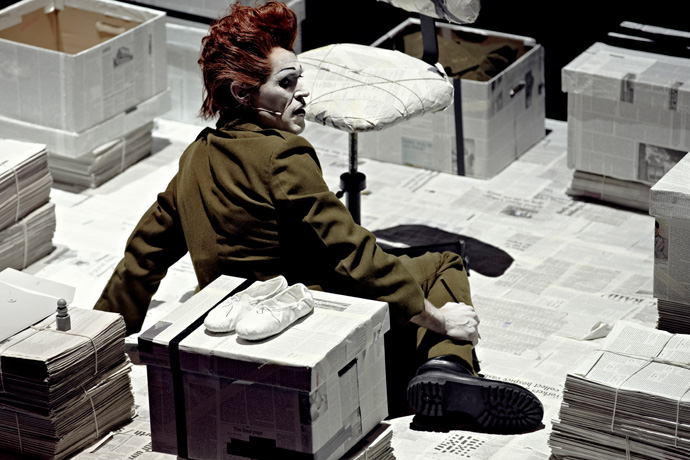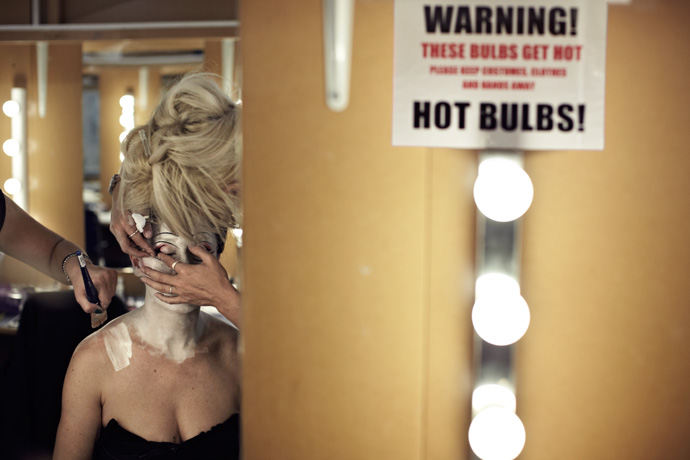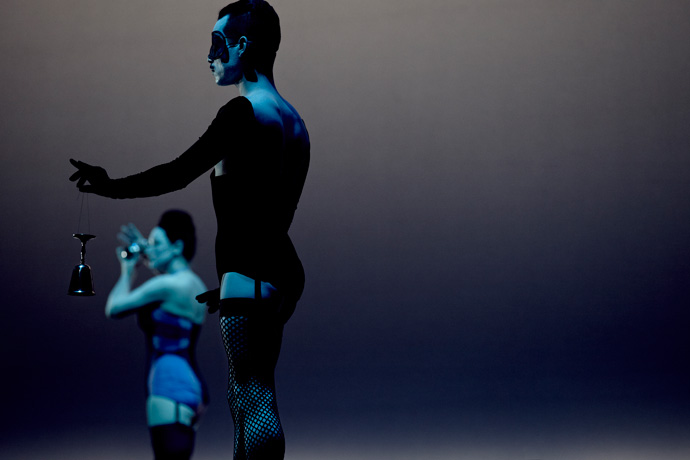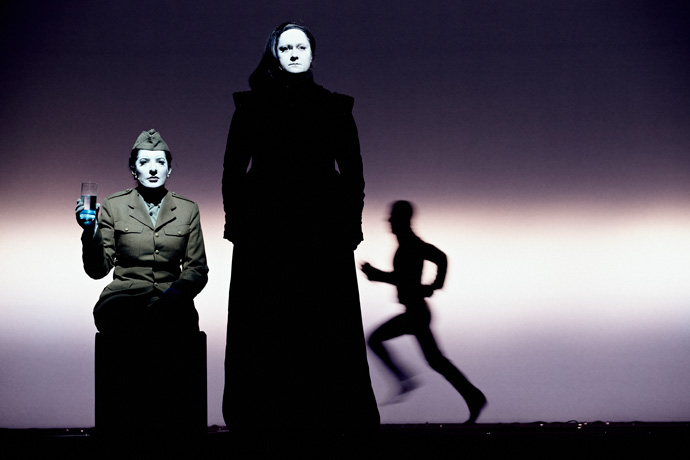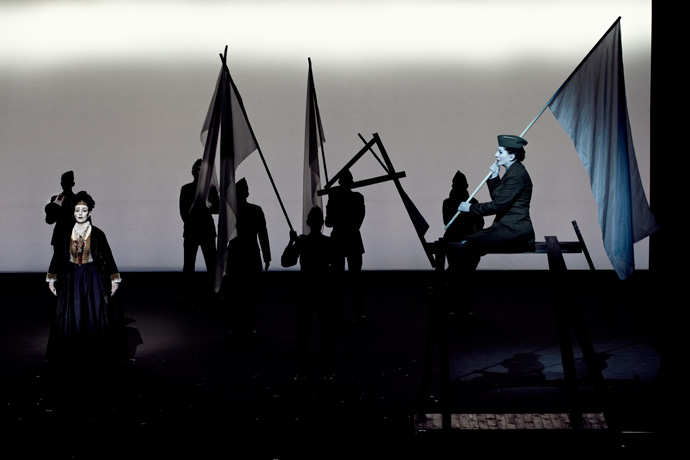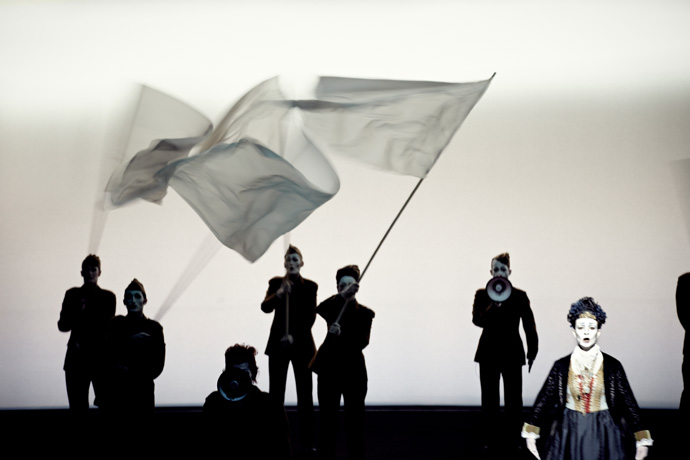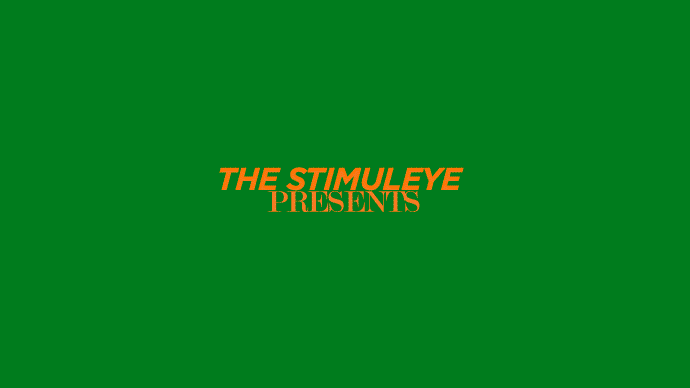-

Kostas Murkudis
-Putting Kostas Murkudis, with his East German utilitarian approach, at the helm of Closed jeans, a brand defined by the relationship between function and form, is a match in heaven, in a time where the initial idea of fashion is caught between mass production and the arbitrary grip of luxury-obsessed conglomerates.
They each bring their own interesting history and their associations to big names to a collaboration very much anchored in the “now” – on one side, Marithé and François Girbaud, who founded Closed in the 70’s, and on the other, Helmut Lang, with whom Murkudis worked during the label’s early and formative years, though both brand and designer exist in their own right.
For women’s fashion week in September, Closed will open its first flagship store in Paris.
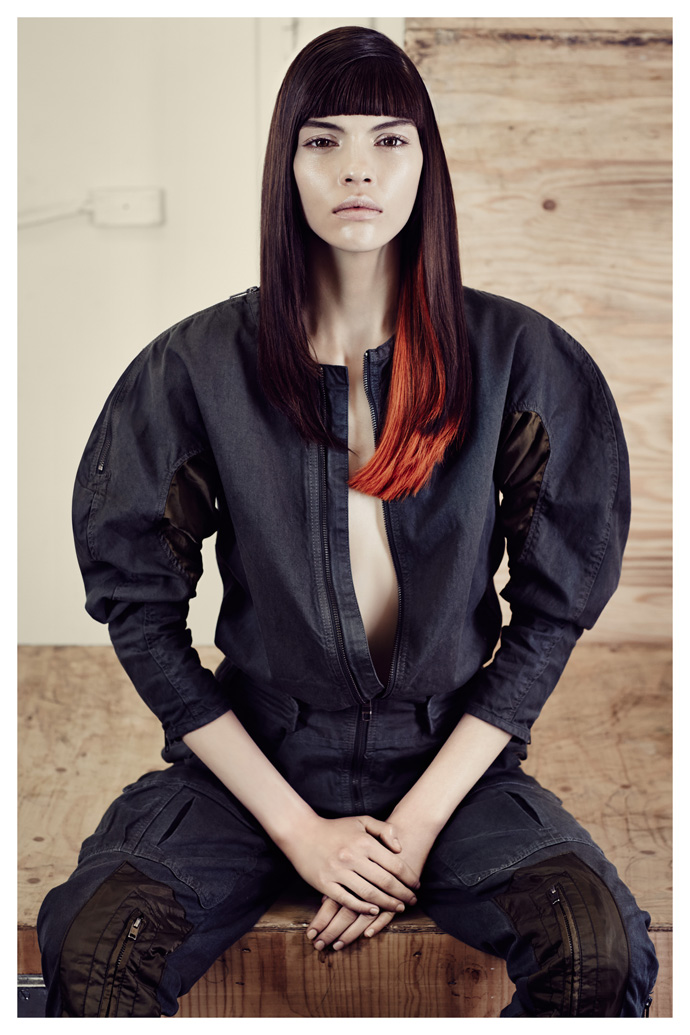
Overall "Illusion" from the FW 13/14 collection by Kostas Murkudis for Closed Jeans. Photography by René Habermacher
René Habermacher: When I heard you’d be working for Closed jeans, I thought it made great sense with your approach – sustainability, resistance, utilitarianism and uniformity are expressions that come to mind when thinking of your work, and all of these seem to be relevant in the context of jeanswear.
KM: I grew up in the DDR (German Democratic Republic), in East Germany, so these are surely aspects of my work that I value and are part of my professional ethos that I will follow up into the future. It’s my contribution, to make it accessible to more people than for example with my own brand.
I always had “two hearts beating in my chest”: one more poetic, free of necessities, and the other that is more about durability and functionality everyday. I always loved the approach of the Bauhaus, it is very important to me. But I really do love both aspects. Now with my new mission at Closed, I can really apply everything you described, I have all tools and a fantastic team I love working with.
For me this is the perfect balance between the two brands.Whereas with my own brand, my mini-label that I call my laboratory, I don’t have to think about whether the piece is really durable, has the right pocket or whatever. I just can do projects important to me, which do not necessarily have anything to do with fashion. For example recently I have worked with a royal glass manufactory in Munich, Lobmeyr, that usually do stuff like church windows etc. I think there are so many possibilities and I am very curious for new challenges.
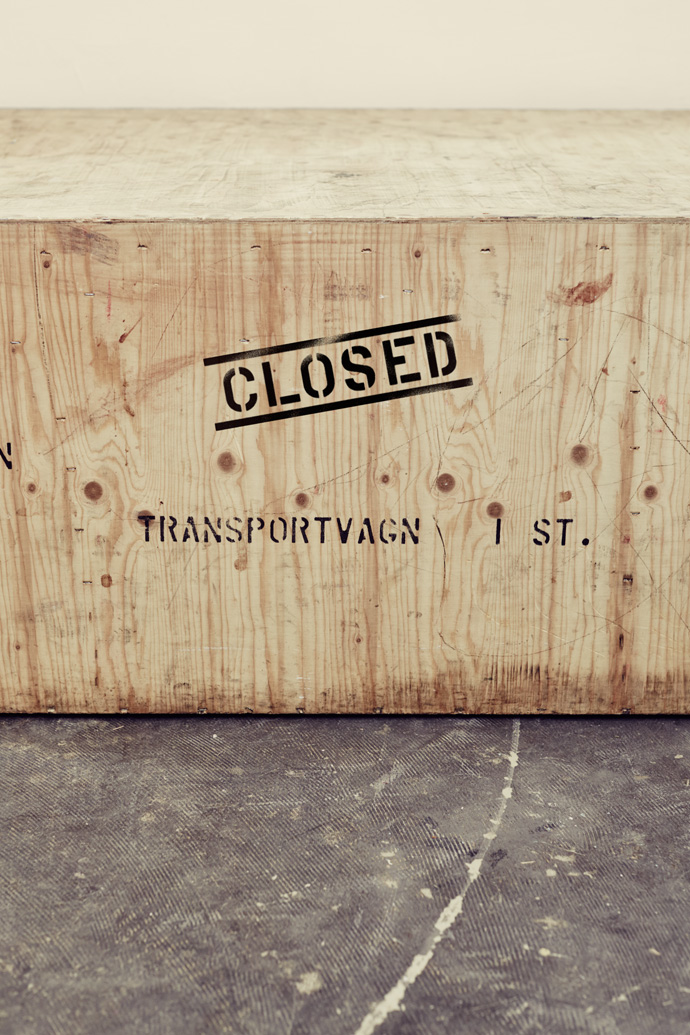
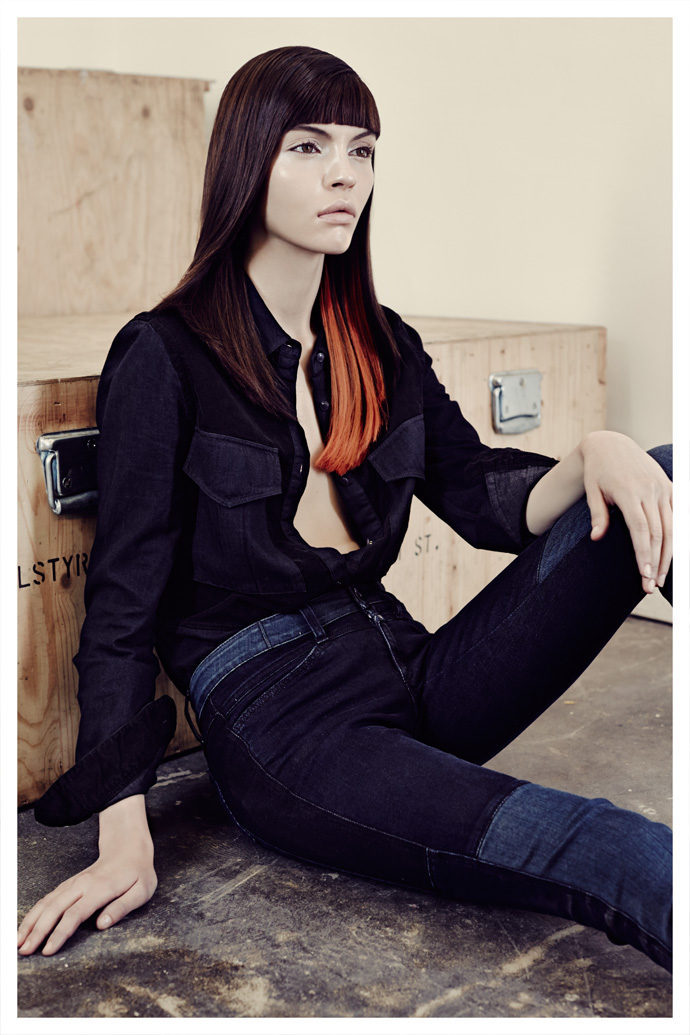
Shirt and Jeans FW 13/14 Kostas Murkudis for Closed. Photography by René Habermacher
RH: You’re working for quite some time in fashion now. When you started, fashion was something different: in the 90’s, fashion still had a socio-cultural context, was a compass and expressive part of movements. Today it’s different, its not really that a social movement expresses anything through dressing codes.
KM: That’s true and has obviously social, socio-political, and sociological causes. There is very little happening that could tempt for re-orientation. I do really hope that finally something will be happening. Or has it started already? When you look what is going on in Brasil, or Turkey, in countries where I would not have expected that this kind of movement would be surfacing.
The situations in Greece, Portugal or Spain, France and possibly soon England, don’t look so great either, but something is happening and I am hoping very much that this will spread across cultures and regions, and maybe create the necessity to develop new codes. Obviously they have to develop themselves, we as designers can’t help it.
RH: For quite a while fashion hasn’t had a cultural value of progress, it has become more a simple “garment industry.”
KM: That’s right. Fashion is not allowed to be like this anymore. It’s the very capitalist approach to define success only through growth, to which the big houses are forced to: generating work, circulate money, this and that – it’s not about content at all. In fact it is even arbitrary who designs. It is the brand with its margin that is in focus.
If that’s what’s thriving in society, fashion can only be its image.On the other hand, design has become another aspect – let’s take an example like the iPod, or the iPhone and what has been generated here: a simplicity, practicability and a beauty of objects that have not been produced like this in a while.
It’s not about developing funky variants and decorations, but to work continuously on refinement and improvement with every generation, which I believe impacts our everyday culture. Even kids are not seduced to just buy something new because there are some new crazy buttons added. And you don’t have the desire to buy a jeans with 25 embroideries and absurd stitchings on the butt that are completely pointless. This pointlessness, this battle of material is not working anymore.
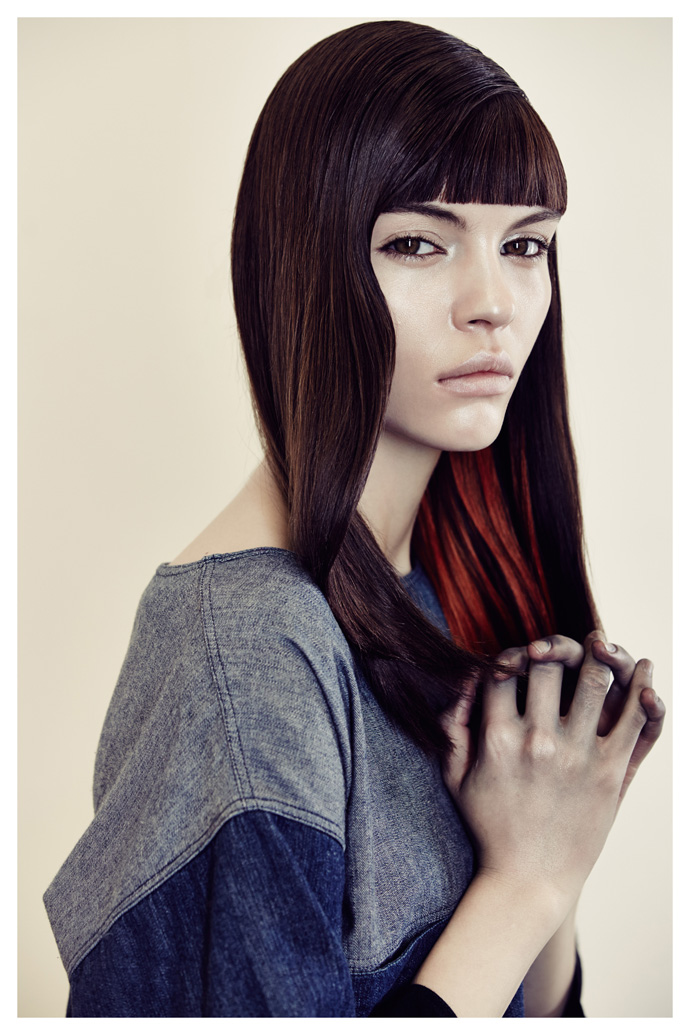
Jeans dress FW 13/14 Kostas Murkudis for Closed. Photography by René Habermacher „First there is nothing, then a deep void and finally a blue depth.“
Yves Klein.(Leitmotif for the colour codes to the SKYWALK CAPSULE COLLECTION No.1)
For example my brother Andreas, who owns a concept store in Berlin, he affords himself the luxury to buy only what he thinks is really good, regardless of the label. He buys what is up-to-date in his eyes. He was totally shocked about the pricing for which it’s possible to get good design that is on top politically correct produced in Italy: good quality fondly fabricated from great fabric. Not that this is world changing…
RH: But democratic?
KM: Democratic in a positive way. I didn’t really want to use that word. When my brother saw the Skywalk Capsule Collection in Berlin, he went to order straight away several looks from the FW collection, saying: “wow, this is really cheap- and so cool, but really cheap”.
Of course we have the same approach, maybe also because we grew up in the DDR: for us longevity or functionality and beauty don’t have to cancel each other out.RH: What is your relationship to glamour?
KM: I try to stay remote, but sometimes have to make compromises. My relationship is rather an aversion. I come from a very simple background and it really does not touch me to hear “who was where with who wearing what”, that doesn’t interest me.
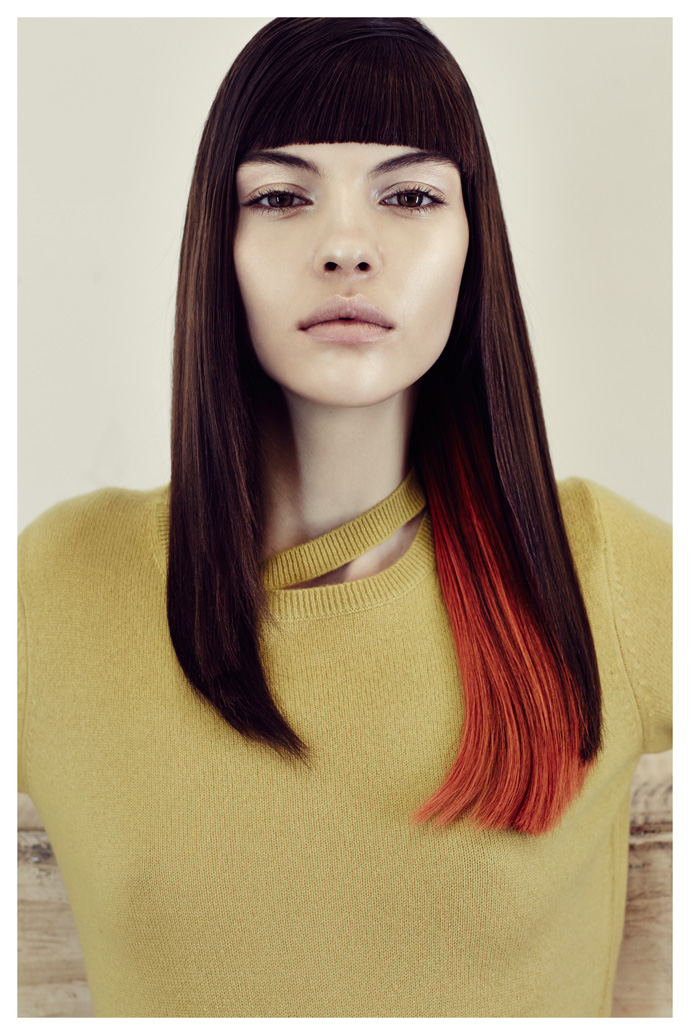
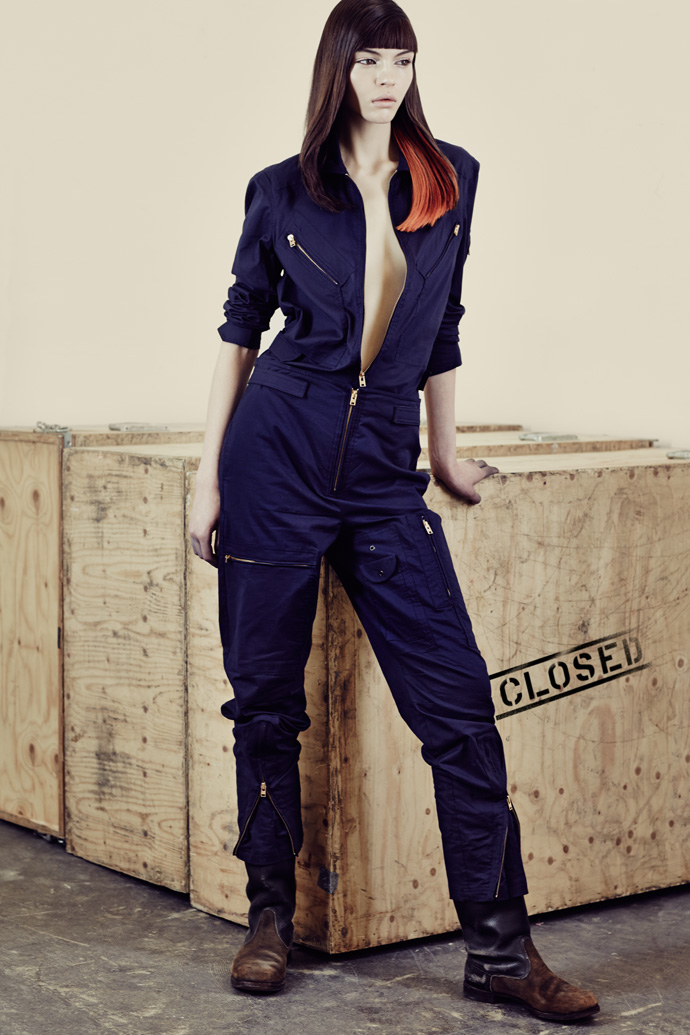
Right Side two pieces from the SKYWALK CAPSULE COLLECTION: Murkudis took inspiration from a vintage aviator suit, using the cuts and details to create a minimal wardrobe: a shirt, a blouson and pants for men and women. Boots: vintage DDR army. Photography by René Habermacher
„Earth is a delicate shade of blue“
Yuri Gagarin (Leitmotif for the colour codes to the SKYWALK CAPSULE COLLECTION No.1)
RH: Tell me a little more about the Skywalk Capsule Collection…
KM: The idea was based on the desire to bring the brand back to an international level, and the one of the brands defining aspects: the idea of unisex, that I thought very interesting and gave me also the possibility to explore menswear more, find a different angle and define their image more sharply.
Because the project was a very small range, I had to stay quite precise as well in material as colour and design, but it was the first time that I had the chance to show pieces that one actually can afford. If you look at the product, it appears at first sight quite minimal, even though its technology is actually very complex, which is something I wanted to put forward as well.
But because of all this, it was quite obvious to me to give the collection somewhat of a poetic moment.
RH: Yet here is also a practical thought behind it?
KM: Of course. It was to show the brand’s core, and a product that should function in the everyday life over long time.
Apart from that, the beauty of a product becomes apparent in its use, becomes part of our lives and our bodies. That’s what makes a jeans. It only becomes your jeans, and a great one, when it deforms on your own body, through use, through touch, through creases, through whatever. It becomes part of your being. That makes it truly beautiful when it is beautiful.
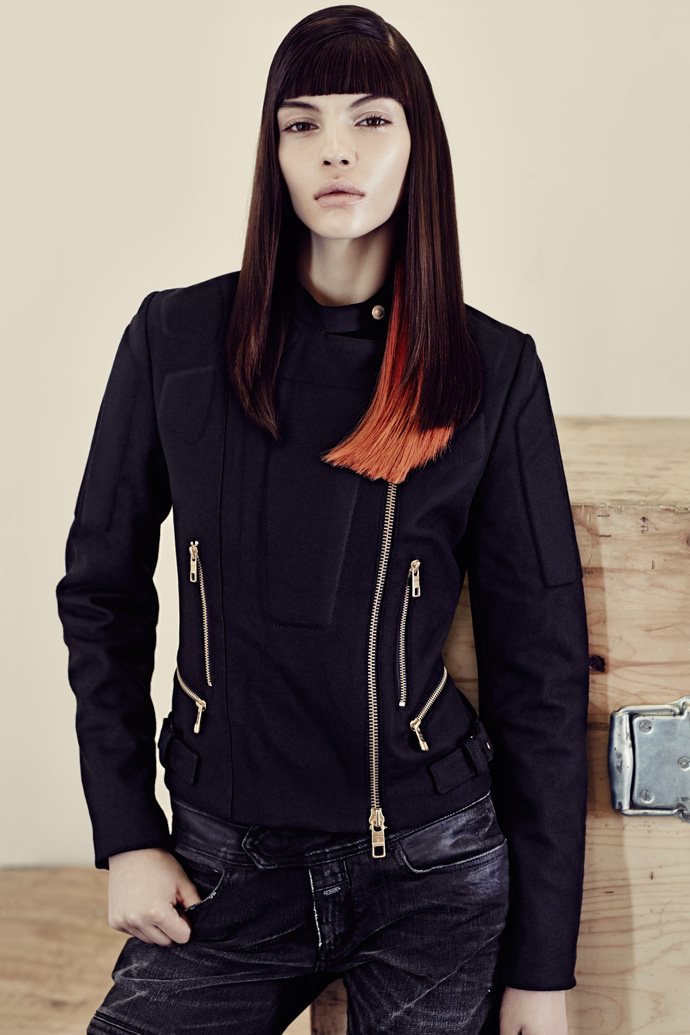
Felt Perfecto Jacket and Jeans, both FW 13/14 Costas Murkudis for Closed. Photography by René Habermacher
RH: With a clientele living in the most various meteorological conditions, does it really make sense today to produce season-oriented collections?
KM: This is a totally legitimate question. Also as we know that the big producers often deliver new products up to twelve times a year.
So for smaller brands it is indeed worth considering to orient themselves differently because they have no chance to stand up against this moloch of an industry.In a way we are overtaking ourselves with everything: when the sales start the season hasn’t even really begun, there is a resort collection, a pre-collection and a in-between collection- that is all a bit absurd. I see that with my brother, who says “I don’t need a pre-collection that is delivered in November when its perhaps snowing here and -30 celsius”. That makes no sense.
On the other side I am bound to the cycles of the classic way of producing 4 collections a year.
I think the problematics are there for everyone, but no one has yet found an ultimate solution, or takes the risk to say ‘I am going to position myself entirely new in this context.’RH: In your case do you do a presentation, or are you considering eventually a show?
KM: Right now this is not a real topic for us. Maybe next year or after that, it really depends on how we develop and what our expansion will bring.
RH: The one thing I find puzzling is with all the coverage on the shows, once the products are in the shops, you are already bored of them.
KM: I totally agree with you that three weeks after the shows you vaguely remember and when the products are delivered to the shops you practically forgot about it all. This wish and desire to own the pieces immediately is fading in that period.
But that’s what you have Zara for: they deliver within three weeks after the show a dampened version for those who can’t wait at all and never really got it anyway: those will buy the cheap copy (laughs).
By then the others just saw the newest collections and are wondering that they have ever liked the current one…. I look at this smiling.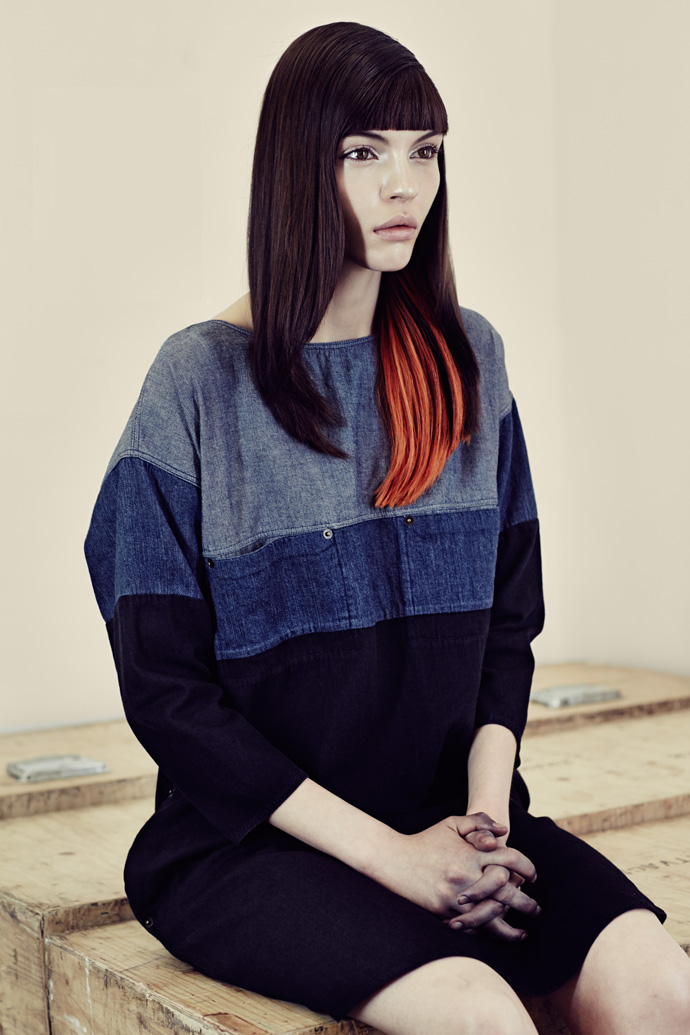
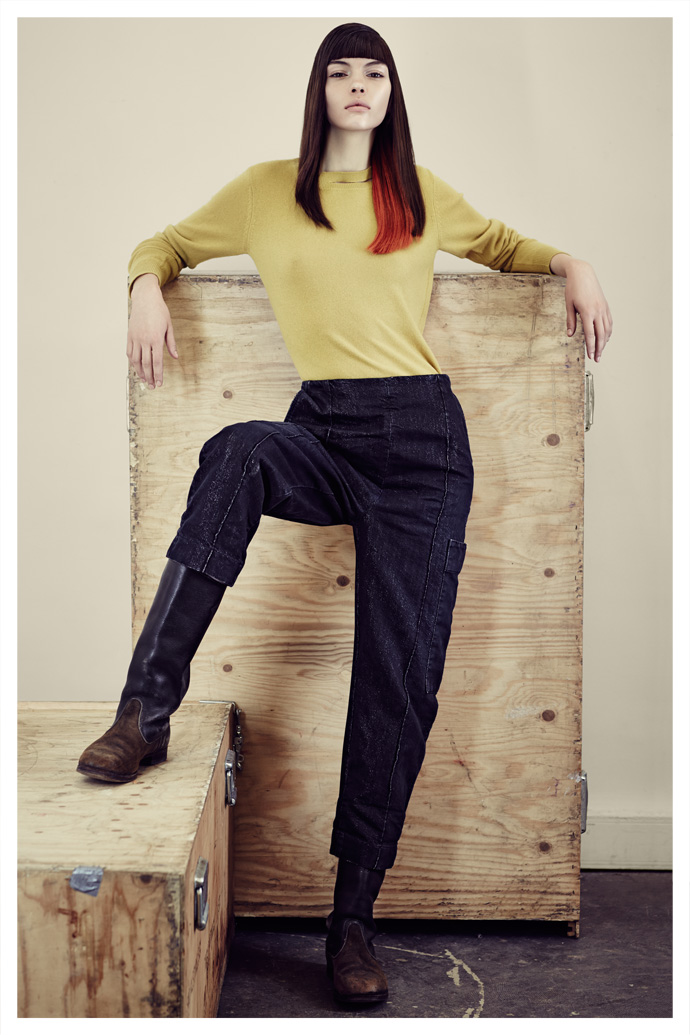
Left: Jeans dress, Right: Split neck pullover and Jeans, all FW 13/14 Kostas Murkudis for Closed. Boots: vintage DDR army. Photography by René Habermacher
RH: You do have a special relationship with Japan, is that right?
KM: Yes, when I was a small kid, I started to do judo. I had a fantastic teacher that I absolutely worshipped as a living hero.
I was excited to wear these suits, the belts. The scent of the mats, the bows, this outlandish language had fascinated me. To me it was of course an escape from my Greek moulded DDR prosaicness and the pressure to perform. I did virtually absorb all these words, ceremonies and preserve within for years.When I started to be interested in the arts I read a biography of Yves Klein, and realised he was a judo master like me, and eventually lived in Japan. I think his work was to some degree influenced by Japanese moments, in their simplicity and splendidness. This has really accompanied me ever since. The Bauhaus would have been unthinkable without the Japanese influence. In many aspects this influence has developed with me, the desire towards the exotic but as well the austere, the sophistication and the celebrated. The handling of colours, surface but also the poetic moments and the spiritual aspects behind.
I celebrated plenty successes in Japan and grew with these, so I owe a lot to the Japanese. We found each other. I was always fascinated and excited about it, to the point that Gordon, one of the owners of Closed, and I started to take Japanese lessons.
This hunger is not satisfied yet- and will always find itself in my work again.
RH: What is the last thing that stimulated you?
KM: I was very inspired by the exhibition of Martin Kippenberger: the incredible freedom of a man in dealing with the most different tools. I have great respect for his state of mind that moved me to tears of joy. I haven’t laughed that much for a while. All my senses had been spurred through this.
This interview and photographs are a Stimuleye exclusive
interview and photography RENÉ HABERMACHER
fashion editor SUZANNE VON AICHINGER
hair JONATHAN GEIMON @ AIRPORT AGENCY using Bumble and Bumble
make up MIN KIM @ AIRPORT AGENCY
model KATE B @ NEXT MODELS
thank you VERSAE VANNI @ NEXT PARIS
and LIBRAIRIE Ofr PARIS for your support00 -

monsieur hervé: ready to wear campaign
-“The story of the bandage dress is important as a fact my work storyline.”
– Hervé Leroux, AKA Monsieur Hervé LégerFor his first campaign, for the Fall/Winter 2013-14, Hervé Leroux chose to collaborate with The Stimuleye for creative direction: photographer René Habermacher in tandem with stylist and fashion muse Suzanne von Aichinger, bringing forward the modernity in Hervé’s timeless designs.
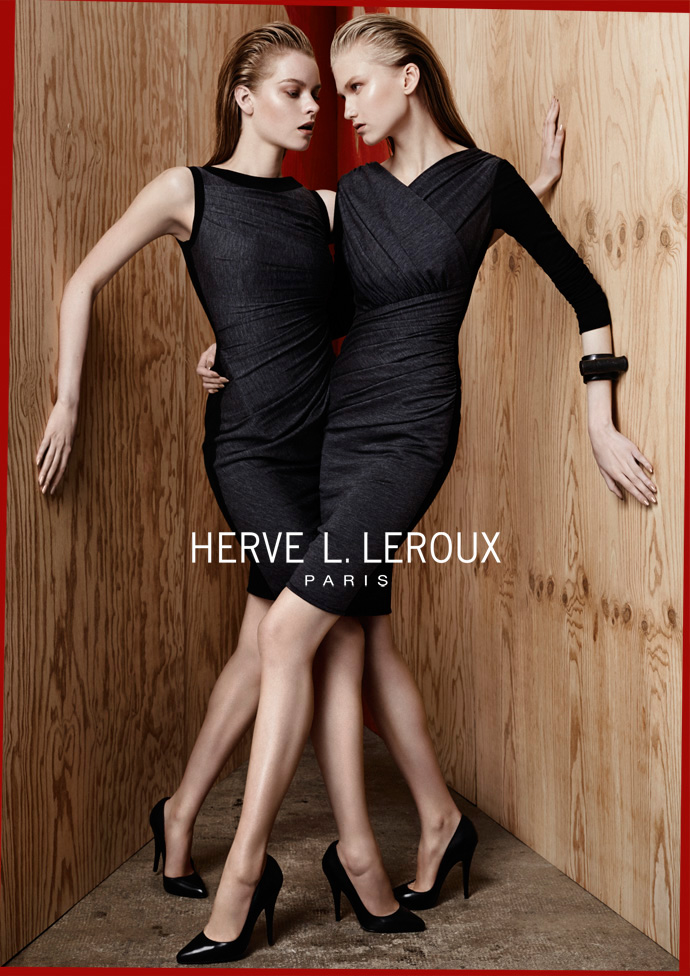 Gwen Loos and Anna Martynova intertwined in slate and black draped front dresses by Hervé Leroux FW2013.
Photography by René Habermacher
Gwen Loos and Anna Martynova intertwined in slate and black draped front dresses by Hervé Leroux FW2013.
Photography by René HabermacherAs you’ve read during our interview and couture atelier visit, Hervé Leroux, born Hervé Léger, is known for his talent for creating garments using traditional tailoring techniques while taking full advantage of developments in silhouette contraction-embracing modern fabrics.
Monsieur Hervé worked as a hairstylist and a milliner before Karl Lagerfeld offered him a collaboration with Fendi, and then Chanel, as a senior assistant. Soon after opening its doors in 1985, Maison Hervé Léger became internationally famous for pioneering the bandage dresses that were about techniques of reforming the body, focusing on the three key words for femininity: curves, waist and form. The “recipe for the 90’s”, as Suzy Menkes once wrote in the Herald Tribune, was about curve-cleaving elastic bandages and a high-octane technique that defied tradition, an effect which Hervé achieved by molding his fabric to the female form instead of draping and cutting it.
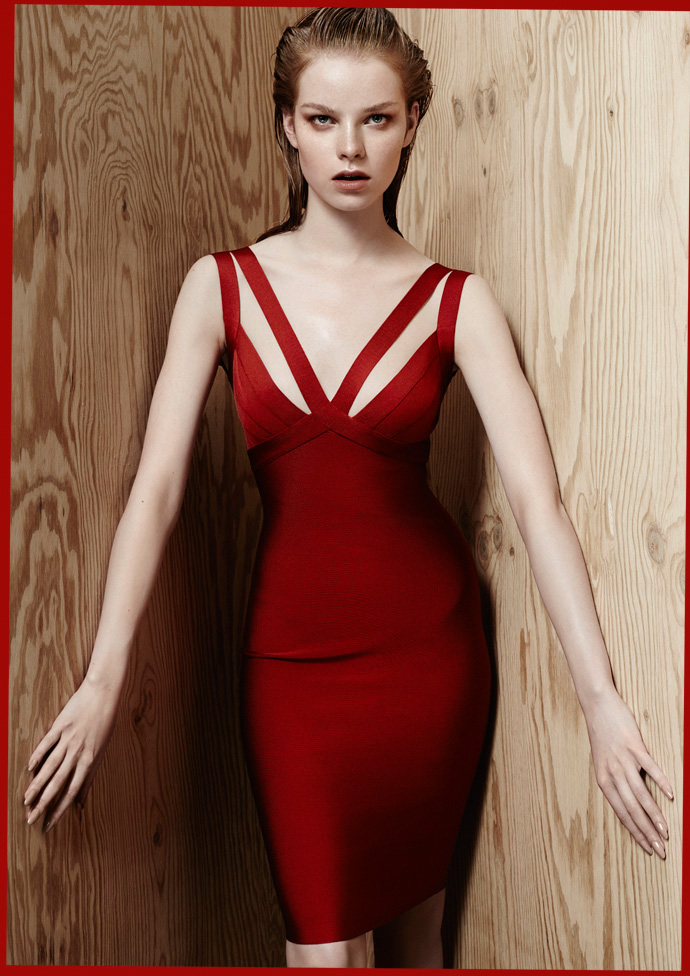
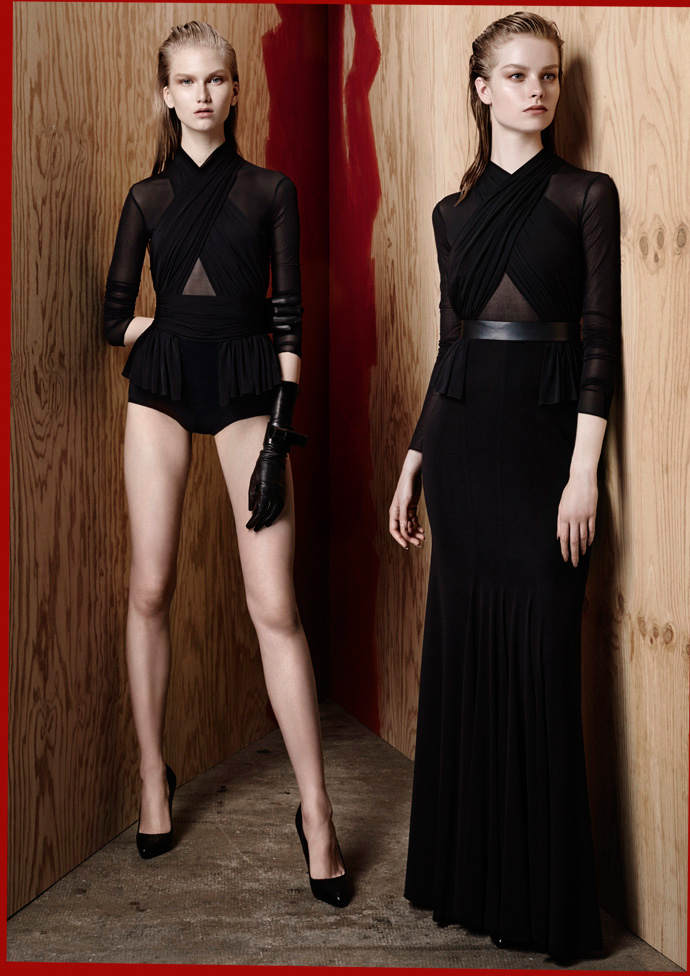 Left side: Gwen wearing a ruby deep double V-neck viscose dress recalling Hervé's iconic bandage dresses.
Right side: criss cross draped black silk jersey pieces. Photos by René Habermacher
Left side: Gwen wearing a ruby deep double V-neck viscose dress recalling Hervé's iconic bandage dresses.
Right side: criss cross draped black silk jersey pieces. Photos by René HabermacherAfter separating from the company which bears his name and adopting the name Hervé Leroux, as suggested by Karl Lagerfeld, Monsieur Hervé recalibrated his vision of glamour, towards a modern sensuality crafted by the hands of a real artisan. Every piece of both the Ready-To-Wear and the Haute Couture collections is created by Hervé’s own hands in his new atelier on 32 rue Jacob.
The Hervé Leroux Fall/Winter 2013-2014 Ready-To-Wear collection is about sober, soaring elegance, reflected on 50 hand-made pieces. For Monsieur Hervé, it is crucial that each piece be as specific and precise as a painting by Pierre Soulages, an important influence on the designer.
“It’s in doing that I can find what I am looking for.”
– Pierre SoulagesThe cut is soft, sensually embracing the female curves, revealing the secrets of the master for both of his obsessions. The fabric is draped only to create luxurious body landscapes on his monochrome canvases, paying homage to the morphology of the body.
Hervé creates a collection that can be referred to as a “second skin” – a fluid, easy-to-move silhouette, which slides on the body, becoming at once feminine and powerful.
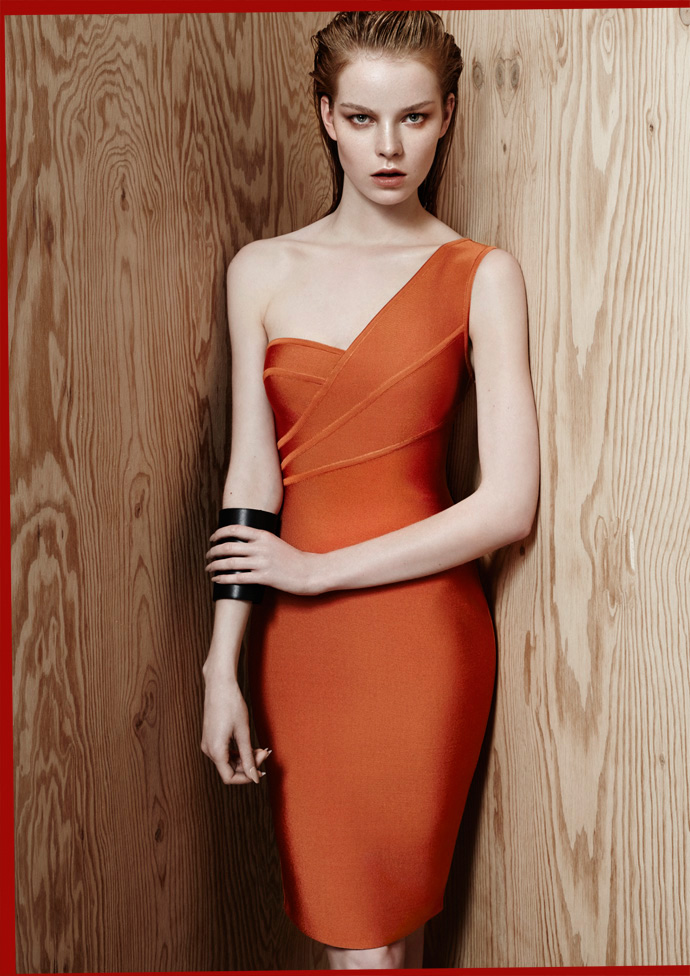 Gwen sports a Pumpkin viscose aerodynamic dress. Photo by René Habermacher
Gwen sports a Pumpkin viscose aerodynamic dress. Photo by René HabermacherCREDITS
Creative Direction – The Stimuleye
Photography – René Habermacher
Styling – Suzanne von Aichinger
Jewelry – Fabien Ifires
Hair – Panagiotis Papandrianos
Make-up – Yannis Siskos
Manucure – Yumi Toyama
Models – Anna Martynova & Gwen Loos – NEXT
Styling Assistant – Chafik Cheriet
First Assistant Light – Laurent Pascot
Capture Assistant – Franck Aubert
Retouching – Dimitris Rigas
Text – Filep Motwary
Art Direction – Antoine AsserafThank you Versae Vanni
-

THE OPPOSITE OF GLOSSY
-“Nobody wants to invade Marseille” claims Rudy Ricciotti,
architect of the MuCEM.And yet everyone is flocking there since the Museum of Civilisations
of Europe & of the Mediterranean, dubbed MuCEM, opened its doors just weeks ago, the first national museum to open in the Phocean city, a project 11 years in the making.Having shot & directed the introductory ad campaign for this new institution, The Stimuleye introduces you to the man who designed it, a man as famous for the fights he picks as the building he designs.
Exclusive photos by René Habermacher.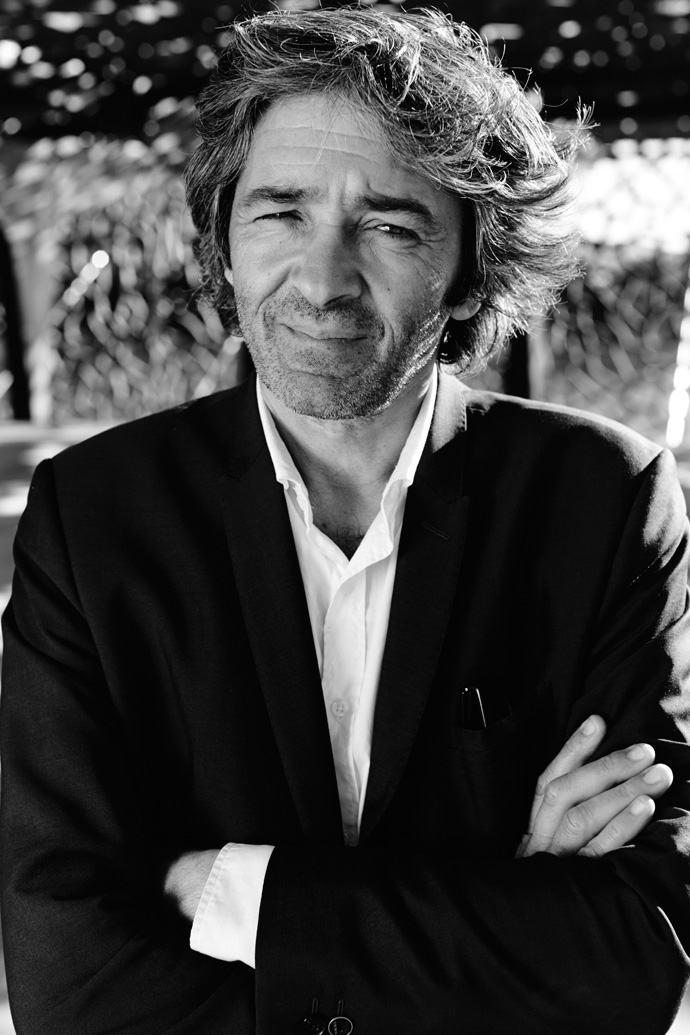 Portrait of architect Rudy Ricciotti by René Habermacher.
Portrait of architect Rudy Ricciotti by René Habermacher.One side is the Fort Saint-Jean, linked to the city by a pedestrian steel bridge. A fort not unlike the Bastille – a bastion to defend Marseille against itself – the Fort Saint-Jean had been closed to the public for centuries.
On the other, also connected by a massive steel bridge, is Ricciotti’s creation, facing the Mediterranean Sea.
Refusing “architectural bling,” Ricciotti chose to have the new building dematerialize itself to complement the Fort Saint-Jean.No reflections – leave it to the sea.
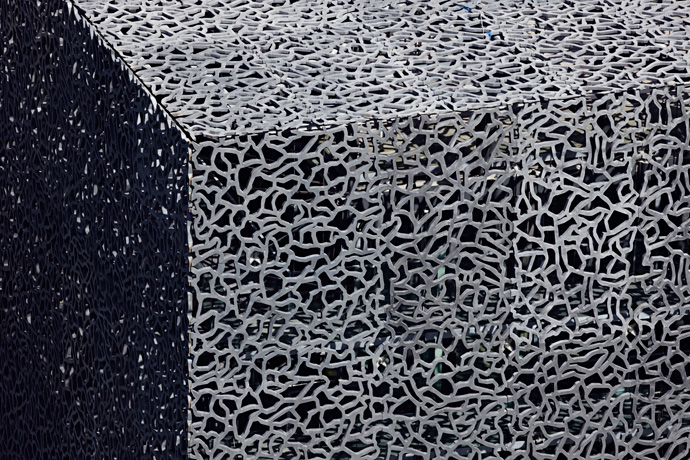
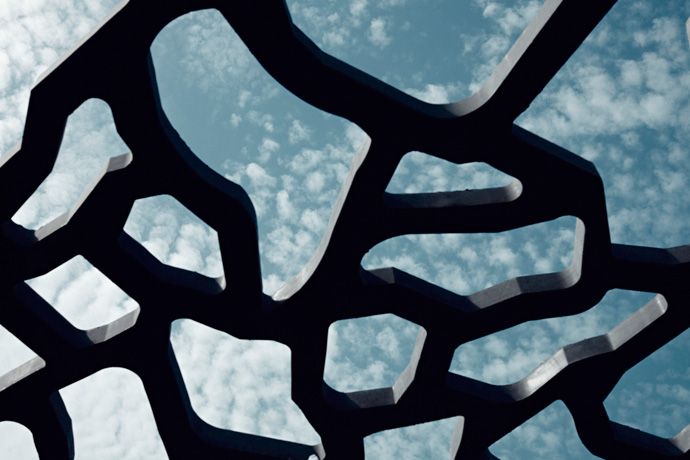
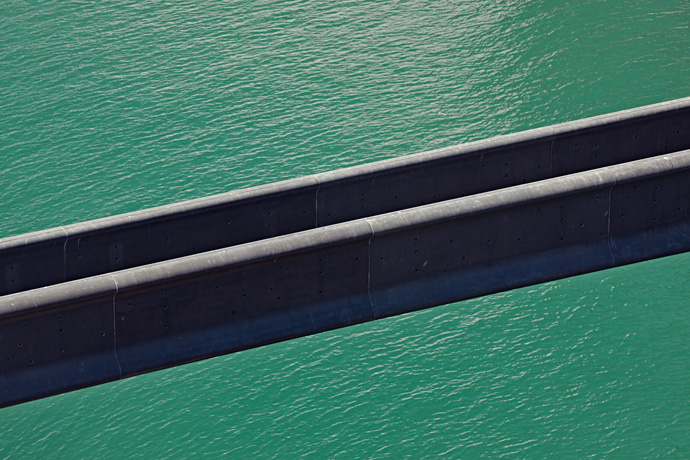
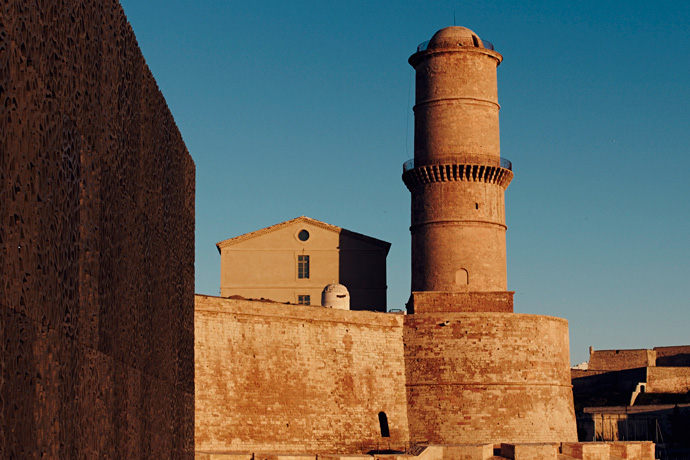 The concrete filigree lace of the MuCEM, a second skin like a screen that allows views, light and air
to pervade the space. Photography by René Habermacher.
The concrete filigree lace of the MuCEM, a second skin like a screen that allows views, light and air
to pervade the space. Photography by René Habermacher.TV spot for the MuCEM's launch, directed by Antoine Asseraf with SayWho and Agence White.
 The MuCEM's a porous monolithic body planted on pier J4 in the Mediterranean sea, connected to the Fort Saint-Jean
with a 115m long slender pathway made of massive cast iron. Photography by René Habermacher.
The MuCEM's a porous monolithic body planted on pier J4 in the Mediterranean sea, connected to the Fort Saint-Jean
with a 115m long slender pathway made of massive cast iron. Photography by René Habermacher.Antoine Asseraf: Can you elaborate on your theory of world being split between two sides, matte and shiny ?
Rudy Ricciotti: Shiny is conceptual distance, reason, power and self-assurance.
Matte is frontal narration, intuition, defeat and regret.
Pick your side… I did.AA: Mediterranean is a concept going beyond “local” but stopping short of “global” — how do you situate yourself, and the building, within that notion ?
RR: The South is a travel certificate, not a birth certificate.
The inhabitants of Munich are more mediterranean than those of Grenoble.
The Valais region in the south of Switzerland more latin than the Vaucluse in the south of France, etc.
The MuCEM is mediterranean through anxiety and existential difficulty.AA: What is your relationship to monumental architecture ?
RR: You are talking to me, you fucked my wife ?
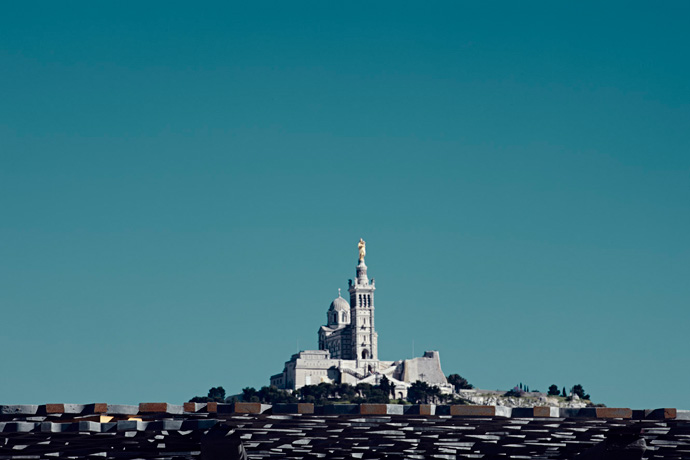
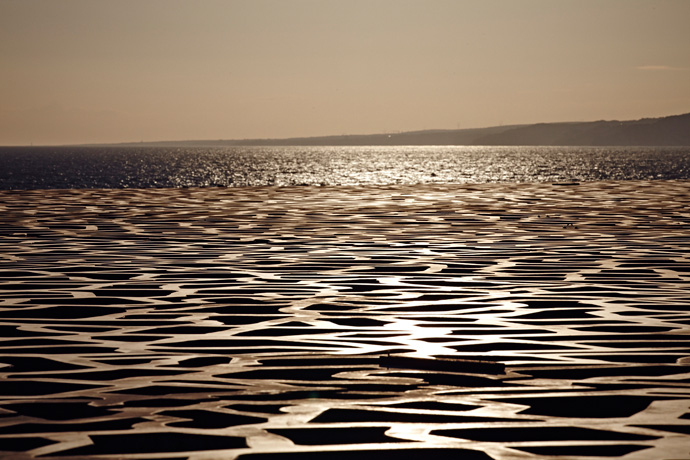
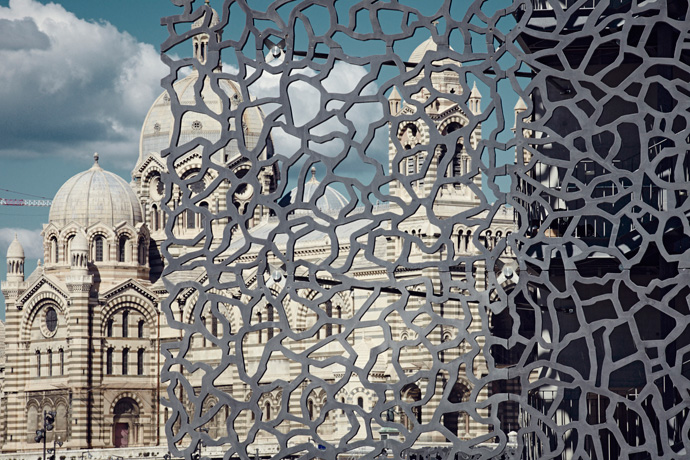
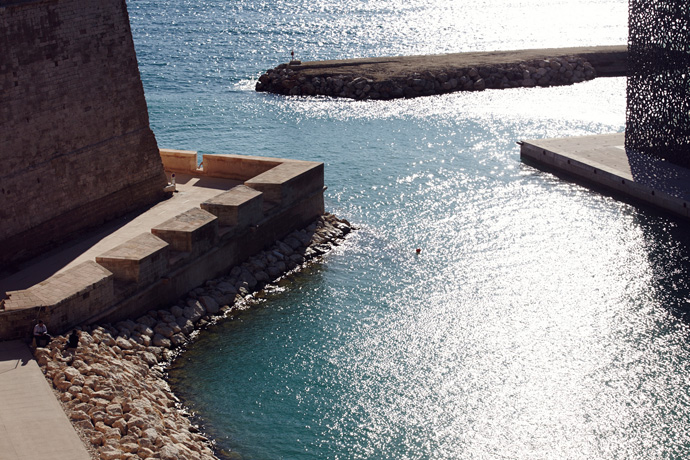 Top left: "Notre-Dame de la Garde" looming over Marseille and the the seven-level, 40 000 square meter
structure of the MuCEM. Photography by René Habermacher.
Top left: "Notre-Dame de la Garde" looming over Marseille and the the seven-level, 40 000 square meter
structure of the MuCEM. Photography by René Habermacher.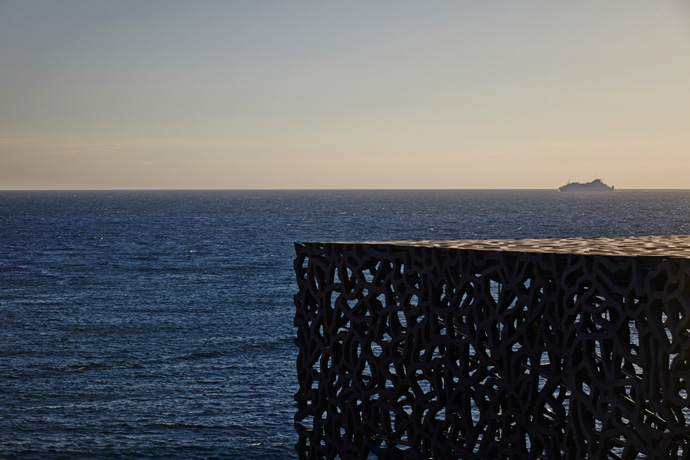
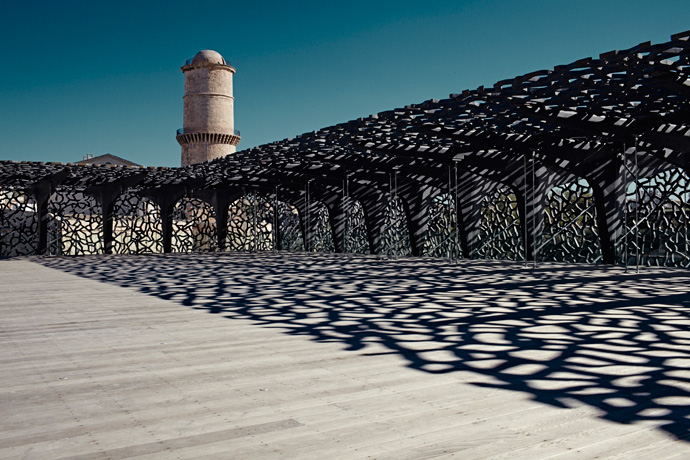
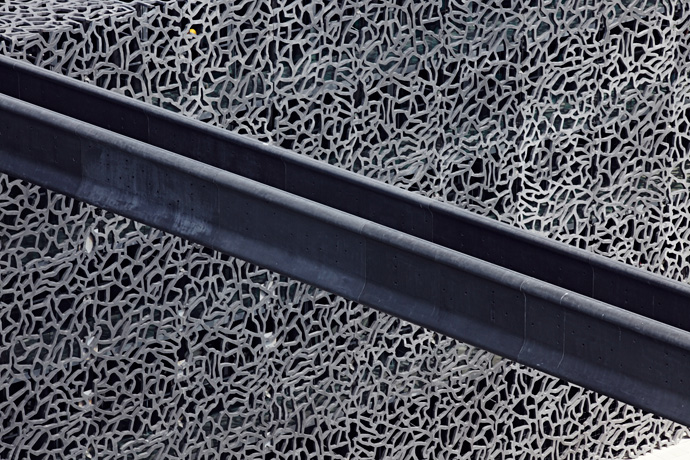
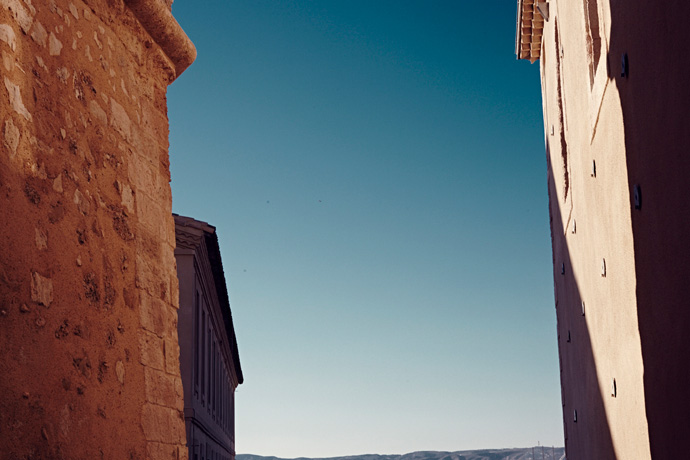 As massive the volume of the MuCEM may seem at first, it is the use of negative space that gives the building
the air of the metaphysical. Photography by René Habermacher
As massive the volume of the MuCEM may seem at first, it is the use of negative space that gives the building
the air of the metaphysical. Photography by René HabermacherAA: What is the last thing which stimulated you ?
RR: A fish soup made by my partner…
Read my last pamphlet to smile:
« L’Architecture est un sport de combat » [Architecture is a combat sport], edited by Textuel.With SayWho & Agence White
-

john lawrence sullivan : in the ring
-Tokyoite Arashi Yanagawa, the man behind menswear label John Lawrence Sullivan, has quickly become a fixture of the men’s fashion circuit.
The choice of name for the label is perhaps the most telling. John Lawrence Sullivan, the man, is a heavyweight boxing champion, also known as the “Boston strong boy,” and godfather of sorts to Arashi, who quit a promising boxing career to fight in another type of ring.
Ever since entering the seasonal arena of fashion week in Paris, he’s championed his collections in the eye of attention, with the likes of Suzy Menkes a constant follower. In this context, Arashi’s unconventional vision of the sharp tailored sportsman is most compelling.
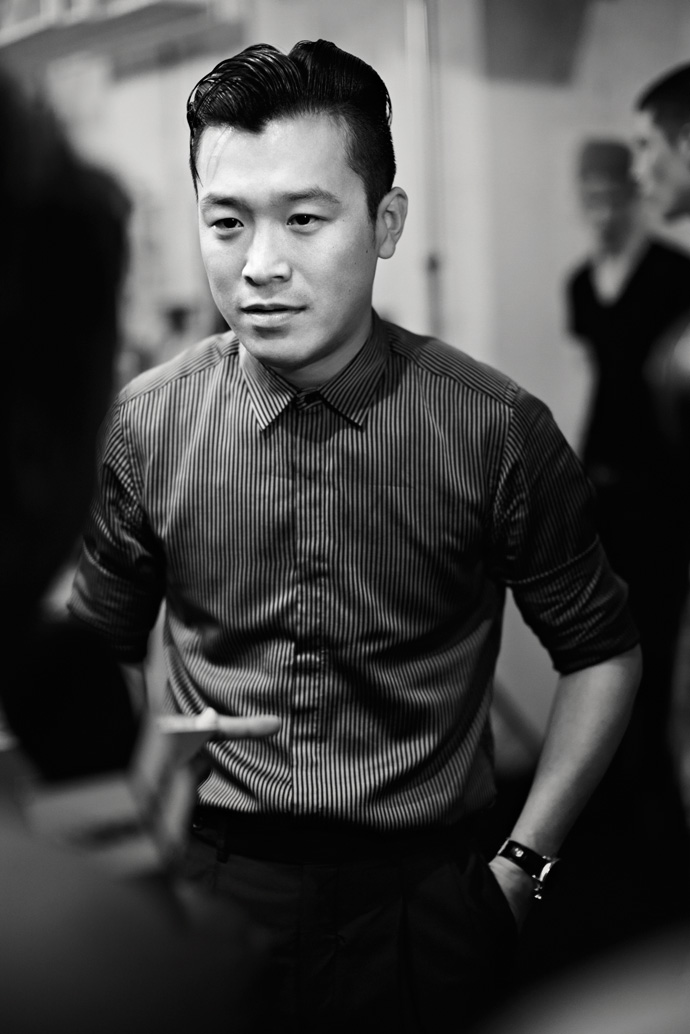 Arashi Yanagawa backstage after his John Lawrence Sullivan presentation. Photography by René Habermacher
Arashi Yanagawa backstage after his John Lawrence Sullivan presentation. Photography by René HabermacherRené Habermacher: Hello Arashi, how is it being back in Tokyo after your last show in the ring fight of Paris fashion week?
Arashi Yanagawa: I’m getting ready for the next match in June. While I’m always relaxed in the end, I also always begin thinking about the next collection right away. It’s exactly the same as in boxing.RH: In your work, specially your most recent collection, I sense a strong fascination with British culture.
but you’re successfully showing your 3rd collection, you chose Paris to present it…
AY: I believe Paris is the most important location for fashion in terms of the both the culture and the history of the industry. Paris has a special eye for beauty and elegance. No other place draws as many journalists, buyers, and fashionistas. All of this naturally makes Paris a very attractive city for presenters, but I also appreciate how strict everyone in Paris is towards creativity.RH: And what is it with you and London?
AY: London has street fashion just like Tokyo, but it also brings history and tradition into the mix. I’m impressed by the way all of this culture has just naturally rubbed off on the younger generations. Another example of something that has really moved me is the culture of the London market where you see young people today buying and even demanding clothing designed a century ago.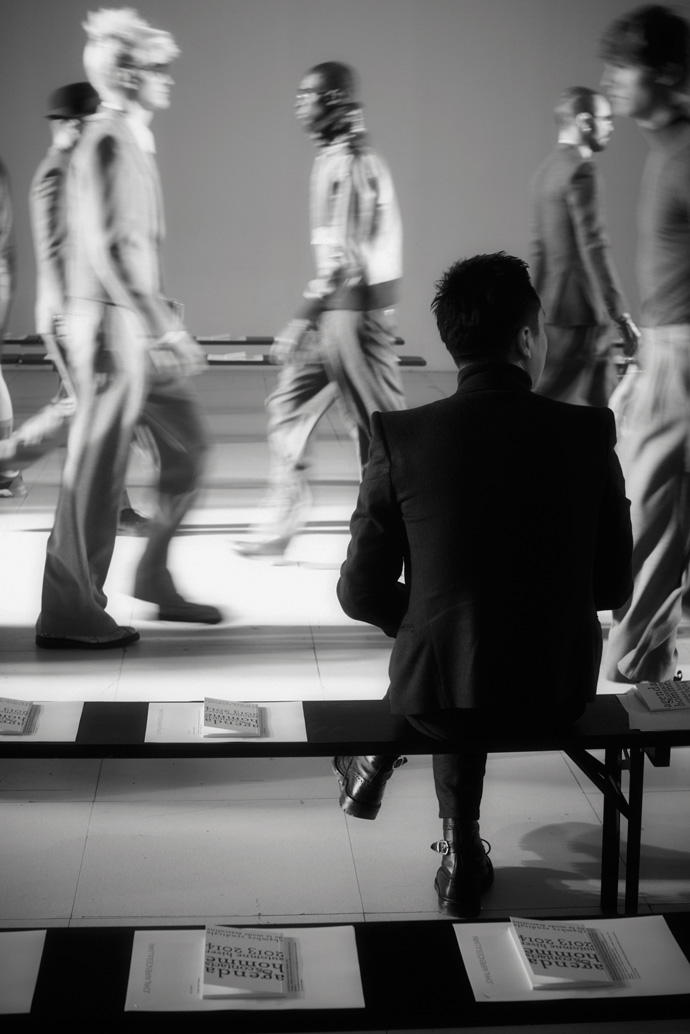
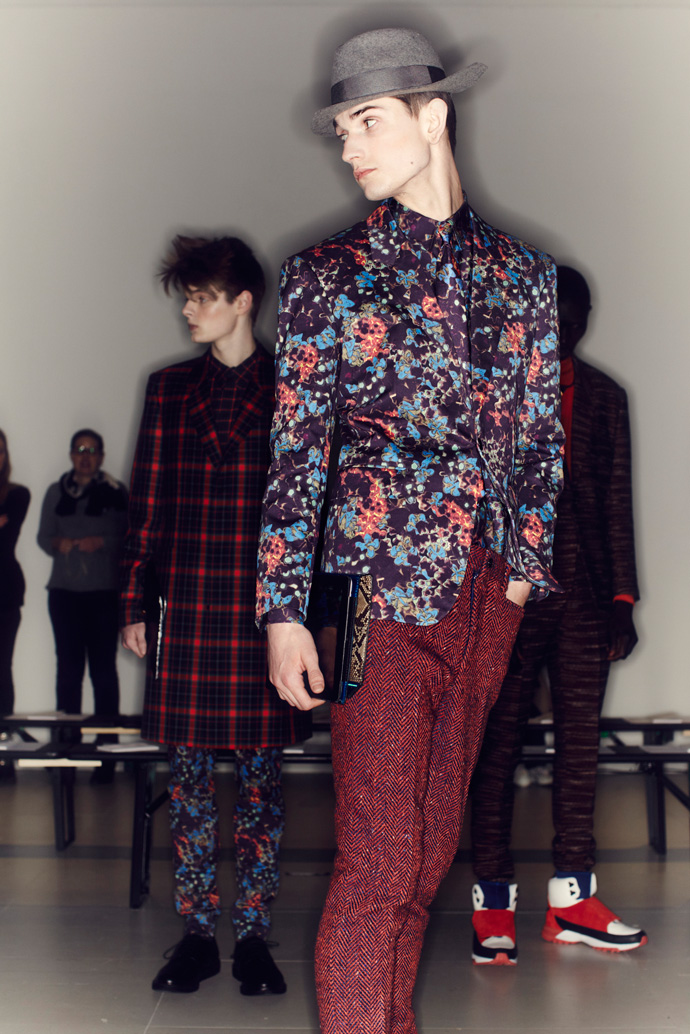 Rehearsals for John Lawrence Sullivan FW13. Photography by René Habermacher
Rehearsals for John Lawrence Sullivan FW13. Photography by René HabermacherRH: how do you decide for what you’ll go next? what is your creative process?
AY: I input the “sense” of the things I see or hear in my daily life and stockpile them. These could be colors, silhouettes, light, or even materials. But, I make an effort to express my own sense of the now rather than just making things based on historical research.RH: For the current summer collection the theme was influenced by the Bauhaus movement.
Why did you feel the urge for this now, and how did you translate that into the clothes?
AY: I had a chance to go to Berlin, so I paid a visit to the Bauhaus school in Dessau and took in the artwork there. I found the combinations of wood, leather, and metal used in the products there particularly interesting, and thought it might be fun to try doing the same things with apparel. So, I made the theme “Bauhaus” and began putting together the collection while referencing architectural cutting, artistic colors, and product techniques.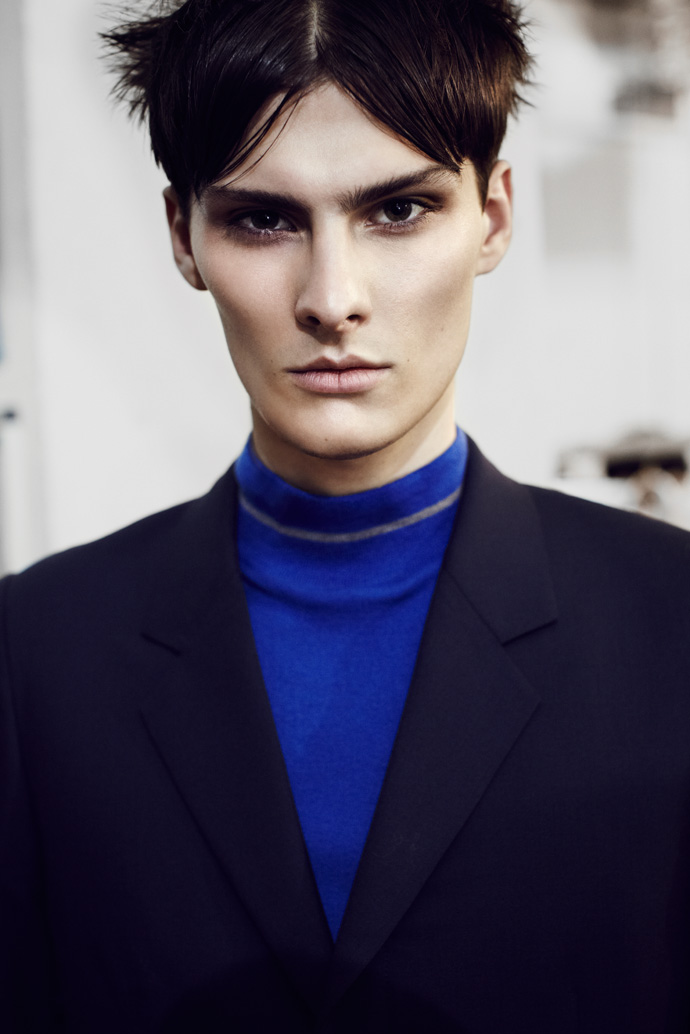
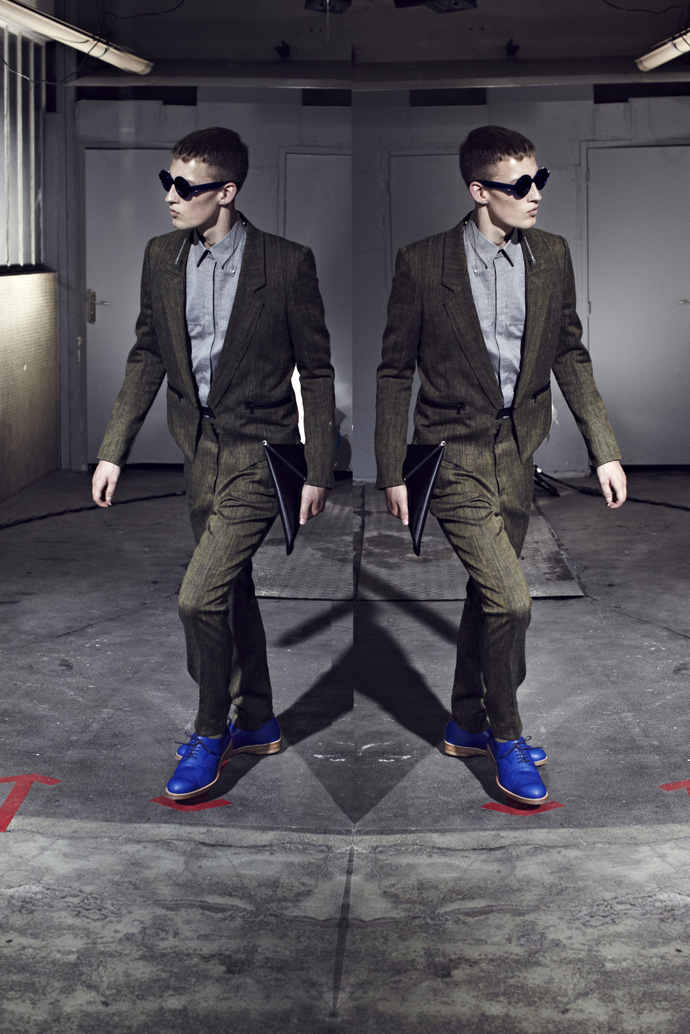 John Lawrence Sullivan's "Bauhaus" inspired collection, SS13. Photography by René Habermacher
John Lawrence Sullivan's "Bauhaus" inspired collection, SS13. Photography by René HabermacherRH: can you tell me more about “ELECTRIC AFRICA”: theme of the collection FW13/14, you just showed in Paris, what ideas are behind it?
AY: “Electric Africa” is a coined phrase. I had the idea to create a new, modern vision by combining tribal patterns associated directly with Africa with flashy colors instead of the standard earth tones. Tribal (triangular) elements were worked into various items and aspects like the cutting of the tailored jackets or the placement of the buttons. I also added a spacey essence reminiscent of the crop circles that suddenly appear in fields to the accessories, colors, and textures.RH: This collection also sports extraordinary footwear. Your sneakers have been hailed throughout. How did this design come together?
AY: I wanted create something akin to sneakers or trekking shoes, so I used Vibram soles. I also combined the base colors of the seasonwith highly contrasting hues in order to bring out a sense of Africa. I worked with a brand called ORPHIC when making the shoes.RH: Since you dropped your boxing for founding your label, fashion in Japan underwent quite some changes. How do you see the japanese approach today, what is your viewpoint and what influenced you over the course of time?
AY: When I started my brand in Tokyo my image was much more aggressive. I feel like back then many of the magazines adopted a fashionable approach, and that the buyers tried to answer the challenges the designers undertook with respect. But, as the economy got worse the magazines switched to much more easy to understand catalog-like appearance in order to make sales, which in turn influenced buyers, whose customers were influenced by this, to become much more conservative in their selections. So, there were a lot of negative things occurring in fashion here. The Tokyo runway shows were no different, as the focus shifted conspicuously to more “real” presentations rather shows with a bit a fantasy or elegance to them. Feeling all of this made me want to do my shows somewhere more stimulating, so I chose Paris.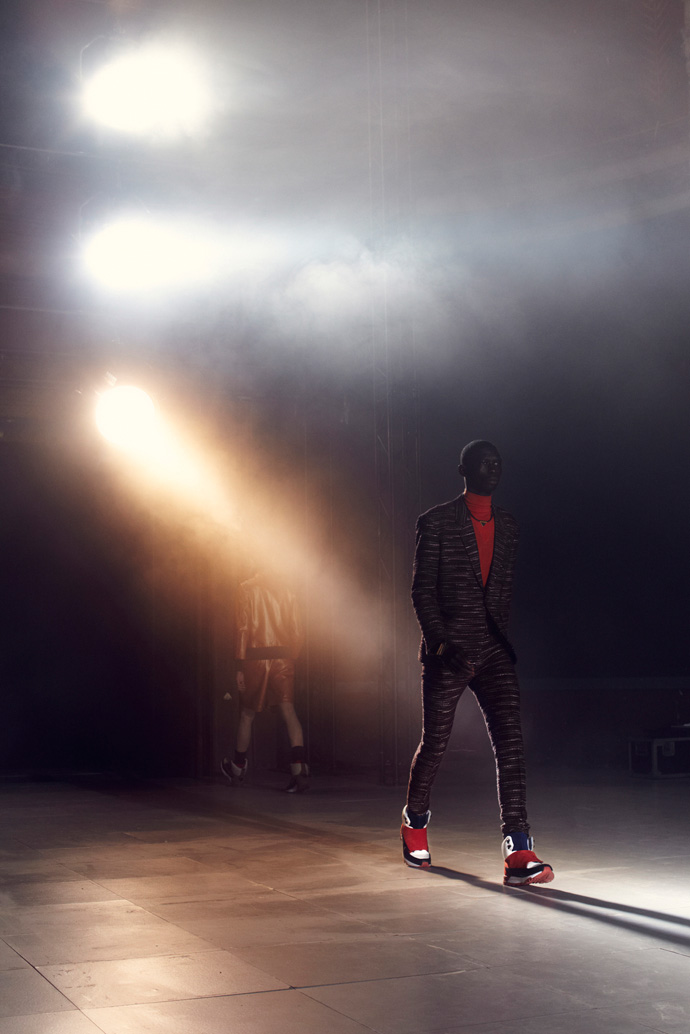
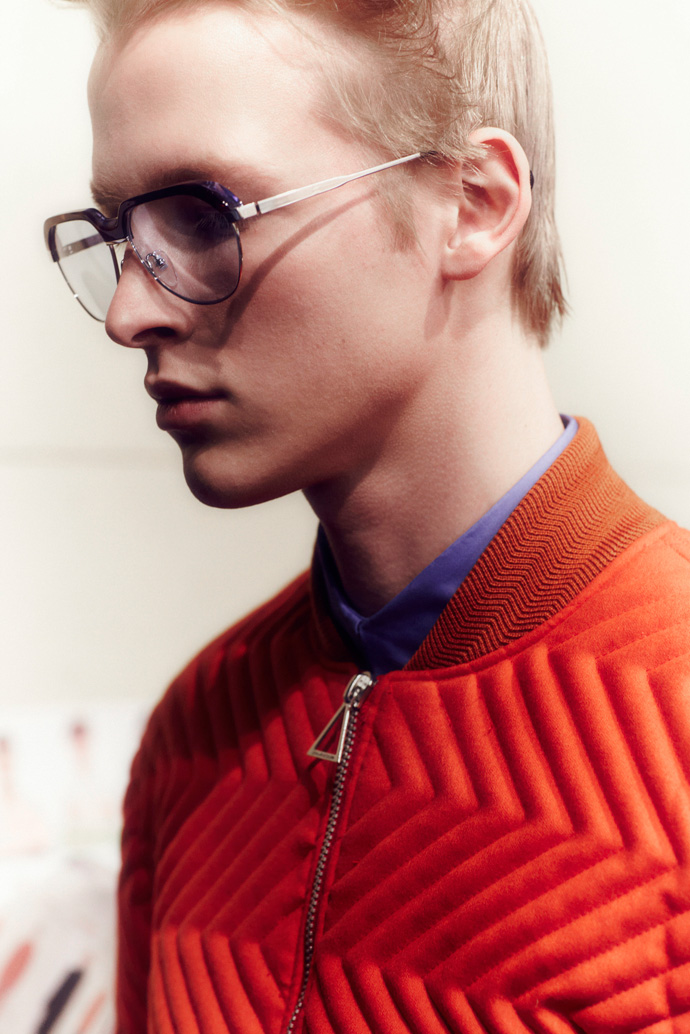 "Electric Africa", John Lawrence Sullivan FW13. Photography by René Habermacher
"Electric Africa", John Lawrence Sullivan FW13. Photography by René HabermacherRH: While developing your collection, are you having a specific type of man in the back of your head?
AY: I always imagine a man who possesses both beauty and strength in terms of appearance and mind. If I were to provide a sportsman as an example, there is a certain boxer who comes to mind…RH: Are there any parallels you can draw between your sports career and the one in fashion?
AY: One thing I realized when I first started working in fashion is that there is a common trait shared by boxing matches and fashion shows that only I seemed to notice. This was the way in which you worry over something that will last only few minutes on a single day for months in advance, battling with your anxieties and, as long as you don’t give up, preparing for the next match as soon as it’s all over regardless of whether you won or lost. The way everything seems so fleeting and transient once it’s all said and done is also the same.RH: The understanding of classic tailoring is a very strong element in your work. Now you started your women’s line: how does this apply here?
AY: Incorporating classic tailoring into women’s fashion is one of the most important elements for John Lawrence Sullivan. This isn’t something just any brand can do, so it’s something we will continue to actively working with in the future. One of the differences between men’s and women’s fashion for me was the way in which things like esthetic elements concealing points I had complexes about confused me a bit at first. Now I feel that I have learned to use men’s techniques to deal with these things.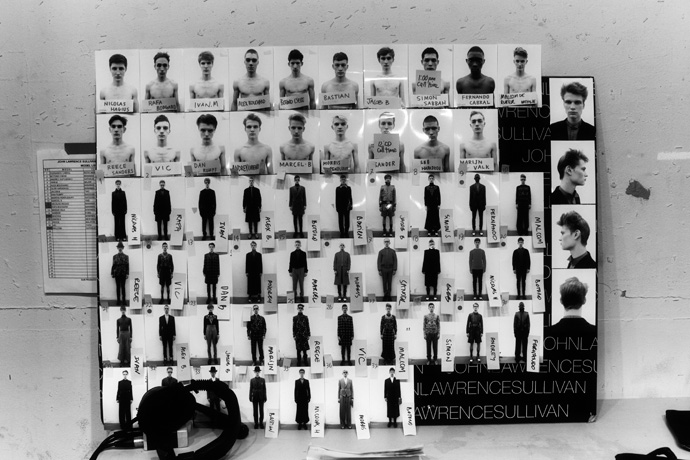 Showboard with looks and cast for "Electric Africa". Photography by René Habermacher
Showboard with looks and cast for "Electric Africa". Photography by René HabermacherRH: As you added another collection to your house – your work wheel must spin faster evidently, with 4 instead of 2 presentations.
AY: I always think of how I can break down the restrictions of the tailored look when I do my men’s designs. While there is the sense that I can be confident in breaking these restrictions down precisely because they exist, but with women’s my process is one of imposing my own restrictions on the things I design freely. So, there is a sense of mutual stimulation between my men’s and women’s lines that has been a good influence in my opinion. That said, I am definitely much busier than before…RH: Do you feel urged by the increasing numbers of pre-collections and cruise collections that the big houses lately launch?
AY: This is most likely just a sign of the conservative sales trends we’re seeing worldwide right now.The big houses are just doing this as a way of making sure they continue to pull in revenue. I too feel that JLS must do the same if we are to continue showing in Paris, so I’ll be considering various strategies for this in the days to come.RH: With clients all over the globe in different climate zones: do “season oriented” collections make still sense to you? (already the weather in Japan is quite different to the north american or european)
AY: Breaking things up by season allows designers to change up their mood and add depth to the presentation, so I most definitely think it has meaning. But, I also feel that in terms of actual sales it is often seasonless items that perform the best.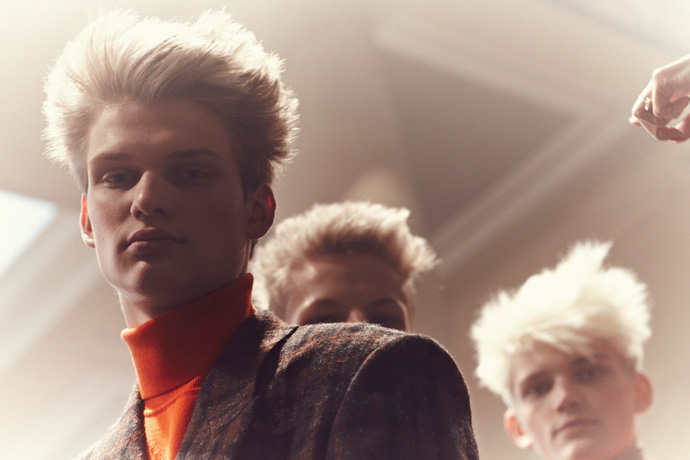 "Electric Africa", John Lawrence Sullivan FW13. Photography by René Habermacher
"Electric Africa", John Lawrence Sullivan FW13. Photography by René HabermacherRH: How do you perceive the present of fashion?
AY: I think what we are seeing is a mixture of various styles coming together.
This is also exactly why I feel that you can’t make it in this day and age unless you believe in yourself and keep making bold presentations. I guess you could say I feel we’re in an era where only the essentials survive. I want JLS to continue to be a brand that always takes up the challenge of presenting in Paris.RH: What is up next?
AY: The designs for my women’s exhibition in March and preparations for the 2014 S/S season.RH: What is the last thing you saw, read, heard or felt that stimulated you?
AY: Tadao Ando, James Turrell, Donald Judd, Taro Okamoto, Talking Heads, Pixies, David Bowie, Wes Anderson, Jim Jarmusch, Kinji FukasakuWebsite: John Lawrence Sullivan
-

MONSIEUR HERVÉ
-What’s in a name ?
You can ask Kenzo Takada, Martin Margiela, John Galliano, Valentino Garavani or Helmut Lang – designers who, for various reasons, left the company which bears their name, and then had to make themselves a new name, in fashion or elsewhere.
Or you can ask Monsieur Hervé Léger, the legendary French designer who took fashion by storm with his body-conscious designs, ultimately embodied by the “bandage” dresses. Monsieur Hervé Léger does not design for Hervé Léger, the company. Monsieur Hervé Léger designs for Hervé L.Leroux, a nom de mode suggested by Karl Lagerfeld.

Photography by René Habermacher
Filep Motwary, who met Monsieur Hervé through model and muse Suzanne Von Aichinger, talked with the designer as he prepared his new couture collection for Summer 2013, now on display in Paris in Colette and on presentation in Monsieur Léger’s new but history-laden atelier.
Filep Motwary: So, how is your day so far?
Mr. Hervé Léger: Well it’s cool. I am peaceful today. Yesterday I was not, but today I am.F.M: You are getting ready for your Couture collection ?
Mr.HL: Yes, you see I am a professional, I try to do everything in the right context and I do not like to keep my people working at night and we are trying to be efficient and of course we will be ready on time. You know I’ve been creating for a long time, but because I didn’t want to make shows, my comeback is under new conditions. And it figures that some people always followed me and now I sell worldwide. Business is good now finally again and I am pleased.(As we speak, Suzanne Von Aichinger and René Habermacher are working in the showroom photographing the garments),
F.M: I understand. Do you mind if you help me fill some gaps of your life’s storyline, because it’s out there, but not fully completed… So, it was during the late 1970’s that you started-off your career as a hat maker and hairdresser?
Mr.HL: (Laughs) It’s a crazy story, but… I’ll try to make it short. I had done some studies like everyone, I went as a young man to the Beaux Arts in France though I only stayed for one year as it was the 70’s and France was all about manifestations at the time and intense political changes. As students, we were on the streets demonstrating and I wasn’t learning a lot since everything was on strike.
I also wanted to be independent from my parents and wanted to do something by myself, to work. I am very good with my hands; I am a craftsman and can do everything with them in terms of creation so I decided to be a hairdresser. Although I didn’t study hair, I learnt the job very quickly by opening the door of a hair-salon telling them I wanted to learn. They took me and stayed there for a while. Then I started to make hats, after finding a book at my grandmother’s house, which was full of illustrations on how to make them. The first customers arrived and I was working at home. So there goes the “hat story”.
Then one day someone who was famous in the 1970’s asked me to do a very particular hat, a-giant-sort of “Belle Époque” hat with a lobster on it (laughs). The guy’s name was Tan Guidicelli, whom you probably might know. It wasn’t long enough until he asked me to make three dresses for his show because his atelier was very busy and his show was in three days. Although I had never designed any dresses before, I said “Ok, I’ll do them” and when he saw them he said “ you got a real sense of fashion and you should stop hairdressing and come work with me”. So that was my first fashion encounter.
Of course I dropped hairdressing and started to learn sewing. Later I went into design. My second big encounter was Karl Lagerfeld.
The 1980’s were an easy time. You could easily meet someone. People were more open. Even during my days as a hairdresser, with my friends, you could end up having dinner with Claude Montana, Mugler, Lagerfeld etc. It was not such a big deal as it is today. It was proper dinners you know, not charities. So at the time I met Karl at the house of a journalist friend and something happened immediately. We started talking about corsets (at the time I was fascinated by corsets). So that was on Saturday and on Monday my friend from “Woman’s Wear Daily” called to say “Karl wants to see you.” So I went with a few sketches and he said, “ Well, I don’t care about your sketches, I’m looking for an assistant at Fendi in Rome” and I said “Yes!”.
So by next Friday I was on the plane flying to Italy.Then I went to Chanel for one year and worked for him until I was fired.
I created my own label in 1985 but the bandage dresses came out only in early 1990’s. I don’t consider the beginning of my career started in the 80’s. My career, as I see it started in the 90’s.F.M: Tell me about the bandage dress…
Mr.HL: The real story of the bandage dress is important as a fact of my work storyline. I was having a show at Angelina Tea Salon in Paris, and I wanted something glamorous for the finale. I didn’t have the fabrics. A few days later, I went to a factory and found some bands of metallic yarn, sort of lurex. I asked, “What is this?” and I was told “its for the garbage”. So I took that and I started to put one yarn next to the other and started molding the bands on the dummy, exactly like you do hats. And that’s how the first bandage dress was born. I did the show and it was a success.
I was hooked on these new for me materials and started to experiment. In the beginning, I did not want to put any zippers because I wanted to create a dress with no seams. The problem was that I did make the dress with no seams but when one of my clients got herself in, she couldn’t get out (Laughs).
Then came the presentation of nine dresses in the office of my press attaché at the time. The fashion journalists from American Elle made pictures and became a success very quickly.
F.M: This technique you are working on, the way you make your garments is really one of its kind. Allow me to say that I see them as dresses for women to please men…
Mr.HL: It’s true! Its because they make women look great. The fit is great because it shapes the body. For example, the body of a young girl is not my cup of tea. I like bodies with a bosom, with a waist, curves…
My dresses can give a shape even to bodies that are not perfect. This is why I think men love them the same that women who wear them. They seem almost like a modern corset with no bones. The fit that a woman experiences at Herve L.Leroux is the fit I invented at Hervé Leger. Even in my couture dresses today, I use the bands and my own technique, the one I invented then.
F.M: Hervé, I want to ask you about the true story about what happened. How did you lose control of Hervé Léger in 1999.
Mr.HL: People say that I sold it. That’s a lie, I mean I wish I would have sold it.When the bandage dresses started to be famous, a man that was fascinated by them approached me. He said to me “I went to a party in Caracas and a woman arrived in one of your dresses and everybody went crazy.” He “chased” and sent me some bankers asking to be my partner. Of course I said “Yes” because I wanted to develop this business and I didn’t have to run after any partner anymore…
It was a nice combination and it was Seagram, a very powerful group who invested money and soon Hervé Léger became a major house.
Though I had to be very conscious about the number of sales, otherwise they would drop me. The story is that the guy from Seagram decided to get rid of a few companies they had in order to invest on a bigger French company called Vivendi. At the end he sold everything, including me, although he assured me before that he would find me a new partner and he would help to finance the changes.I had someone who wanted to buy the company from Seagram, they put the dossier in the bank’s hands and then they sold it to Max Azria. So he bought it, though I tried to make it work but it fact it didn’t. At the time I was only left with 5% of the company…
When people invest in a company, especially in the fashion industry, the designer or the name behind the company, has to stay part of it otherwise it won’t invest.Some people like Donna Karan, did it in a very clever way for example.
I guess it didn’t work for me because I didn’t have good lawyers at the time…I didn’t agree with the strategy and they fired me from the house I had created. The worst of it all was that he didn’t know what to do with the house of Léger for a long time. In 2007, which is quite recent I may say, at the same moment when I decided to do ready-to-wear again, he opened the archives he started to re-do my dresses from back then for Hollywood stars and the bandage dresses were successful again.
F.M: And what did you do?
Mr.HL: Wolford contacted me and they asked me to work for them… Then came my shop. The problem was I couldn’t use my name anymore. It’s Karl Lagerfeld who came up with the idea of Hervé Leroux. He said “you’ve got red hair” so it has to be called Hervé Leroux and put the “L.” in the middle, who knows one day you can do again “Hervé Léger Leroux.”F.M: So, back to your collection. How did you start again?
Mr.HL: In 2000 I did a comeback with ready-to-wear and I had immediately lots of customers coming, especially from America. Then came another incident, 9/11. No one came after that.It affected everyone and the business went downhill. That’s when I decided to stop ready-to-wear as it was very expensive to create, have production control, distribution etc… So since then, I focused on Couture until 2007, only for private customers and some shops that wanted to buy a few of my pieces. It was a difficult time but I survived.
It was in 2007 when my customers wanted my ready-to-wear again and it went very good. We are in Colette and so many other prestigious boutiques around the world now. I am very satisfied.
F.M: You are a designer that works with couture methods, a real artisan. How do you see the use of “future” references and approach in fashion in combination with technology?
Mr.HL: I think moving towards the future is good for this business, generally speaking..Sewing a dress is always sewing a dress.
For me what is more important is that the clothes look good and made with good materials. I know nothing about technology whatsoever. I know that my clothes are very true; I use very particular techniques to make them. I am more of a couturier rather than a stylist. I don’t go scouting for old clothes to re-do them, I don’t search for ideas around. Even at moments when I wanted to copy someone, I just couldn’t do it you know?Other’s people’s clothes don’t inspire me. I am obsessed by my own ways of creation and I feel lucky to have customers starting from 16 to 70. I am never about trends; I see no use in them. Today I have the feeling that it is all about money. Designers today don’t spend hours fitting a dress on a body. They do it on dummies. I feel comfortable with the way I work.
F.M: How were the 1980’s and 1990’s fashion scene compared to what we see today?
Mr.HL: Oh my God, things were so happy back then, so happy. The 70’s, the 80’s and the 90’s. People were passionate and they could make money from that passion. Bankers, investors or whatever you call them didn’t really exist then so designers were freer. Only one thing Filep, the aesthetic of the girls then is what is missing from today.Or the power the shows had back then. Think of Montana and Mugler!! Oh my God, the girls were so beautiful, the way they walked. I feel lucky for living through that era working with all of them; from Linda to Cindy… I had them all.
And they were so full compared to today that everyone is so skinny. And all my models loved the clothes; you know a lot of clothes would disappear after the show (laughs). Even during fittings those girls would feel the clothes, they were posing.
Today my favorite show is Victoria’s Secret because it’s a happy one. I am not saying girls are not beautiful today, I just think shows today have become boring and less inspiring. They look like robots and there is no charm. I really wonder if I was to do a show today how I should do it and not look ridiculous and dated.
And sometimes I speak with journalists and they are bored of the current situation too.
Anyway, I am not ready to do a show now also because I am not a kid. If I do a show it has to be made the right way as a good show also costs a lot of money.F.M: Maybe you could do a little show in a Hotel Suite like couturiers used to do back in the 50’s.
Mr.HL: Hmm, yes. For this season I just wanted to show the work the way it is. Starting on Monday, Colette will have 5 of my dresses in the window and on Thursday I am showing another 12 pieces in my showroom as I have been invited by the Chamber of Haute Couture and it feels wonderful.F.M: What is this collection about?
Mr.HL: You know I never start saying “I’m going to do this and that”. I just grab my fabric and start working. All I can say is that 80% of the collection is done and it looks like a walk in a Japanese garden. The drapes are very graphic in the sense of Japanese design…F.M: Why does couture still breath? Is it merely a question of tradition? Why does it still interest people?
Mr.HL: It’s exceptional I would say with an excellence. Although the world has changed and we are in the middle of a crisis, luxury is always surviving. What is luxury about today is another story than what it used to be. There are a lot of luxury houses that produce clothes or bags in Taiwan etc. but, there are still women who want to dream. I see my clients… And the movie stars I dress – of course they don’t buy the clothes (laughs).There are still women who are not in the spotlight, not in the newspapers yet they prefer couture because it is special. They are in search of the perfect fit and for me the fit is something important.
F.M: Why is couture so personal as it requires the customer and the designer in a very private session?
Mr.HL: There are less and less couture houses as time goes by. Chanel is a real Couture house for example because they have the right hands to do the artisanship, Gaultier also as well as Dior. Couture has a certain way of doing it, it has its own rules, and also the fabrics are richer. Everything is on made on perfect scale. There are more and more rich people and the opposite, which I find very depressing. We can say there are people who are rich today and they are richer than what the term “rich” meant 20 years ago..
Those who spend, really spend…F.M: What provokes the strongest emotions in you nowadays, compared to what made you emotional in the past?
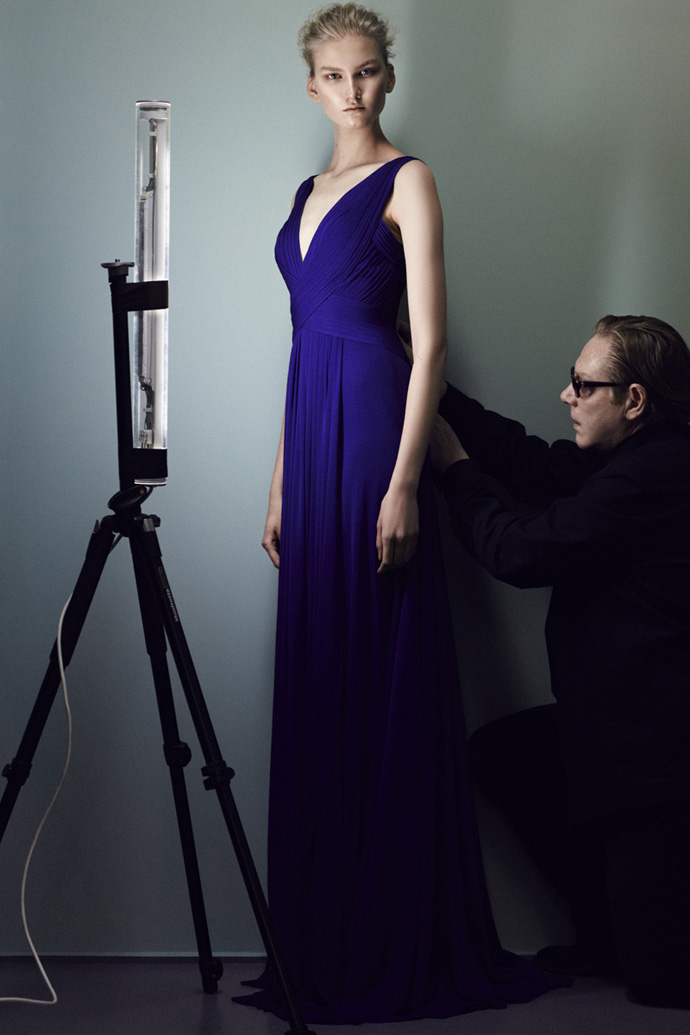
Mr.HL: When I was “Hervé Léger” I was never satisfied. Nothing was good enough and I always thought I could do better. Today, although I still want to do better I become emotional by looking at my own dresses, a feeling I never had before.
I am happier today because I don’t have anybody else involved in my business; I have a great team of loyal people working with me. Also what is very emotional for me is when I see women trying my clothes on.F.M: What is next for you?
Mr.HL: I’m working on developing my business. A perfume that I am working on. I want to start doing accessories, shoes, lingerie and swimsuits. Also my customers locked me in my atelier designing dresses – at least I am famous for something (laughs)- but you know I am very good in designing suits, coats, pants and blouses…Basically when you are wearing Herve L.Leroux, is for the evening. I want to make day-wear too. Although every time I do they never buy it, but I’m going to push.
The interview is a collaboration project between Un nouVeau iDEAL and The Stimuleye.
interview FILEP MOTWARY
photography RENE HABERMACHER
fashion editor SUZANNE VON AICHINGER
hair PANOS PAPANDRIANOS
make up YIANNIS SISKOS
model ANNA MARTYNOVA@ NEXT MODELSthank you VERSAE VANNI @ NEXT PARIS
-

hanaa
-It’s not everyday that an Arab woman is chosen by a major cosmetics brand as its global spokesperson…
The Stimuleye presents “Hanaa”, a film by Antoine Asseraf & René Habermacher, starring Tunisian model Hanaa Ben Abdesslem, spokesperson for Lancôme.
Antoine Asseraf: Where are you from, and how were you discovered ?
Hanaa Ben Abdesslem: I was raised in a town on the sea coast of Tunisia named Nabeul.
I dreamed of becoming a model since I was very young.In 2009, I participated in a reality TV show for models in Lebanon. There I met Sophie GalaI, who would become my manager, and in 2010 she presented me to IMG Paris, who in turn presented me to Carine Roitfeld, at the time Editor-in-Chief of Vogue Paris.
Through her introduction to Ricardo Tisci , I was chosen as a Givenchy fashion show exclusive that same season.
AA: You’re becoming an icon representing the “middle-eastern woman” in the fashion world and beyond,
but which people are icons to you ? Can you tell us a bit about your relationship with Farida Khelfa ?My icons are the Tunisian women in the fashion industry, whom I admire and whose accomplishments I respect, such as Liela Menshari, Hermes window designer — she received the Golden Dido Award for her contribution to Tunisian culture and influences in world, and Afef Jenifen, who fought for Arab women’s freedom of choice and continues to defend their rights.
Farida is a great support and she always has good advice, such as “stay true to yourself.”
HANAA
a film by Antoine Asseraf & René Habermacher
starring Hanaa Ben Abdesslem
styling Yoko Miyake
hair Nicolas Eldin
make up Tracey Gray Mann
production by Clast
postproduction by The Stimuleye
text by Omar Khayyam
sound by Gnawa Diffusion
thanks Sophie GallalLook 1: Dolce & Gabbana
Look 2: Jil Sander by Raf Simons
Look 3: Chloé
Look 4: Stella McCartney -

films of the season: princess cornflakes
-Big is beautiful.
Biggerest is beautifuller.The Stimuleye is proud to announce its Film of the Season™ for Vogue Italia,
its first full collaboration with CLAST productions,
a special commission for curvy clothing line For.me Elena Miro,
Princess Cornflakes.
Princess Cornflakes / ENGLISH VERSION
PRINCESS CORNFLAKES (English) from AntoineAsseraf+RenéHabermacher on Vimeo.
Princess Cornflakes / VERSION FRANÇAISE
PRINCESS CORNFLAKES (Français) from AntoineAsseraf+RenéHabermacher on Vimeo.
CREDITS:
(more…) -

-

la jolla fashion film festival
-the stimuleye is happy to report that, after winning the Best Fashion Award at last year’s La Jolla Fashion Film Festival for La Main Dans Le Sac, we are in the selection again this year.
My Garden, for Vivienne Tam, starring Kiko Mizuhara is one of the 60 films selected from over 6000 in consideration…
La Jolla Fashion Film Festival opens today at the San Diego Museum of Contemporary Art,
in La Jolla, California. -

films of the season: monsieur chypre – a short film with erotokritos
-The Stimuleye is proud to announce, with the support of Vogue Italia, an “erotic fashion epic” : Monsieur Chypre.
“HE KNOWS WOMEN, AND WOMEN KNOW HIM”
Erotokritos, it’s a strange name for a fashion brand.
It’s an even stranger name for a person.
And yet, he is truly called Erotokritos Antoniadis, named after the main protagonist of medieval epic poem, a hero “born from the labors of love”.
For 15 years, his label has been seducing women of all ages, drawn to collections that go back and forth between the sophistication of Paris and the dolce vita of Cyprus…"come and get it."
“THEY CALL HIM MONSIEUR CHYPRE”
France and Cyprus, Paris and Nicosia, it’s a long-distance couple.
In Monsieur Chypre, by Antoine Asseraf & René Habermacher, they come to life:
Loan Chabanol, channeling the nostalgia of Marguerite Duras’ The Lover, plays the tormented Parisian woman, cracking at the surface,
while Constantino Kouyialis, in his first first on-screen role, is a revelation as the seductive eponym hero, a modern day Alexis Zorbas.“AN EROTIC FASHION EPIC” we call it.
“Erotic,” how could it not be with a name like Erotokritos ?
“Fashion,” of course: stylist Michaela Dosamantes, fresh from winning Best Fashion Award at La Jolla Fashion Film Festival for La Main Dans Le Sac, mixes the season’s classic looks to capture the heroine’s transformation from “bluesy” in Vuitton to “red-hot” in Valentino.
And “epic” ? What else do you call a fashion film 10 months in the making, taking place not only in Paris but in numerous locations in Nicosia, in the salt lake facing the Hala Sultan Tekke mosque in Larnaca, in the Almyra and Anassa deluxe hotels, in small taverns by the side of the road, or in the majestic monument carved directed in the stone, the tomb of the Kings in Paphos ?“HIS VOICE IS A SONG”
All this, to the original soundtrack of Lori Schonberg and Shane Aspegren, members of Ça Va Chéri.
(Download it here).So, now the tough questions.
Is Cyprus really like this ? A little bit. Not at all. It depends how you look at it.
It is an island of freedom in the east mediterranean, where couples from Israel and Lebanon come to escape religion. It is the birthplace of Aphrodite. You go, you decide.So how can I meet this Mister Cyprus ? We hear that one a lot. From women (and men) of all ages. Maybe he’s real, maybe he’s a figment of our collective imagination, our repressed desires. One thing’s for sure — we can’t give you his number.
“ATTEMPTING TO CHARM HIM IS USELESS. HE IS THE ONE WHO WILL FIND.”
-

pilori, beyond the wall & simone fehlinger
-If you didn’t make it for the 3 days of the Hyères Fashion & Photography Festival, you still have until May 26, 2012 to see the exhibitions of the festival at the Villa Noailles in town, including Yohji Yamamoto, Jason Evans, Anouk Kruithof, Ina Jang, Cunningston & Sanderson, Chronique Curiosité, Inez & Vinoodh and… Lynsey Peisinger + The Stimuleye’s performance/installation/video hybrid, PILORI.
Until the end of May you can see at the villa the PILORI installation featuring footage of the performance (with the cooperation of Yohji Yamamoto Inc.) and video contributions by Antoine Asseraf & René Habermacher, starring François Sagat, by Jason Last & Jaime Rubiano, Clément Roncier, Sebastien Meunier + Romain Dja Douadji + Tomek Jarolim, and the winner of our internet contest, Simone Fehlinger, who met up with Filep Motwary.
PILORI (“PILLORY”) is a unique collaboration between choreographer Lynsey Peisinger and The Stimuleye for the Hyères Festival. Drawing on a pool of both local and Paris-based performers, Lynsey Peisinger conceived 2-hour performances inside a specially built space in the Villa Noailles’ Sautoir space: a wall with 4 pairs of legs poking out, moving, at rest, ignoring or harassing each other…
For its exhibition phase, the performance footage is augmented and interrupted by the footage of BEYOND THE WALL, different video artists’ renderings of what lies beyond the wall which cuts the performers in half.
CLONES starring François Sagat, by Antoine Asseraf & René Habermacher.
Sebastien Meunier, Romain Dja Douadji & Tomek Jarolim for BEYOND THE WALL.
Clément Roncier for BEYOND THE WALL/PILORI.
Jason Last & Jaime Rubiano for BEYOND THE WALL/PILORI.
Simone Fehlinger for BEYOND THE WALL / PILORI.
Filep Motwary: What is your video about?
Simone Fehlinger: my videos visualize the stories of walls. Parts of these walls are broken : colors, wallpapers peel off and uncover it’s past… The videos invite to a personal imagination of what this wall’s history is about… Now, these walls have moved to Hyères 2012 and will be part of a new story…Filep Motwary: Why have you chosen white as your “backwards” canvas?
Surfaces are extremely exciting ! But the interesting part is not the perfectly clean, virgin, new, white layer.
It’s the layer underneath…What is your opinion about Hyeres.
It’s legendary ! I’m really happy and honoured to be a part of…What would be your next projects about?
My new big project is my own graphic and video design studio in Paris.Simone Fehlinger, winner of BEYOND THE WALL contest.
PILORI at Villa Noailles
Until May 26, 2012
Hyères, FRANCE.Special thanks to Coralie Gaultier & the Yohji Yamamoto Inc team,
Simone Fehlinger for her contribution,
and all the performers who gave their time to participate in this project. -

films of the season: monsieur chypre
-An erotic fashion epic, one year in the making, THE STIMULEYE is proud to present Monsieur Chypre – A Short Film With Erotokritos, coming April 11th on Vogue Italia.
Starring Constantino Kouyialis & Loan Chabanol, styled by Michaela Dosamantes, and directed by Antoine Asseraf & René Habermacher.
“He knows women, and women know him.”
Erotokritos, it’s a strange name for a fashion brand.It’s an even stranger name for a person.And yet, he is truly called Erotokritos Antoniadis, named after the main protagonist of medieval epic poem, a hero “born from the labors of love”. For 15 years, his label has been seducing women of all ages, drawn to collections that go back and forth between the sophistication of Paris and the dolce vita of Cyprus…“They call him Monsieur Chypre.”
France and Cyprus, Paris and Nicosia, it’s a long-distance couple.In Monsieur Chypre, by Antoine Asseraf & René Habermacher, they come to life: Loan Chabanol, channeling the nostalgia of Marguerite Duras’ The Lover, plays the tormented Parisian woman, cracking at the surface, while Constantino Kouyialis, in his first first on-screen role, is a revelation as the seductive eponym hero, a modern day Alexis Zorbas.“An erotic fashion epic” we call it.“Erotic,” how could it not be with a name like Erotokritos ?“Fashion,” of course: stylist Michaela Dosamantes, fresh from winning Best Fashion Award at La Jolla Fashion Film Festival for La Main Dans Le Sac, mixes the season’s classic looks to capture the heroine’s transformation from “bluesy” in Vuitton to “red-hot” in Valentino.And “epic” ? What else do you call a fashion film 10 months in the making, taking place not only in Paris but in numerous locations in Nicosia, in the salt lake facing the Hala Sultan Tekke mosque in Larnaca, in the Almyra and Anassa deluxe hotels, in small taverns by the side of the road, or in the majestic monument carved directed in the stone, the tomb of the Kings in Paphos ? And we haven’t even mentioned the upcoming almost 10 minutes long directors’ cut….“His voice is a song.”
All this, to the original soundtrack of Lori Schonberg and Shane Aspegren, members of transnational surrealist indie outfit The Berg Sans Nipple.So, now the tough questions.Is Cyprus really like this ? A little bit. Not at all. It depends how you look at it.It is an island of freedom in the east mediterranean, where couples from Israel and Lebanon come to escape religion. It is the birthplace of Aphrodite. You go, you decide.So how can I meet this Mister Cyprus ? We hear that one a lot. From women (and men) of all ages. Maybe he’s real, maybe he’s a figment of our collective imagination, our repressed desires. One thing’s for sure — we can’t give you his number.“Attempting to charm him is useless. He is the one who will find.”MONSIEUR CHYPREa film by ANTOINE ASSERAF & RENE HABERMACHERa THE STIMULEYE productionSTARRINGCONSTANTINO KOUYIALIS as MONSIEUR CHYPRELOAN CHABANOL (ELITE) as MADEMOISELLE PARISPARIS UNITSTYLING – MICHAELA DOSAMANTESHAIR – ROMINA MANENTIMAKE-UP – TIINA ROIVANENPRODUCTION ASSISTANT – LYNSEY PEISINGERLOCATION – HIROMI OTSUKACATERING – EROKITCHENVOICE by LYNSEY PEISINGERMUSIC by LORI SCHONBERG + SHANE ASPEGRENPOSTPRODUCTION by THE STIMULEYECYPRUS UNITALSO STARRINGMYRTO KOUYIALISDIVA MODELS:ALEXANDRA BUNETSKAYAKLELIA YIASEMIDOUANNA DOROTHEOULOCATIONS:ALMYRA & ANASSATHANOS HOTELSALL CLOTHES CYPRUS: EROTOKRITOS ARCHIVESPARIS CLOTHES featuringLOUIS VUITTON, EROTOKRITOS, LOUIS VUITTON JEWELRY, APERLAI, MARC JACOBS, DIOR, FELIPE OLIVEIRA BAPTISTA, AURELIE BIDERMAN, OLATZ, KIKI DE MONTPARNASSE, BURBERRY AND VALENTINOTHANK YOUDimitris Dimitriou / Cyprus Tourist Organisation in ParisPhilippos Philippou / Cyprus AirwaysPavlos Metaxas / Diva modelsAntonakis BarEleni ChrysostomidouLida PhilippidouMary NicolaidouMaroulla AntoniadouGallery Argo NicosiaKostas MantzalosThe city of NicosiaThe city of PaphosANDFilep Motwary -

films of the season 2: My Garden starring Kiko Mizuhara
-Part 2 of our spring fashion film series takes us to Vietnam, a land of mysterious fruits and exotic flowers.
Norwegian Wood actress, Towai Tei-singer, and model Kiko Mizuhara lets us into her garden,
for Vivienne Tam. -

coming soon : monsieur chypre
-an erotic fashion epic, one year in the making….
MONSIEUR CHYPRE
A SHORT FILM WITH EROTOKRITOS
by Antoine Asseraf Asseraf & René Habermacher
with VOGUE ITALIA -

An artist should not make himself into an idol
-Marina Abramović is everywhere lately.
A marathon performance at MoMa, another retrospective in Moscow, on the cover of POP magazine, hosting a star studded event at Jeffrey Deitch’s MOCA in LA and an exhibition at The Serpentine Gallery slated for 2012, the HBO documentary “The Artist is Present” just screened at Sundance. An ever growing list of projects that is taking her across continents…
Exclusive long form of interview first published in POP magazine FW2012
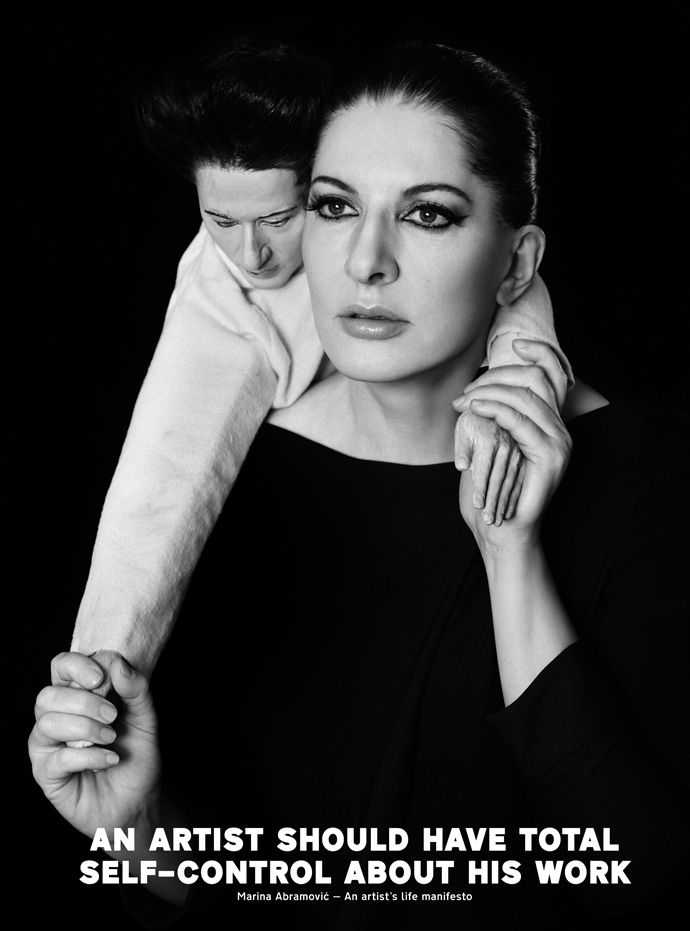 Marina Abramović with her "Mini Me". Photography by René Habermacher for POP magazine
Marina Abramović with her "Mini Me". Photography by René Habermacher for POP magazine
Marina Abramović is everywhere lately. She has emerged from what was considered an alternative section of contemporary art, Performance Art, to finally occupy an untouchable position in the Pantheon of Pop.
A marathon performance at the MoMa, another retrospective in Moscow scheduled, and an exhibition at The Serpentine Gallery slated for 2012, day and night filming of an HBO documentary and an ever growing list of projects. Marina is known for her works in which she tests and pushes her emotional,mental and physical strength, but her schedule takes its toll: Marina is exhausted.
Broad recognition has come comparably late for Abramović, who was often categorized as some sort of Exotic Serbian Vixen. Nevertheless, she has shaped a significant slice of art history like no other.
Today, less considered for her public sexual identity, and more appreciated for her timelessness and her bravery, one could unarguably call Marina “the diva of contemporary art”, were she not so grounded.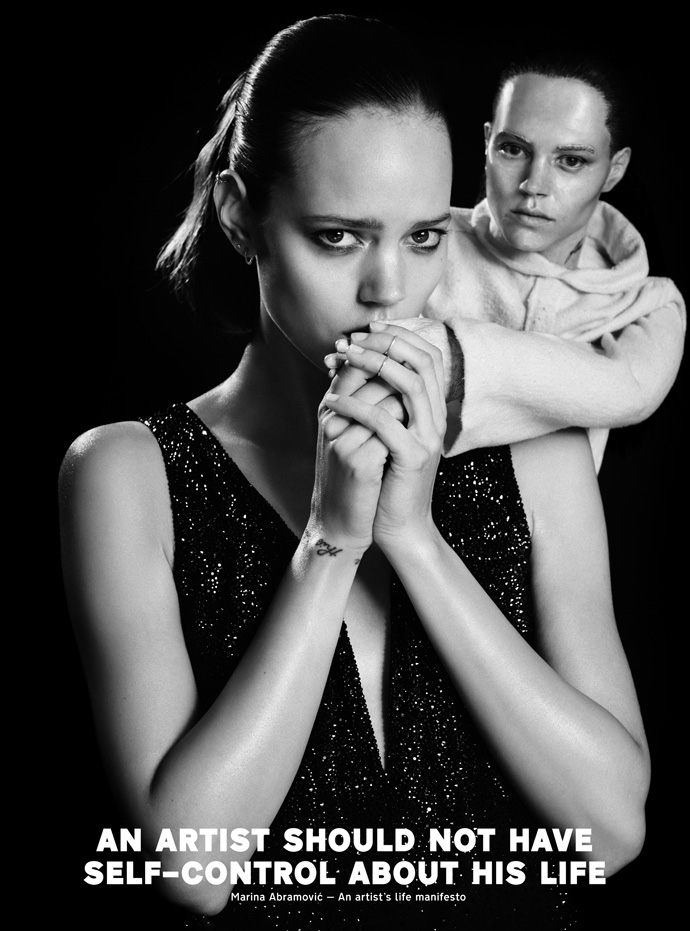 Freja Beha Erichsen with her "Mini Me". A collaboration by Marina Abramović for POP magazine
Photography by René Habermacher
Freja Beha Erichsen with her "Mini Me". A collaboration by Marina Abramović for POP magazine
Photography by René HabermacherOur conversation takes place just after Marina’s return to New York from Manchester, England where she spent six weeks collaborating with Robert Wilson on a new biography, “The Life and Death of Marina Abramović”. The play was staged with accompanied music written and conducted by Antony (of Antony and the Johnsons) and narrated by a ferocious Willem Dafoe.
The audience witnessed him meticulously rummaging through the details of her life chronologically. Marina has been clear about her lack of appreciation for theatre as a concept and this play marks a sharp departure from her concept of herself as a performance artist.She participates in what she used to essentially despise: “To be a performance artist, you have to hate theatre. Theatre is fake: there is a black box, you pay for a ticket, and you sit in the dark and see somebody playing somebody else’s life. The knife is not real, the blood is not real, and the emotions are not real. Performance is just the opposite: the knife is real, the blood is real, and the emotions are real. It’s a very different concept. It’s about true reality.”
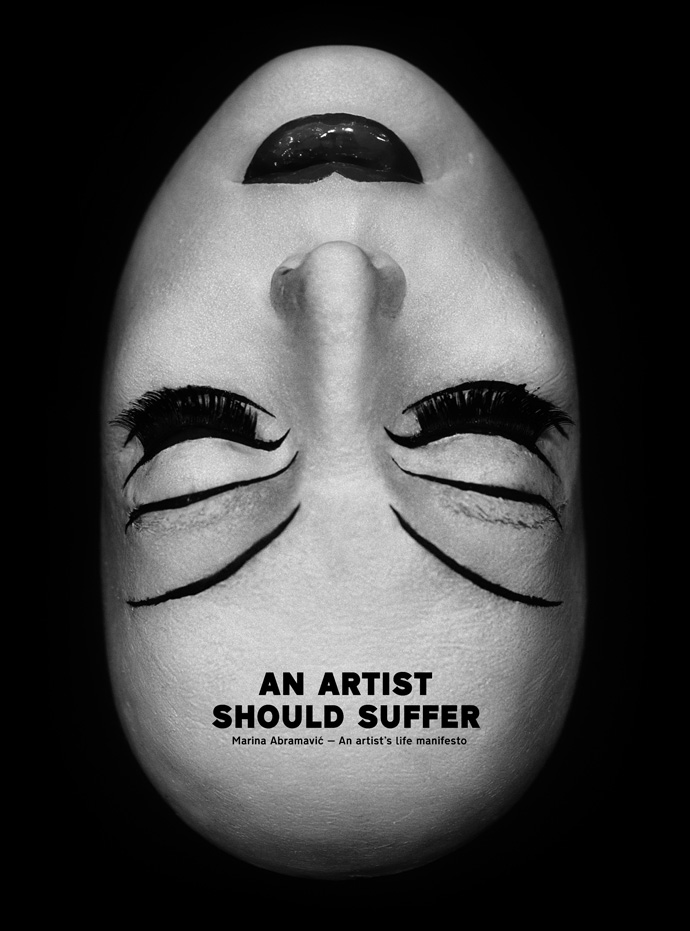 Death mask of Marina Abramović. Photography by René Habermacher
Death mask of Marina Abramović. Photography by René HabermacherRené Habermacher: With this piece you staged something that you call artificial theatre. It lacks the realness that is central to your work. How was this experience for you?
Marina Abramović: I am his material. I completely gave all the control to Bob (Robert Wilson). That is the only way to really be material for someone else, which is very interesting, because its just absolutely the opposite of what I do. This is first time that i have this really radical approach with Bob – he absolutely refused anything to do with performance. This was an amazing experience for me and very difficult, because his approach to rehearsal is like mine to performance, – but yet it’s just rehearsal! Just be there for hours and hours in order for him to fix the light. I lose my reason, I need the public, I need another kind of dialogue. This was a huge discipline not to kill him!
RH: How did this project with Bob come together? (more…)
-

new greek cinema: of WASTED YOUTH and “an old whore in need of love”
-These days we hear mostly troubling news from a country to which its citizens proudly refer to as “the birthplace of democracy”: Greece. Another spiral of economic turmoil unfolding in slow motion casts a spell upon Europe. And yet accelerated by the recent events, a very different wave reaches us from this troubled country: “The weird wave of Greek Cinema” as The Guardian’s Steve Rose titles. The Stimuleye talks to WASTED YOUTHS director Argyris Papadimitropoulos.
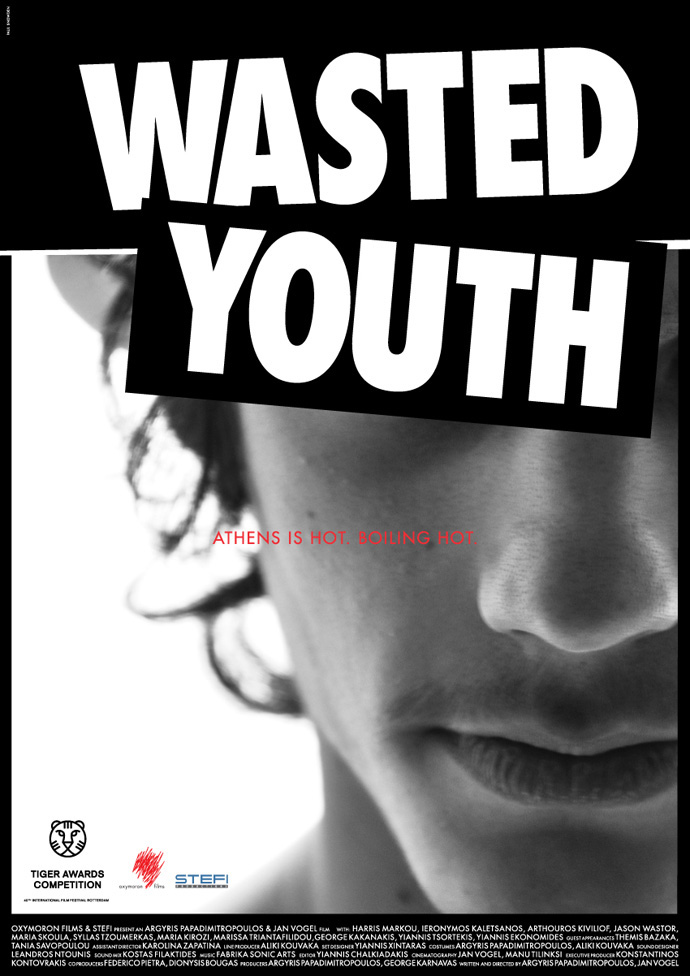 Poster for WASTED YOUTH
Poster for WASTED YOUTHIt’s the late days of summer 2011. A handful of Athenians, foreigners and expats mingle on Antiparos, a small island in the wide open of the blue Aegean. Athens is far and its troublesome agenda on a halt.
As the night falls scenting the breeze with jasmine, the open air cinema Oliaros, a local institution, announces tonight’s screening with notices on poles and walls: WASTED YOUTH, the film that earlier this year had opened Rotterdams Film Festival. The film’s director, Argyris Papadimitropoulos, hands stickers to the arriving guests: WASTED, MALAKA (wanker), YOUTH, LOVE….The film is set during a hot summer day in Athens. Much like the city itself, exhausted, confused, unable to make any progress, brimming with desperation and aggression, there is Vasilis, a middle-aged man struggling with the mounting stress to cater his family. On the other side Harry, a sixteen-year-old skater. He and his friends are amusing themselves and wasting time away. Their lives intersect in a contemporary portrait of the city of Athens and a society in crisis.
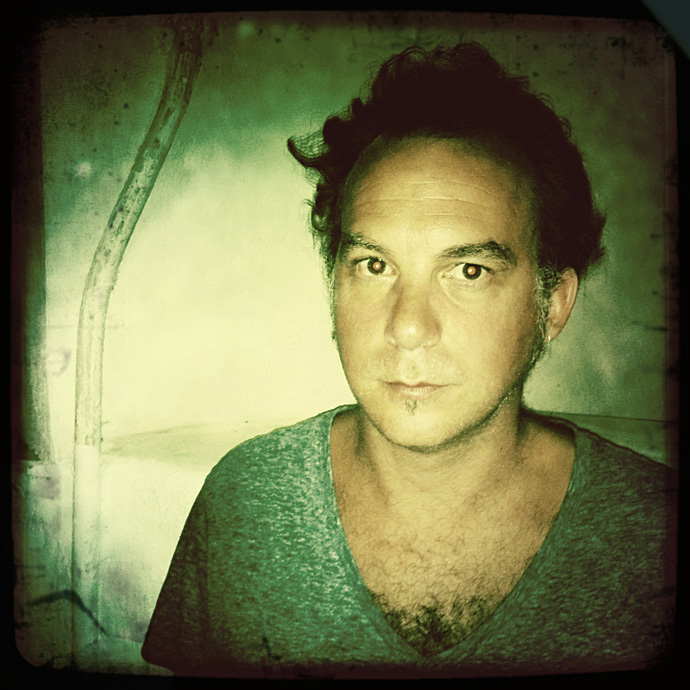
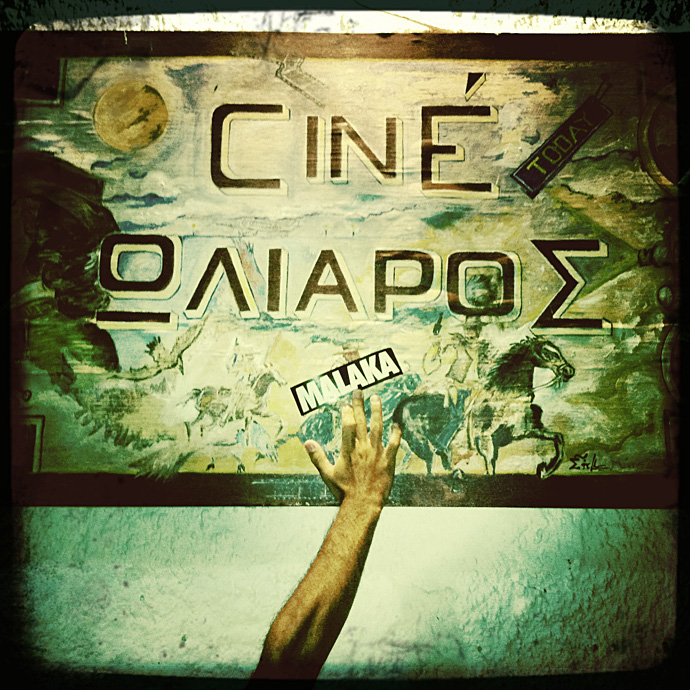 Left: director Argyris Papadimitropoulos at Antiparos and right: Poster of cinema Oliaros with MALAKA sticker
Left: director Argyris Papadimitropoulos at Antiparos and right: Poster of cinema Oliaros with MALAKA stickerRENÉ HABERMACHER: How did that screening at the open air cinema come together?
ARGYRIS PAPADIMITROPOULOS: I am a regular there so I know the guys of Oliaros cinema since… forever. They asked me to do a screening and although I was not allowed to do so by my distributors – In Greece films are supposed to have two runs since we have this open air cinema tradition still alive and very popular – I couldn’t say no. I just love this tiny cinema, and the fact that it is free for everybody to watch the films. There are Greek islands much bigger in population who do not have a cinema and that’s sad.
There’s such a huge part of me and my adolescence in WASTED YOUTH that in every screening I still feel kind of weird… weird in a good way. Since I re-lived my teenage years by shooting this film I feel so exposed. It’s strange telling unknown people so many things about myself. But that’s the magic of it, isn’t it?
WASTED YOUTH had its world premiere in Rotterdam Film Festival in January 2011 and was also honoured to be the opening film. Since then it was screened in more than 30 festivals around the world. In some of the best actually. It was a great year, I spent much of it traveling and presenting the film.
We signed with Elephant Eye Films in New York to represent WASTED YOUTH for world sales. For such a tiny budget film I can loudly say: we did great.Trailer of WASTED YOUTH
R: How was the film generally received by the international audience?
A: I’m more than happy with the comments audience and critics wrote about it.
Screen International described it as “lush, evocative and impressively shot” (laughs).By its career you can tell that the film was received excellent. The audience loved it and the few that hated it, were the ones that gave me the chance to talk, start a discussion, which back in the beginning was the main intention for the film.
I was with my friend and co-author Jan Vogel and we were saying that we need to make a film about these crazy days we are going through and that we need to do it NOW. Some films are made with a sense of urgency. We actually didn’t spent any time writing scripts or searching for funding, but found our amateur teen guys and a couple of good actors and started improvising on a few pages, something like a synopsis. WASTED YOUTH was privately funded by friends and is what you would call 100% indie.R: So it was pretty much a “hit and run”?
A: It was a hit and run urban guerilla thing but shot on film (!), not digital.
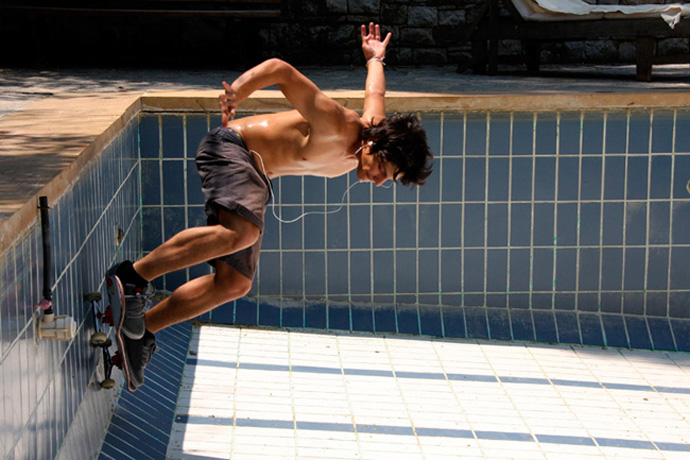 Over the edge: Still from the movie WASTED YOUTH: Harry (Harris Markou) skates in the empty pool of his parents friend.
Over the edge: Still from the movie WASTED YOUTH: Harry (Harris Markou) skates in the empty pool of his parents friend.R: I really liked the scene in the very beginning when the boy wakes up in the morning, somewhere in this modernist building…. that whole sequence to the skating in the empty pool felt really strong… like frozen time.
A: That was our intention. We wanted to go through all the different people, classes etc in the modern greek society.
So the kid wakes up in a house of a lady with what we call “old money” and starts his day under the surface of the earth.
We wanted to have our little symbolisms without making a mind-fuck film.
There a second levels, second readings etc but only for those who want to read them.
I hate the films that are so personal that you will not get them unless you are the person itself (laughs).
I love stories.
I hate smart ass films.R: In my eyes your film looked very authentic- which is quite difficult to achieve.
A: Glad to hear! That was what we wanted to do: a spontaneous film!
R: In a way it also gives a beautiful portrait of the city. How do you like Athens?
A: I love Athens. It’s the place that i was born and I know it as the back of my hand. Athens is a character itself in the film. Its chaotic , crazy and sadly neglected.
It’s the old whore that people love to hate but they love paying a visit. Athens needs a bit of love from the people that fuck her everyday.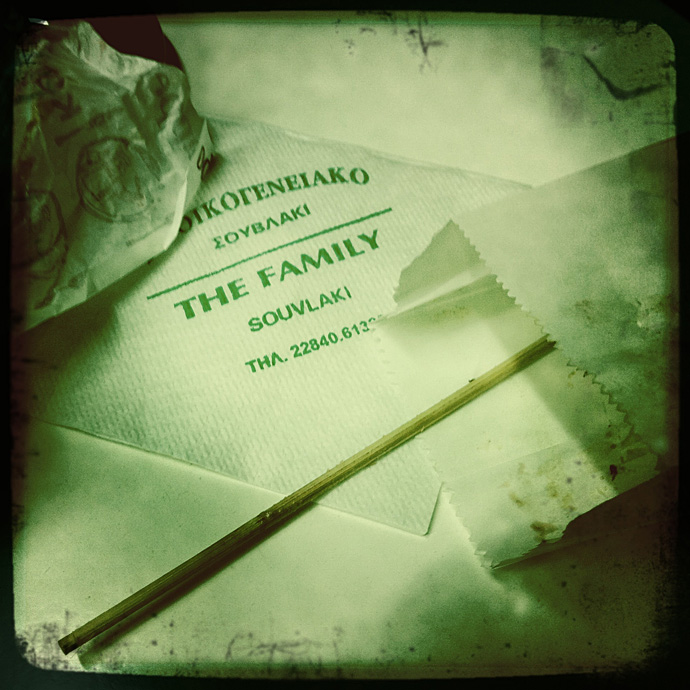
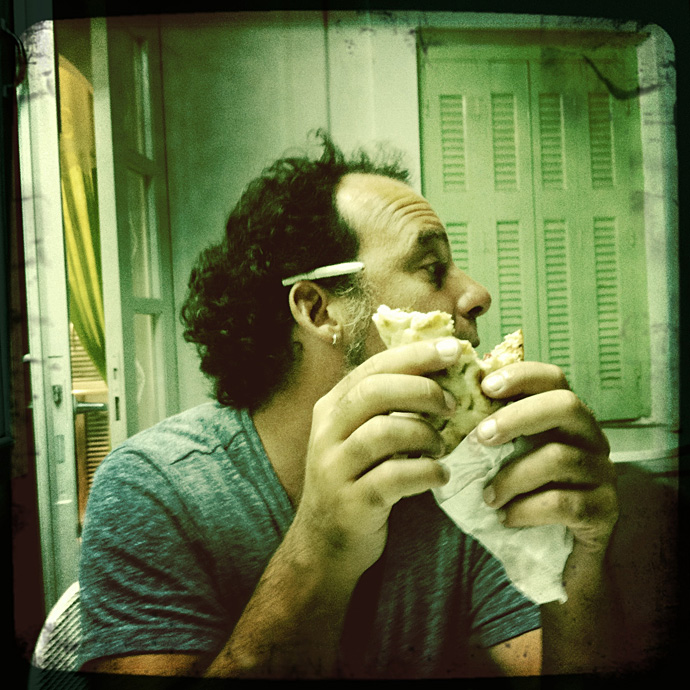 Argyris getting down with more from the spit
Argyris getting down with more from the spitSPOILER ALERT(for the affectionate reader who has not seen the film yet, please skip this part)
R: I was quite surprised at the end when the final “shot” was triggered by the other police man
A: by that I wanted to say that anybody would have done it.
I wouldn’t like the audience to leave the screening and feel sorry about a killer,
since the cops carry guns one day they will trigger them.R: Thats why you left him blank? as a character
A: True, if by blank you mean what I mean.
END SPOILER ALERT
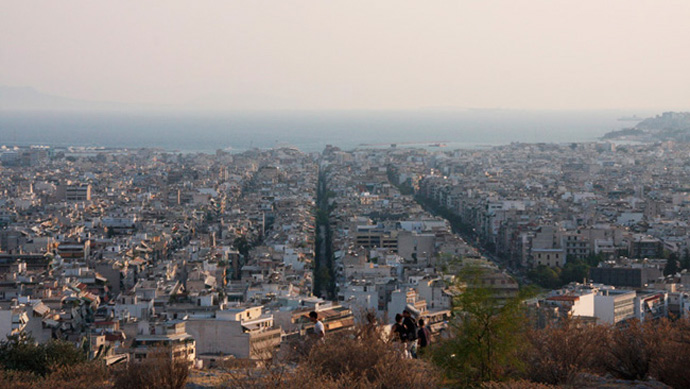 Still from WASTED YOUTH: Athens
Still from WASTED YOUTH: AthensR: The Guardian wrote an article on what they call the “weird wave of Greek cinema”…
A: the fact that the Guardian ran a huge piece on Greek films is already impressive.
A few years back they wouldn’t spend ink on this. That means that there’s something great being born here. I wouldn’t call it a wave and wouldn’t rush to give it names but you can smell something good is going on. There’s no surprise anymore when you see a Greek film in the list of a great festival.
Berlin, Rotterdam, Cannes, Locarno, Venice, Sundance, you name it.
Critisism is there and will always be, there are some people that are sceptical about whatever new is going on and others that want to kill it before it even gets born.
People are not ready for changes, you know.It seems like when societies are on the edge, edgy things come out of their arts. Remember Argentina, Romania and so on.
What was happening in Greece the last 25 years, let’s say from the early 80’s till the olympics was a fake paradise:
a fake prosperity with fake money, fake happyness, fake tits, fake, fake, fake …A fake new identity that never made it to the core of neither our souls nor our society – it collapsed in a few days.
One day they told people we are in crisis and people believed it the same day, so there were no solid foundations in this “new order” that was fakely established.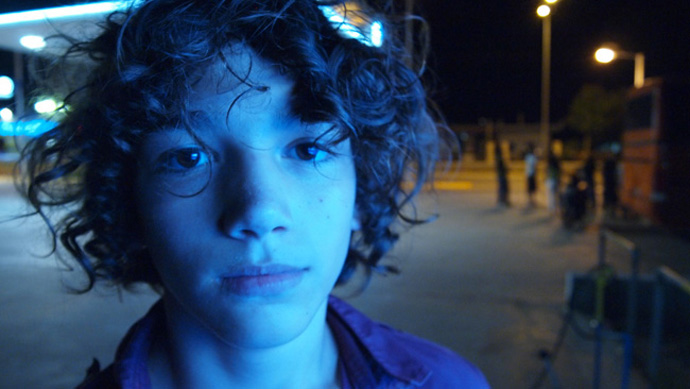 Still from WASTED YOUTH
Still from WASTED YOUTHR: To come back to one of the most interesting things about the article of the Guardian, it were the comments by fellow Greeks being often malevolent, accusing the directors of plagiarism in the case of Dogtooth, or calling the films “a product of mental health problems”.
A: hahaha! that’s great fun.
People cannot accept themselves. When somebody puts a mirror in front of them they can’t cope.
A product of “mental health problems” is the society we use to live in, so are the films as they are suppose to reflect the society.
As for the plagiarism: I would just say that there were very few people saying so, but they created a huge buzz. These people are the ones that do not like the success of someone else because they are stuck in their thing.The greatest festivals in the world are not stupid to have a work of plagiarism in their catalogue.
Also, plagiarism in art is a huge topic that it is almost impossible to discuss: almost every great artist was accused of that!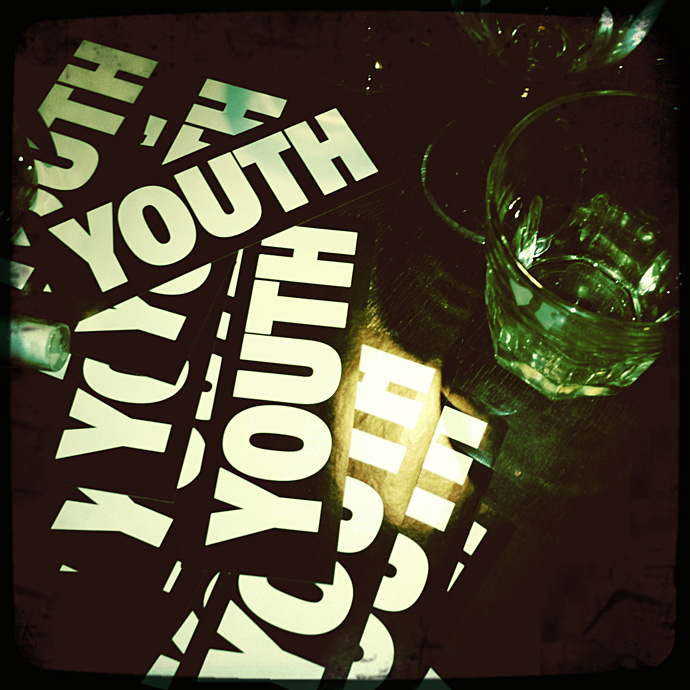
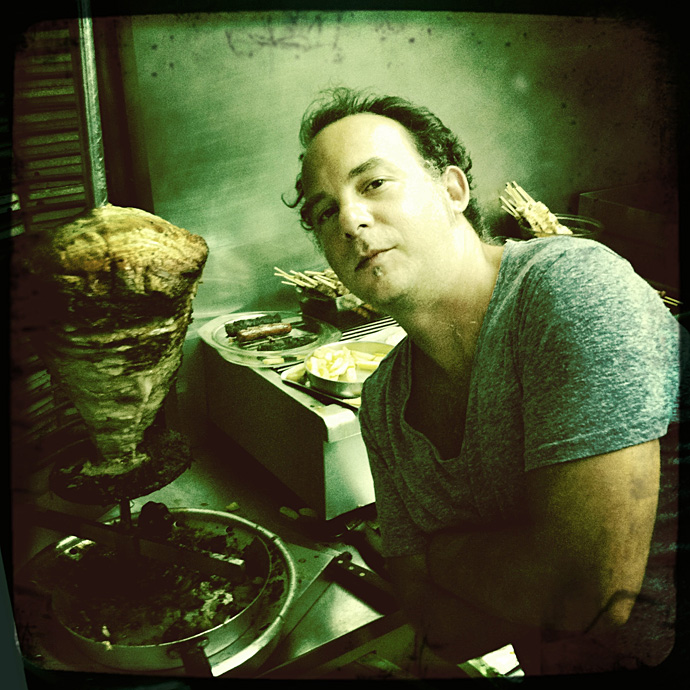 Argyris at his favorite souvlaki place in Antiparos.
Argyris at his favorite souvlaki place in Antiparos.R: I thought this was a very typical reaction. In a recent article for Vanity Fair Michael Lewis puts it like that:
Individual Greeks are delightful: funny, warm, smart, and good company. I left two dozen interviews saying to myself, “What great people!” They do not share the sentiment about one another: the hardest thing to do in Greece is to get one Greek to compliment another behind his back. No success of any kind is regarded without suspicion.A: I wouldn’t agree. If you look at the end credit of all this films that made it to the great festivals the last few years, you will realise that everybody helped on each others work. Greeks are easy target to be accused for almost anything since we have this fucked up temper. But on the other hand you can tell that there is still solidarity and support between most of my fellow greek film makers for example.
R: What are you working on next?
A: I write a couple of scripts with friends. Things are hard these days but we’ll keep trying.
I would like every film I make to be so much different from the other. I would also love to make a film abroad, although I love Athens.
Paris, London, Berlin, New York, Rio, Buenos Aires – there are stories everywhere that i would love to tell…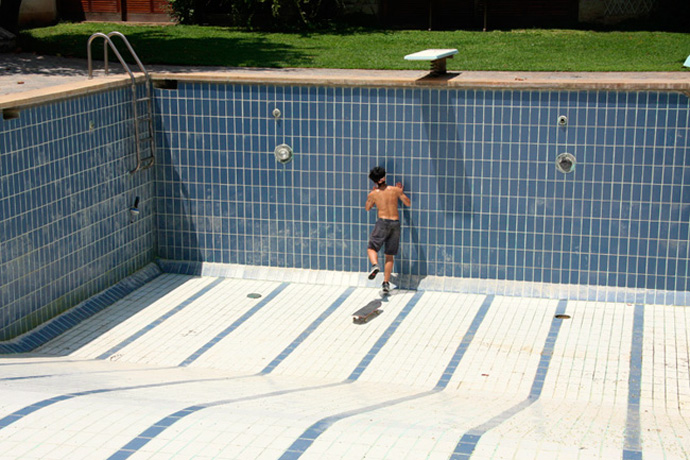 Still from the movie WASTED YOUTH: Harry (Harris Markou)
Still from the movie WASTED YOUTH: Harry (Harris Markou) -

not lost : ræve
-Once upon a time, we made a fashion film shoot with some of the best men’s designs around.
Givenchy, Raf Simons, Ann Demeulemeester, Rick Owens, Gareth Pugh, Comme des Garçons…we had it all. We also had a great concept (think butoh meets inception), a fantastic cast (Ippei is an amazing butoh performer, while Matvey and Willy, both top men’s models, would film Woodkid’s IRON video a few days later), great hair and great make-up, everything great.
RAEVE stroke-inducing poster by Clément Roncier.
Only problem was, we never really found the time to edit it.
Until now.
So without further ado, ræve.
RAEVE
by Antoine Asseraf & René Habermacherstarring Ippei Hosuka + Willy Cartier @ Success Paris + Matvey Lykov@ Success Paris
styling Jean-Luc Française / photo assistant Laurent Dubain / styling assistant Tiphaine Menon / hair Tanya Koch @ B Agency /make-up Akiko Sakamoto / studio Le Petit Oiseau Va Sortir
editing Axelle Zecevic / Clément Roncier / postproduction Clément Roncier / music Oedo Sukeroku “Shunrai” + John Cage “Sonata V” / special thanks Jean-Marc Locatelli
-

THE BERG SANS NIPPLE
-‘Build With Erosion’, doesn’t pertain to any set form or principle. It’s a challenge: a deeply experimental and infectious third album from The Berg Sans Nipple, combining devastating melodies and a mind bending rhythm section informed by disciplines as diverse as gamelan, dancehall and DC Hardcore. THE BERG SANS NIPPLE is Lori Sean Berg and Shane Aspegren.
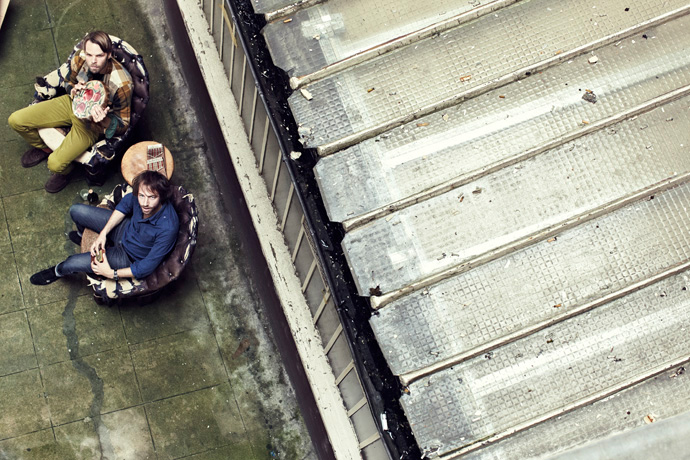 Lori Sean Berg and Shane Aspegren jamming on a cloudy day in Paris. Photo by René Habermacher
Lori Sean Berg and Shane Aspegren jamming on a cloudy day in Paris. Photo by René HabermacherWhat was the last thing that inspired you?
S: That’s a hard one to answer. As time goes on, it’s a lot harder to be really be blown away by things. We just did the project with Le Musee Du Quai Branly in Paris and had the chance to dig through their audio archive. This was really refreshing to work on to discover new sounds from around the world. Also, Lori and I saw the Anish Kapoor installation at Le Grand Palais together and that was really amazing. It was something that you needed to spend some time inside to appreciate the full effect. I suppose we like things without immediate gratification.
Can you remember a particular inspiration for your latest album BUILD WITH EROSION?
S: The record was created over such a long period of time that there were so many things that were poured into it. In the end, the theme of erosion was really important.
L: We use a lot of eroded musical equipment. I’m not sure how to say it? We love dust!
S: In a way it’s always been a theme of the band… using instruments that are on their way out, or loving the sounds that came from pedals with dying batteries…
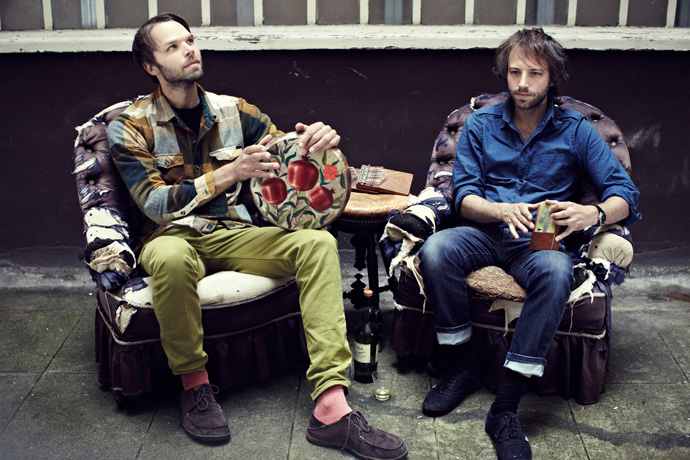 THE BERG SANS NIPPLE in action. Photo by René Habermacher
THE BERG SANS NIPPLE in action. Photo by René HabermacherIs the concept of “erosion of instruments” something that interests you conceptually or is it the frailty of sounds created?
S: I guess it’s both of those things. There’s always been a balance of harshness and beautiful sounds in there. Also, lyrically, it all ties in together, but that’s all there for people to digest as they’d like.
L: I love instruments on their last legs. I want to give them a second life
Tell us a little more about why you work with concepts. In advance of the album release, you set up a site for BUILD WITH EROSION incorporating the surrealist concept of the exquisite corpse. You used this concept again for the promotional video for Change the Shape. Why?
The Berg Sans Nipple – Change The Shape from Clapping Music on Vimeo.
S: A band that I was part of back in the late 90’s used to make exquisite corpses in the van on tour and, at that time, I was really into the Surrealists. I’ve always wanted to do a project like that and it worked really well with the “Change the Shape” theme. It also gives a different energy to a project when you can get a bunch of other artists involved.
L: Although “Build with erosion” is not a “conceptual” album…
S: Maybe not conceptual in the sense of advance planning but, in the end, it developed into a unified concept. Things become what they are and it all makes sense together.
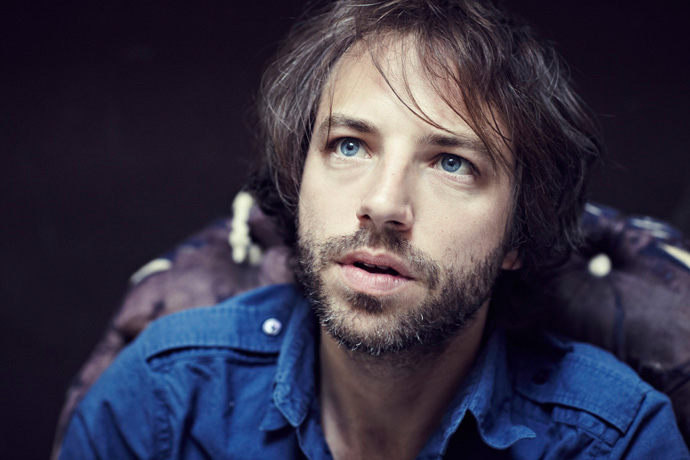 Lori Sean Berg of THE BERG SANS NIPPLE
Lori Sean Berg of THE BERG SANS NIPPLEOne of my favourite tracks on the album is DEAD DINOSAURS RULE THE EARTH. How did that track develop?
Dead Dinosaurs Rule The Earth – The Berg Sans Nipple by blackmaps
L: From Zari!
S: Of course, the title came from my daughter and I jotted it down in a notebook. We had a bass line and drumbeat in a tape full of improvs that we had done together and I thought that the title was perfect for the bass line. As always, it went through a lot of transformation to get to the end of that track, but it all stemmed from a child’s mouth and an improv.
L: An old old idea. Probably recorded from my minidisc.
S: Yep, that wasn’t one that we created from opposite sides of the world. Apart from the lyrics, it was worked on in an old fashion style, when we were together. I think even all of the kalimba lines were from that minidisc!
Lori, you live in France and Shane, you live in Nebraska. Do you work together while living apart by exchanging ideas or do you tend to do most of the work in the concentrated periods when you are actually together?
L: We really need to be together for “the moment “. But maybe we could do a conceptual album through skype next time?
S: It’s really combination of the two. The best stuff comes out in the concentrated periods of being together though. The brooding and frustration comes at the other points, but then gets weeded out when we meet up again.
L: That sounds agonizing. But when were together we have a lot of fun, we play pinball and drink wine and champagne.
S: visit caves…
L: and meet cavemen…
S: Cro-mags from the perigord noir!
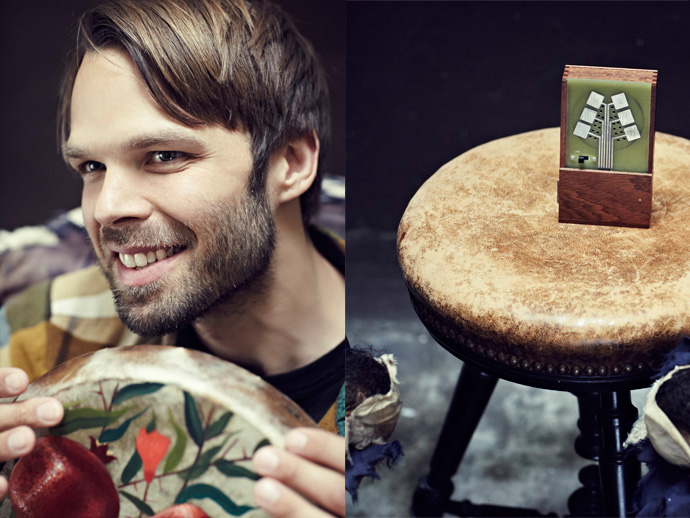 Shane Aspegren has a fable for unusual soundtools..
Shane Aspegren has a fable for unusual soundtools..The Berg Sans Nipple is known for its amazing live shows. How do the two of you go out there and recreate the complexities of your sound?
S: We started as a live band. In fact the first few shows we did, we never repeated any of the music that we made, but were really just writing a set of music to perform live. Now thing are a lot more complicated in that we’re writing in the studio and then trying to figure out how to transform that into a two person live setting. I love both sides, but it’s become more challenging as things have evolved.
L: It’s always a “casse-tête chinois” when we play shows! I think it would be much easier for us to simply work in the studio. But it’s important for us to play live music… to be connected with people.
S: We’ve always tried to make a connection between each other, even through sampling each other live and setting up face-to-face. I think that was our first goal in playing with each other. So the idea was the inception of the band. And hopefully that’s how we connect with our crowd.
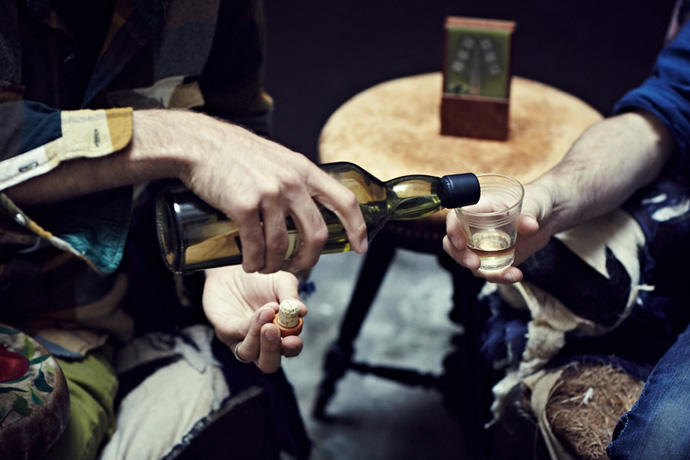 ...and malt brew
...and malt brewYou both work outside the band, including work in film and photography. Do you have any favourite photographers or visual artists?
S: I have a hard time pinpointing favourites of anything. I was really into Robert Frank and Duane Michaels and photographers like that when I first started taking photos, but there’s a lot to love about so many things. I like colour a lot more now. But speaking of visual artists, we’re really lucky to have been working with Cody Hudson and Stephen Eichhorn (who were responsible for the artwork for “Build with Erosion”).
If THE BERG SANS NIPPLE could work with anyone who would it be?
L: Johnny Cash.
S: That’s interesting. I feel like it’s always the thing that’s the most exotic that interests both of us, which is maybe why the trans-atlantic game works for us. I’d probably say that scoring something with Ennio Morricone or maybe even moreso, Bernard Herrmann. It wouldn’t necessarily be a film though… maybe something in a public setting. Or we could score Johnny Cash’s life.
In what direction do you see THE BERG SANS NIPPLE developing into in the future?
L: Pinball sound design. That is the future for me!
S: If Lori is going to go off on his own to get lost in pinball world, then I guess that it’s, the end! We’re trying not to focus too much on the future but to work on the present as much as possible. We’re starting to do a lot more film work together and that’s what we’re really interested in. I don’t see us ever stopping making music together, but we’re also ready for another step into other things. We’ve got another project in the works as well… a new record with a different concept that won’t necessarily be the BSN, but will still be in the same spirit.
-

the end of summer hypernation
-The Stimuleye is back from summer hyper-hybernation.
After a galloping transatlantic spiral of frenzy, we lay exhausted for days on various shores around the globe. Meanwhile, not entirely lazy, some of the Stimuleyes danced away in Watermill or invented a bookclub of a new, performative kind, shuffling readings of MANHUNT, STILETTO and Jackie Collins’ masterpiece THE STUD into a new, exciting bootleg. But more about that later.
During this hot days another Stimuleye project rushed through printers rotation: a collaboration with Marina Abramović featuring Freja Beha Erichsen photographed by René Habermacher for POP magazine.

 Freja Beha Erichsen and Marina Abramović, both posing with Marinas "mini-me" and wearing GIORGIO ARMANI
Photography by René Habermacher
Freja Beha Erichsen and Marina Abramović, both posing with Marinas "mini-me" and wearing GIORGIO ARMANI
Photography by René HabermacherThe Fall Issue will feature 2 covers with Marina and Freja and an inside story with exclusive interview, plus a limited edition hardback showing Marina’s death mask. Some of our fellow readers might recognise another co-star: yes, it’s Daisy the Boa which we met in Manchester, in an attempt to strangle the alter ego of Marina, her “mini-me”.
Coming soon to the newstands, the new POP is investigating this time THE REDEFINITION OF THE LADY. As Ashley Heath, its publisher puts it:
“POP has been exploring the notion of a very particular kind of modern fashionable woman. But it’s shifting all the time in such an interesting way. There’s a very liberated, new-world perspective to it and I think Marina Abramovic taps into that. She’s a figure who will only continue to grow in influence I believe. You hesitate to use the word ‘icon’ these days, but Marina and Freja are both resonant female role models at a time when lowest common denominator so often rules the day”
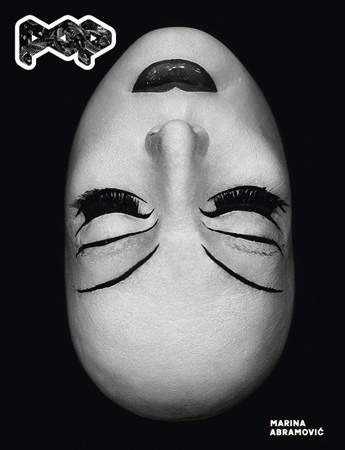
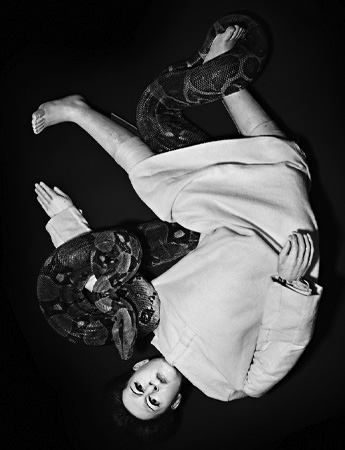 POP's Special edition Hardcover with Marina Abramović's death mask and "mini-me" wrestling with Daisy.
Photography by René Habermacher
POP's Special edition Hardcover with Marina Abramović's death mask and "mini-me" wrestling with Daisy.
Photography by René HabermacherMARINA CREDITS: Styling Isabelle Kountoure , Hair by Chi Wong at Julian Watson Agency using Shu Uemura Art of Hair, Make-up Yannis Siskos at Effex using Giorgio Armani Cosmetics, Photography Assistance Jonathan Flanders & Hannan Jones, Digital Remastering The Stimuleye, Snake Wrangler David Steward for Creature Feature, Production Lynsey Peisinger for The Stimuleye
FREJA CREDITS: Styling Isabelle Kountoure, Hair Peter Gray at The Collective using Shu Uemura Art of Hair, Make up Romy Soleimani at Management Artists, Manicure Tracelee Percival at Vue using Priti NYC, Model Freja Beha Erichsen at IMG New York, Casting Angus Munro at AM Casting, Streeters NY, Photography Assistance Cesar Rebollar, Fashion Assistance Jodie Latham, Stephanie Waknine, Rebecca Sammon & Michaela Dosamantes, Digital Technician Dilek Islidak, Digital Remastering The Stimuleye, Set Design Anne Koch at CLM NY, Production John Engstrom at Scheimpflüg Digital, Shot at Eagles Nest Daylight Studios NYC
-

editor MASANOBU SUGATSUKE : An edit of an edit
-Masanobu Sugatsuke is one of the most influential editors, publisher of magazines such as COMPOSITE, INVITATION or METRO MIN in his native Japan, and of books with Mark Borthwick, Elizabeth Peyton or Jeff Burton. Masa considers himself not exactly a trendy person, yet is always on a forward trail, much ahead of his time.
THE STIMULEYE talked with Masa on the outlook of publishing and the editors future role, but also his recent book EDITORIAL PARADISE in which he is looking on his past editorial work. A reflection in a radical manner, rarely dared by others of his guild.
An edit of an edit, a compilation of compilations?
He’d been advised by a fellow columnist that “When an editor enters the spotlight, he automatically announces that it is time for him to go” he was told, as well as “an expression reaches a deadlock the moment it becomes self-referential”.“But wait a minute,” he writes in his foreword, “Godard and Truffaut initiated the Nouvelle Vague with their filmic reflections on film; contemporary art has developed as a form of “Art reviewing art”, and Rei Kawakubo and Martin Margiela keep proposing dresses that inspire the wearers to think about dressing. Could it be that there exists a whole different level that self-expression can only reach after going through the painful stage of self-reference?”
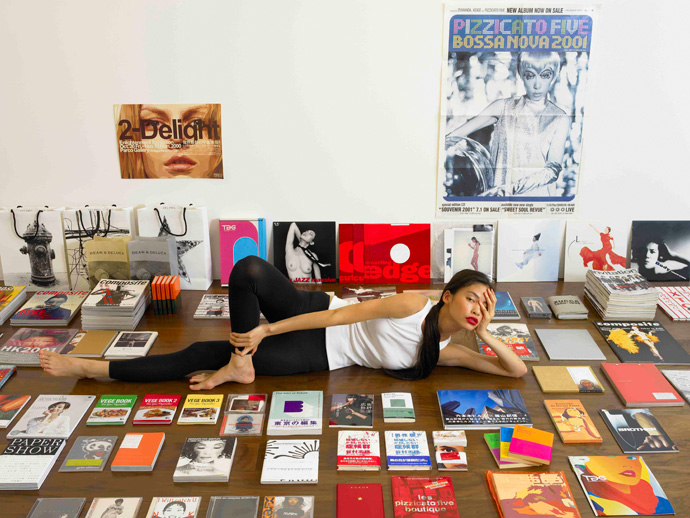 Works of Masanobu Sugatsuke laid out for EDITORIAL PARADISE.
Works of Masanobu Sugatsuke laid out for EDITORIAL PARADISE.When i visited you at you last time in Tokyo at your office – we had not seen each other for quite a long time.
Meanwhile you had halted “Composite” , and published your book “Editorial Paradise” revisiting your inventive editorial work of the last 25 years. Interestingly, this reflection coincided with a turning point, a time where the role of the editor is challenged through mechanics introduced by new media. To me it almost felt like a “katharsis” (精製) – in this context. Not only a personal one…
Talking about my book “Editorial Paradise”, I think that a retrospective book of a living editor sounds strange for everybody, even for me!
But to edit and launch it, it made me consider a lot about the role of editors and definition of editing nowadays.
I believe the role and definition of editors and editing has been drastically changing these days, because of the growing role of new media. But a few editors have been trying to define their new roles and public meaning.“katharsis” you mentioned is quite a suitable word to describe my time editing this title. Editing this retrospective is like confession for me. But confessing what?
I can tell you about it clearly now, I didn’t know the meaning of editing until that time.For this book you told me you’ve decided to include everything from the volumes that you’ve done, which is somehow “anti-editing” – was that part of making you realise the meaning of editing? What is your conclusion?
I’ve always aimed to expand the definition of editing. Through the editing process of this editorial retrospective, I recognized that the changing state of editing my thinking simple-minded.
So, what I came across through this process, – it was fun but hard for me to think deeply about editing all the time all day long and I felt like being ouroboros – is that editing is not about media.
I think editing is a way of thinking. It’s not like making film, designing a website. It’s a purely abstract idea to make something concrete.My definition of editing is quite simple.
1: Drawing up a project,
2: Recruiting a team of collaborators,
3: Creating something,They are the three basic conditions of editing, I think. If someone does something with these three conditions, whatever it is, I’d like to say “that’s editing”.
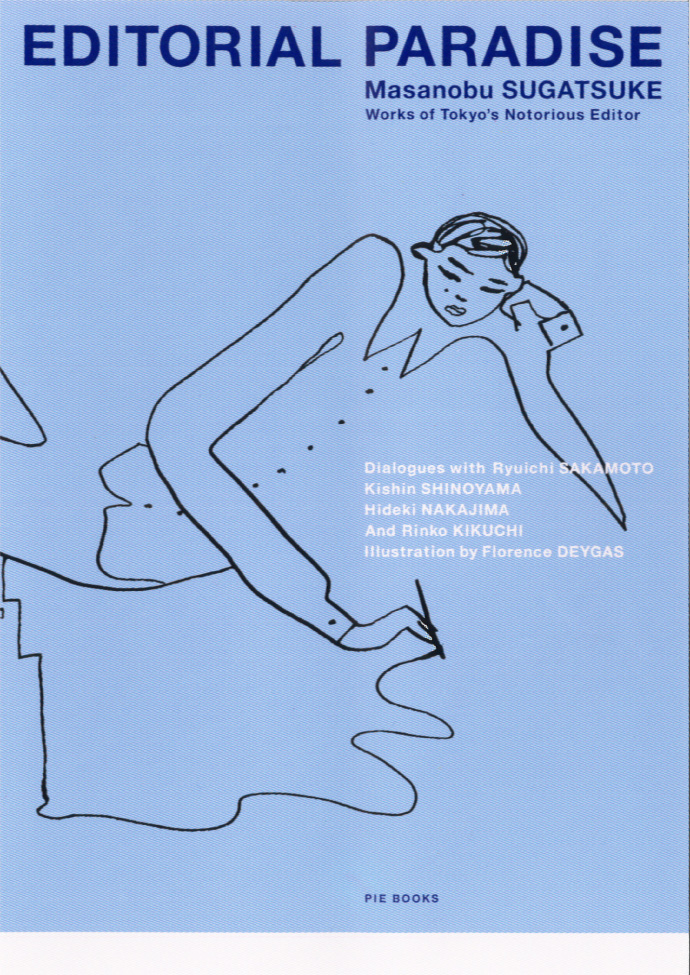
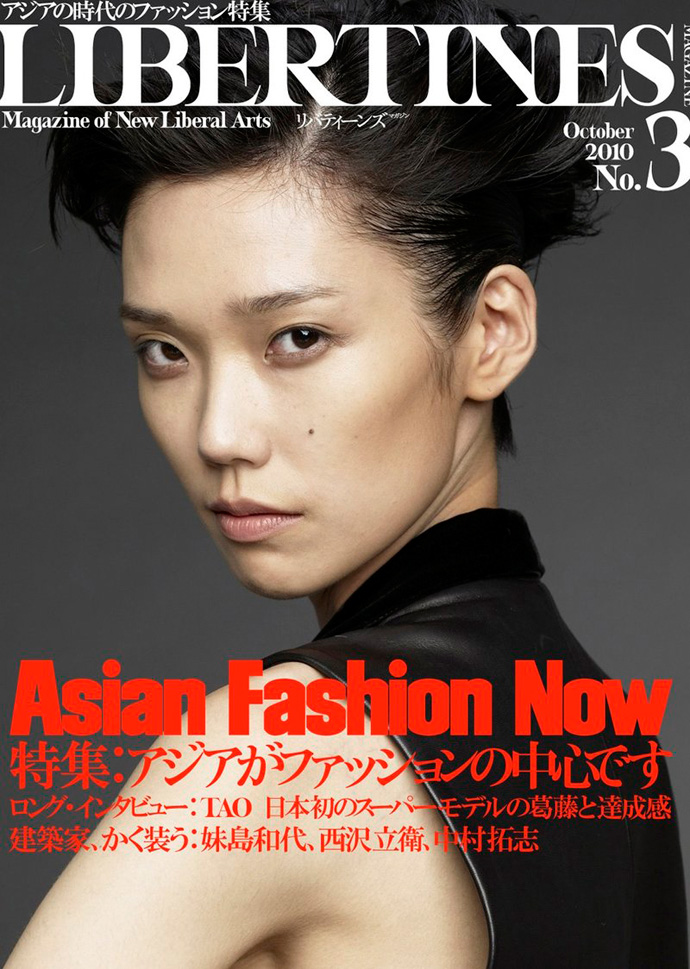 Sleeve of EDITORIAL PARADISE with an illustration of Masanobu Sugatsuke by Florence Deygas and a recent LIBERTINES cover
Sleeve of EDITORIAL PARADISE with an illustration of Masanobu Sugatsuke by Florence Deygas and a recent LIBERTINES coverIt’s something rare in this profession to put a focus on the act of editing itself, especially one’s own and in such a radical way as with your latest book.
As you can see, editors have been defined as interpreting someone to someone else, or something to something else. That means “Don’t express your own voice through your works. You are an in-between guy!”.
That’s 50% right. But there are so many high-profile advertising creative people all over the world. They are not behind the media at all nowadays.I believe editors are mainly present in-between and behind media, but sometimes they are beyond media, i.e, Anna Wintour, who is Cabinet Minister of the Ministry of Cool, Terry Jones, Everlasting Evangelist of Street Style and Olivier Zahm, the second Gainsbourg.
I believe we, creative people, have to label ourselves. In other words, we have to “transform life into creation”.
Because, in this 21st Century, our creative lives are almost viewed and leaked by web and twitter.
It’s been getting hard for creative people to avoid being watched or criticized by ordinary people now.Iconic editors from the past seem in this context like vanguards of another time to come:
Diane Vreeland (American Vogue) or, on another side of the spectrum, Hugh Heffner (Playboy), both transcended their editorial vision with their personal lives.Today’s ever more fragmented stream of information requests perhaps a stronger necessity of structure through the personal standpoint…
How do you think the element of today’s over-exposure is influencing the role of the editor?
Over-exposure is big phenomena in our world, not just for editors. Modern people are fame-addicted.
On the other hand, we can show our way of living as an art piece. Lady Gaga’s case is the most excessive one, and Haruki Murakami’s case is the most stoic.
But both are most successful presentations of life as art piece today.As I said, our creative lives are mostly viewed, watched by the media and each action are “timeline”d.
So if you can’t avoid it, you have to be determined to show your life as whole art piece, as if Andy Warhol presented us.
So, Warhol said “Everyone will be famous for 15 minutes” in the 60’s.
But now everybody became Andy Warhol, just like taking photo everyday, quoting somebody’s ideas and images and commenting as one phrase philosopher on twitter or blogs.Our creative works are slices of our creative lives. People nowadays have a tendency to prefer the real lives of creative people to their work.
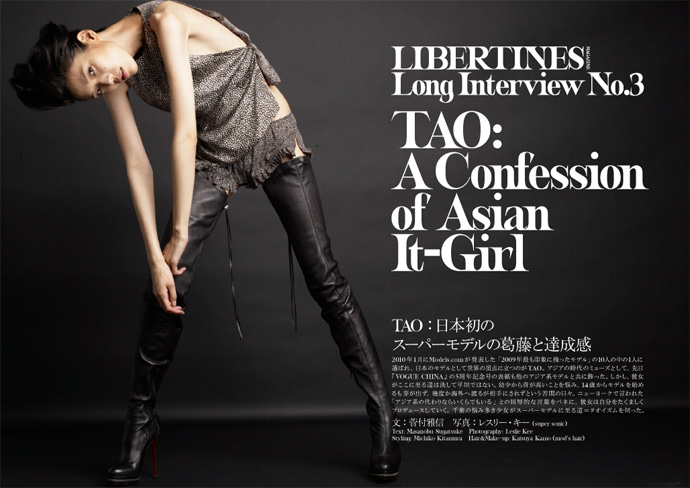 Spread of "AISIAN FASHION NOW" from a recent issue of LIBERTINES. Photo by Leslie Kee
Spread of "AISIAN FASHION NOW" from a recent issue of LIBERTINES. Photo by Leslie KeeIn these times, the stream of facebook statuses, tweets and re-tweets, tumblr and so on form a new way of consuming information.
You recently mentioned Paper.li to me – which seems like an attempt to “master” this stream almost a form of an “automatic generating editor”….Yes, “Paper.li” is a kind of semi-auto-updated personal web magazine. On the web, if you curate something, you can be an cool editor. Therefore “first hand” is getting more important for media and creative people. Audiences can’t get interviews of celebrities and take their photo first hand.
So, “first hand” sources and high profile people are the last sanctuary of professional media and creative people.
But if they are lazy to maintain “first hand” capability, audiences will rob it.The internet is certainly a big accelerator of this “theft”!
What we’re missing out besides “first hand” is the synthesis of information and its digestive analysis.
I am wondering how do you expect the print media to react to this and how you see its perspectives in the long run, in balance with the digital publishing?I expect that print media will live with digital media in symbiosis. I believe print media will survive, as opera and theatre play do.
But not mainstream in the media.
There are two kind of information, flow and stock.
Internet is a best media of flow information. Print media is a best of stock information.
For creative people, beautiful books must be great tangible assets.
In this 21st Century, tangibility and physical experience can be more important because internet cannot provide them.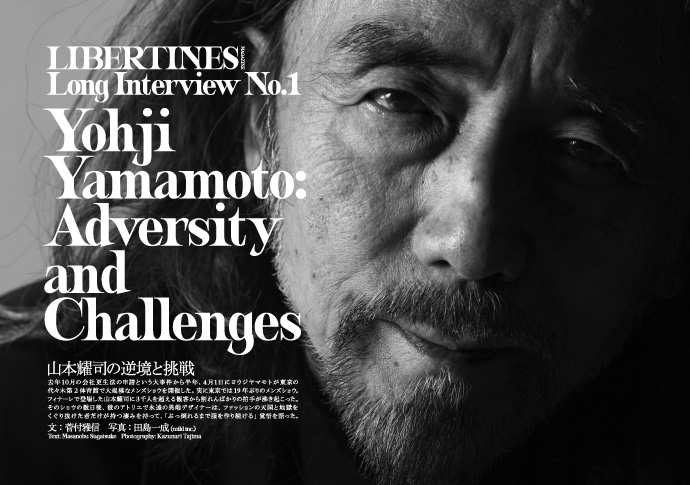 Opener of the Yohji Yamamoto Interview of LIBERTINES
Opener of the Yohji Yamamoto Interview of LIBERTINESYou have recently halted publishing your most recent print magazine “libertines”-
what was your experience with this? Were the reasons related to the shift in publishing that we’re talking about?Talking about the end of “Libertines” magazine, I think I was a little bit too optimistic about the advertising climate and today’s readers. It was my fault.
Advertising for magazine has been drastically decreasing. I knew it. But I had estimated that I could have get a certain amount of it when I started “Libertines”.
But I couldn’t. It was worst time to start a new magazine in Tokyo with a professional level of budget.Plus, I thought we could get a number of readers similar to what we had before. So, for the first issue of “Libertines”, we had a special feature about twitter culture.
We had exclusive report about twitter headquarters in San Francisco in it.
As you can imagine, we got big buzz on twitter and web when it came out.
BUT this buzz were not enough to sell magazine.It is a similar situation for musicians and the web. If some musicians get big buzz on twitter and facebook, but their record sales are not related with buzz unfortunately these days.
It happens in magazine world.I think “buying magazines” has become an old habit, or habit for people over 30’s.
If you aim to produce youth culture-medias and package contents, there are few actual youth consumers who buy them naturally.On the other hand, I’ve been directing another magazine “Metro Min.” for two years as creative director, it is quite successful because it’s a monthly free lifestyle magazine which is published by a major publisher.
So, it is hard to sell magazine to the FREE generation. I’ve been struggling with this issue.
I don’t have a clear solution for it. But I’m not pessimistic about the future of magazines. I think publishers and editors have to organize a new kind of structure to make profit not only to produce print medias.I believe there are great examples in the movie industry. The movie industry is not just about movie theatre nowadays as you know. It is an environment with movies.
I think that’s the hint for editors.

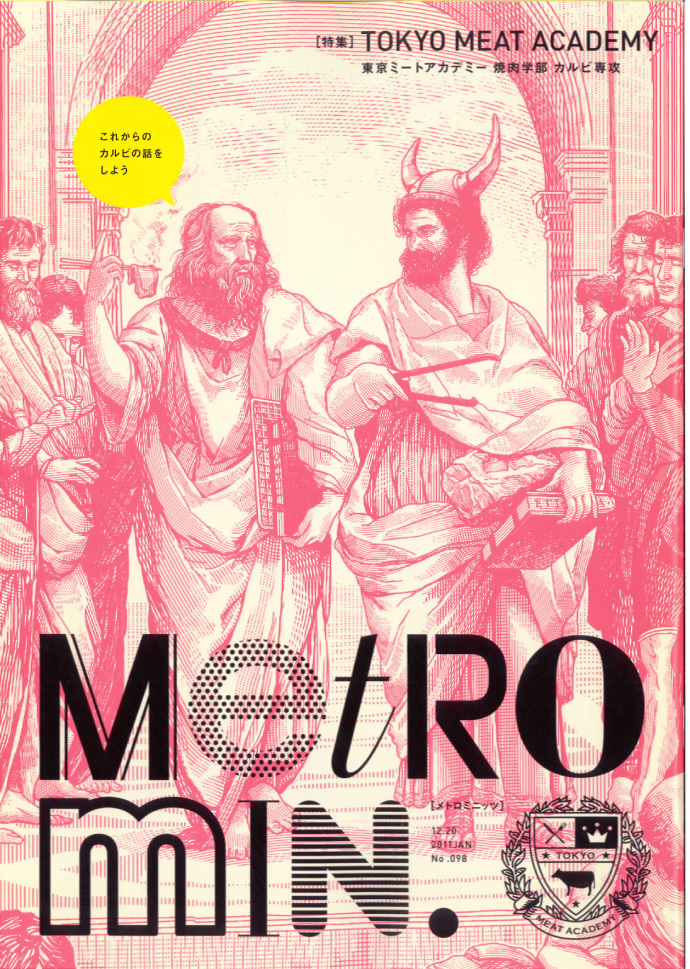 Covers of METRO MIN, the most recent publication of Masanobu Sugatsuke
Covers of METRO MIN, the most recent publication of Masanobu SugatsukeWhere do you see the future?
I’ve been thinking about the fate of both print media and new media all the time as I mentioned in our previous conversations.
And as you see, nobody knows. But there is one certain thing that I can say, that is if you love something, you’d like to own and touch it.
Same as your lover. That’s the human nature which will not change forever.People nowadays talk mainly figures and speed of modern media. But media are not only produced by them. Of course, these specs are important.
But images, sympathies, affections and favoritism are very important elements of media.
If these elements are all included in one media, then it will be a loved media no matter if it’s in the form of digital or print.I believe that creative people have to concentrate on how to produce a loved media to audiences. I think that’s the priority.
The last thing stimulated that stimulated you?
So many things and it is hard to answer to choose one particular thing.
Here is the list what I was stimulated after 3.11, the Great Earthquake in Japan.# Cindy Lauper concert in Tokyo on March 17th, just 6 days after Earthquake.
Cindy is a quite brave artist who did Japan tour in such a catastrophic situation and she commented during each break between songs to encourage audience in Japan.
She sang her masterpiece “True Colors” in encore with mix of John Lennon’s “Power to the people” and almost the whole audience, including me, wept.# Takashi Homma photo exhibition at Tokyo Opera City Gallery in April
Homma’s biggest exhibition in Tokyo which shows his conceptual landscape in Japan and Los Angels which was collaborated with Mike Mills.# Jane Birkin Charity live at Shibuya Club Quattro, April 6th
Jane Birkin is not just an actress or singer. She is a role model of modern women.# Anti-Nuclear Demonstration in Koenji, Tokyo, April 10th
Most biggest and joyful anti-nuke action in Japanese history. So many musicians joined it and I participated in it. People have the power!# Saburo Teshigawara dance performance at Kawasaki City art center, May 6th
It is a final answer to the question “How can movement of human body be radical and beautiful”. Teshigawara does European Tour this Autumn. Must-See!# Henry Darger exhibition at Laforet Museum Harajuku, Tokyo, May
Legendary outsider artist’s big retrospective. So innocent and scary.# Yohji Yamamoto’s 30th anniversary party of his brand at Y.Y boutique in Tokyo, June 1st
Yamamoto is a last samurai of cutting edgy couturier. Congratulation!
-

MARIOS SCHWAB
-MARIOS SCHWAB TALKS TO FILEP MOTWARY
PHOTOGRAPHS BY RENE HABERMACHER
Marios Schwab is known for his unique interpretations of natural forms and his ability to dress the female body in a way that he only knows.
While the world of fashion turns its attention to ephemeral trends, we decide to interview Marios and hear him analyze the Schwab philosophy, his position at Halston and the analysis of his very first Resort Collection, one day before its revealed to the public and press.
His collections are based around reflecting the inner structure of a garment on the outside, a theory that helped to define him as one of London’s most exciting designers – a position he continues to hold.
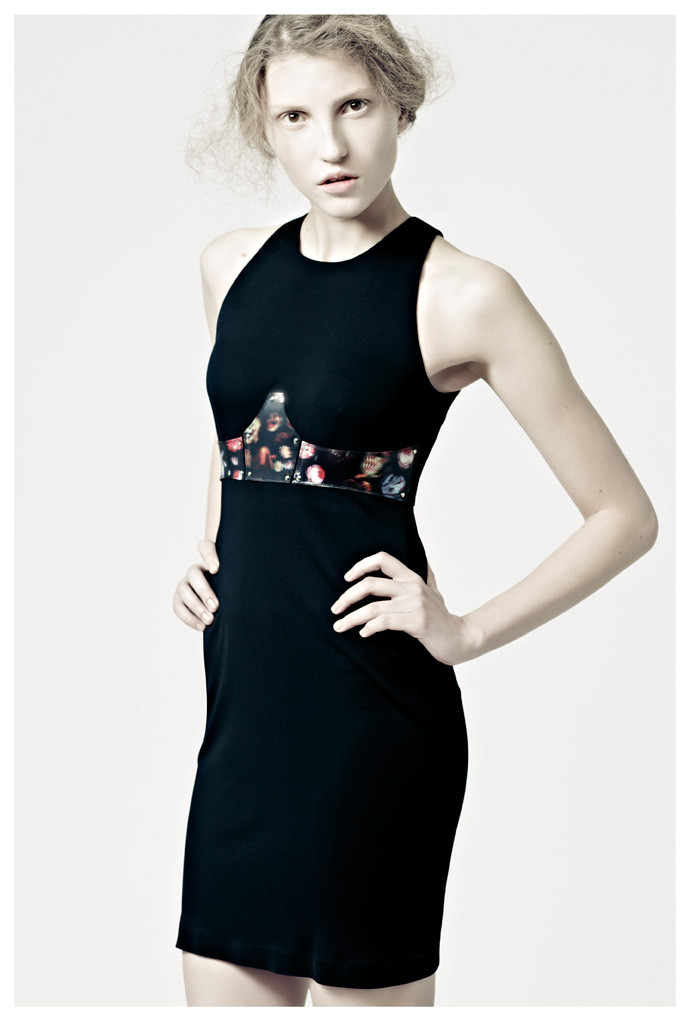 Marios Schwab resort collection 2012. Photography by René Habermacher
Marios Schwab resort collection 2012. Photography by René HabermacherA distinction and Best Student Award graduate of Esmod, Marios moved to London in 2003, where he completed an MA in Womenswear Fashion at Central Saint Martins, studying under the guidance of the formidable Louise Wilson.
Two years later 2005 saw him launch his own label, showing for two seasons with Fashion East before making his on schedule debut at London Fashion Week for SS 2007
Since the Spring of 2009, he was appointed as the creative director of HALSTON in New York.
Schwab’s designs are sold all over the world, in shops ranging from Dover Street Market, Harvey Nichols and Browns in London, to Maria Luisa in Paris and Barneys in New York.
Photographer Rene Habermacher met with him in London for the creation of the pre-collection’s look book
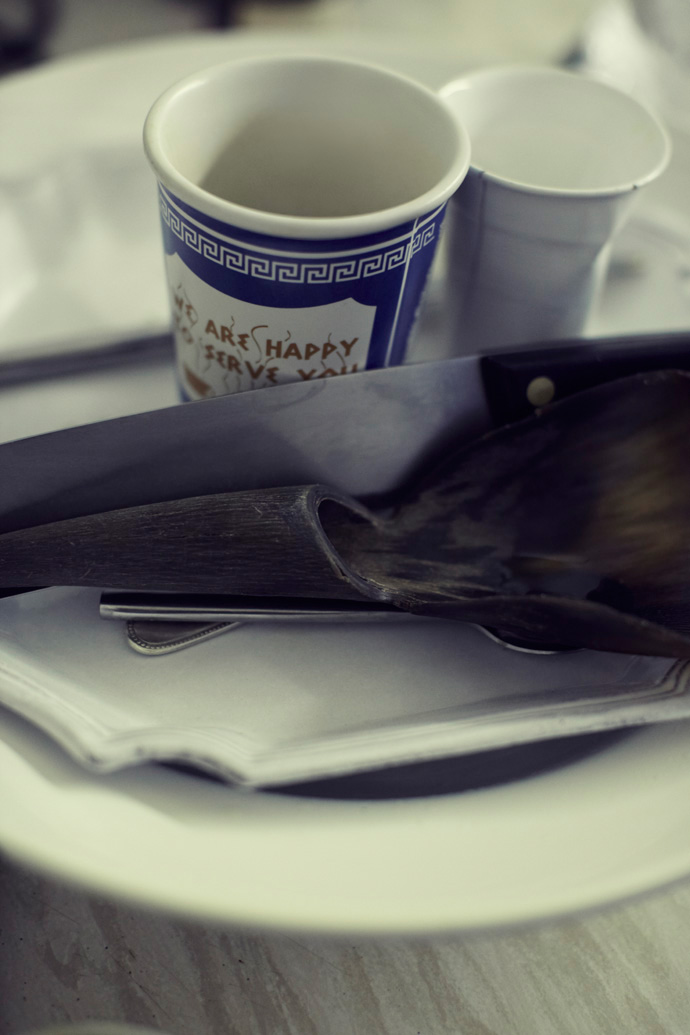
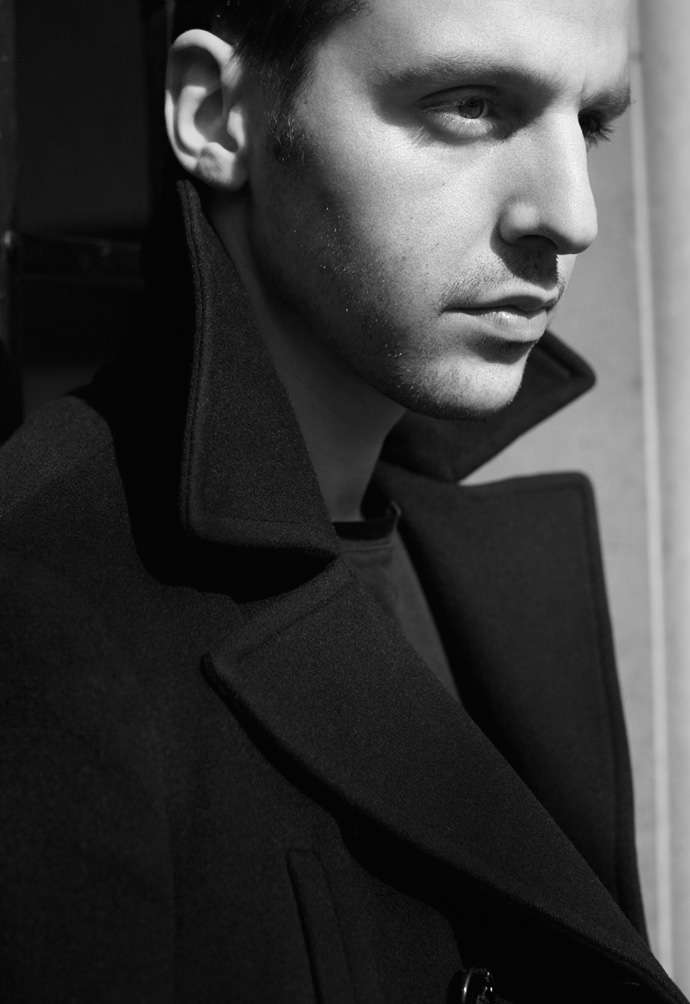 Marios Schwab and his Greek coffee set at his studio. Photography by René Habermacher
Marios Schwab and his Greek coffee set at his studio. Photography by René HabermacherHow are you today Marios, what have you been up-to since this morning?
Pretty much like I came from Paris and immediately started working on the main line…It’s a non-stop situation right now because I just did my first resort collection which was in a way an experiment in terms of getting in right with timings and deadlines, a completely new experience for me. Also we are producing this collection elsewhere outside the UK.
You just photographed your first pre-colection for Summer 2012 yesterday with Rene Habermacher?
We started shooting on Friday; he came over to London and shot the collection in my Studio.
What is your pre-collection about?
I went to Vienna for a weekend where I visited Kunsthalle and saw these amazing series of Vanitas paintings from Dutch painters. For me they always have this feeling of seduction and mysticism that I really like and the hide-reveal again which I am so obsessed about. I wanted to create a print that kind of works color but still within a black background…
It all started with creating the print with artist Tom Galland, who is a friend living near by and with whom we work on numerous collections together. The outlines pretty much echo shapes that have a classic sort of detailing from Maris Schwab, torn down so it becomes easy to wear and accessible for the younger girl that wants to buy, but not necessarily can afford. It’s about clothes for someone who doesn’t want to wear something that is too tailored.
How did you decide to add a pre-collection in your work? Was it after popular demand? What it the aim of a pre-collection anyway?
Yes first comes the “demand” as you said because the main line concentrates on tailored pieces, cocktail pieces mainly, and has the element of fabrics that are more sculpted. There was an easy-wear-feeling missing. You know, easy things that make more sense in a resort collection rather in a mainline. Fabrics like jersey, which is great to wear, in a good quality and good price. Its something that was requested from the top floor but also the feeling of having to return back to something that is a little bit younger was very very important to me.
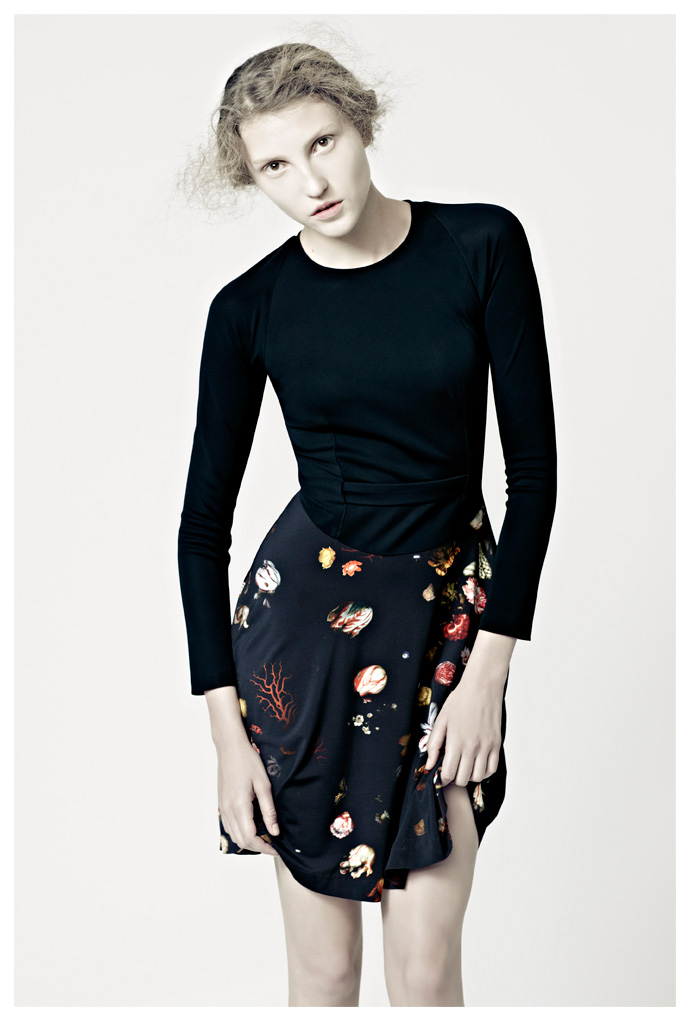
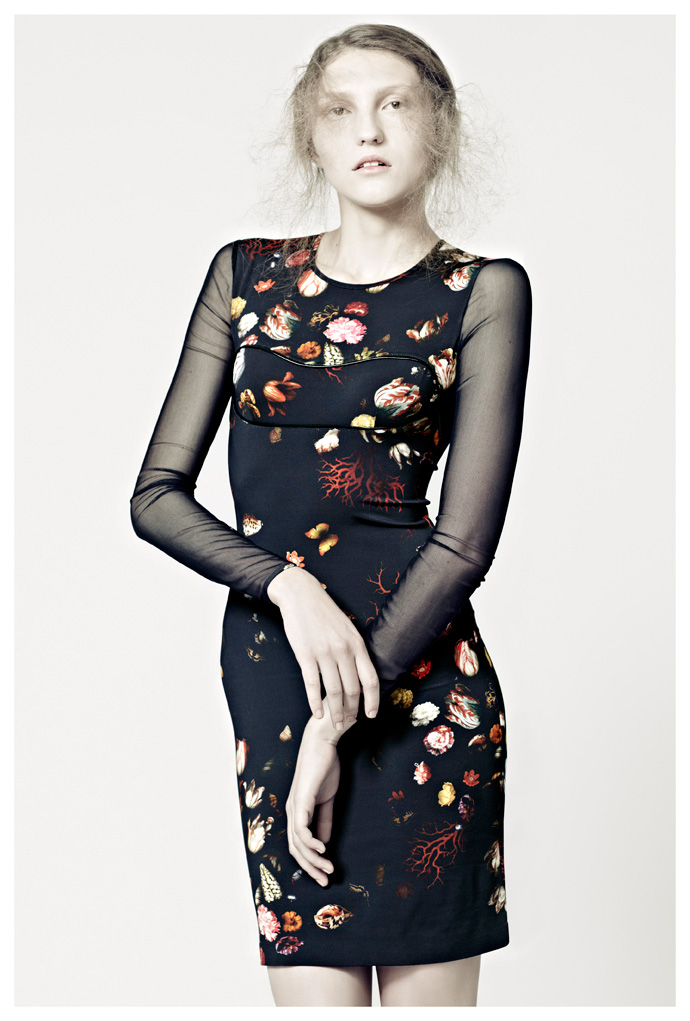 Marios Schwab resort collection 2012. Photography by René Habermacher
Marios Schwab resort collection 2012. Photography by René HabermacherHow is this collection pricewise?
Well it starts from 200 GBP and reaches s 750 GBP. That was the main point, to put very interesting detailing from the DNA of Marios Schwab-keeping the outline and fit on a friendly price. It is quite an interesting thing to do I guess because when you start a collection with this thought pros-mind-set becomes automatically an interesting project. I was concentrating on dresses that you can put on daytime and also in a club or to go travelling with and I think this is something I would like to concentrate on at this point and turn it as the signature of the resort
Marios, it often seems that you manifest an idea way ahead of its time, even two seasons before others pick your ideas later. How do you work, develop these ideas and where you withdraw your inspirations?
Well it’s a lengthen process because I always like to bring in the surroundings of my own life, or what I hear in any sense politics, stories, everyday life, as its an emotional story developed into garments. I don’t know how to explain it really. It usually starts with materials and then it develops into proportion and sectioning of the body in a certain way.
Last season how it started for example, was after a documentary I watched about ancient Greece and the oracle temples. There was this amazing building- I don’t remember where it is now-but it was saying that “nothing in excess.” And it kinda gave me the idea that basically its very much about what we are right now: overloaded with information but also we want so much out of everyday life, some can afford it, some cannot. For me, the process of it was to take this theme and create something that is beautiful with craftsmanship.
So I started reading essays about craftsmanship, then I came across the work of Adolf Loos, an architect from Austria who worked on finding the meaning of decoration and its meaning in society.
To cut the story short the collection was based on minimized craftsmanship and how it becomes an over precious part of each garment. So really framing the details on specific parts of the body that becomes precious at the same time.
I like to place things where they don’t belong from time to time. Broking was one element but also the status of symbols like a pearl necklace and how it can be re-translated in a modern way. Within this season, the Vanitas paintings for me meant life, beauty but at the same time possessions and darkness. It’s so beautiful and it reminded me of Victorian wallpapers, bursts of flowers with a dark background. All these harmless detailing in the collection like elastics that wrap around the body and create the draping reminded me of my earlier works since Spring Summer is very much about the inside outside, how you can retranslate draping without looking like a retro reference, you add a utilitarian element to it but then it’s a little bit more modern.
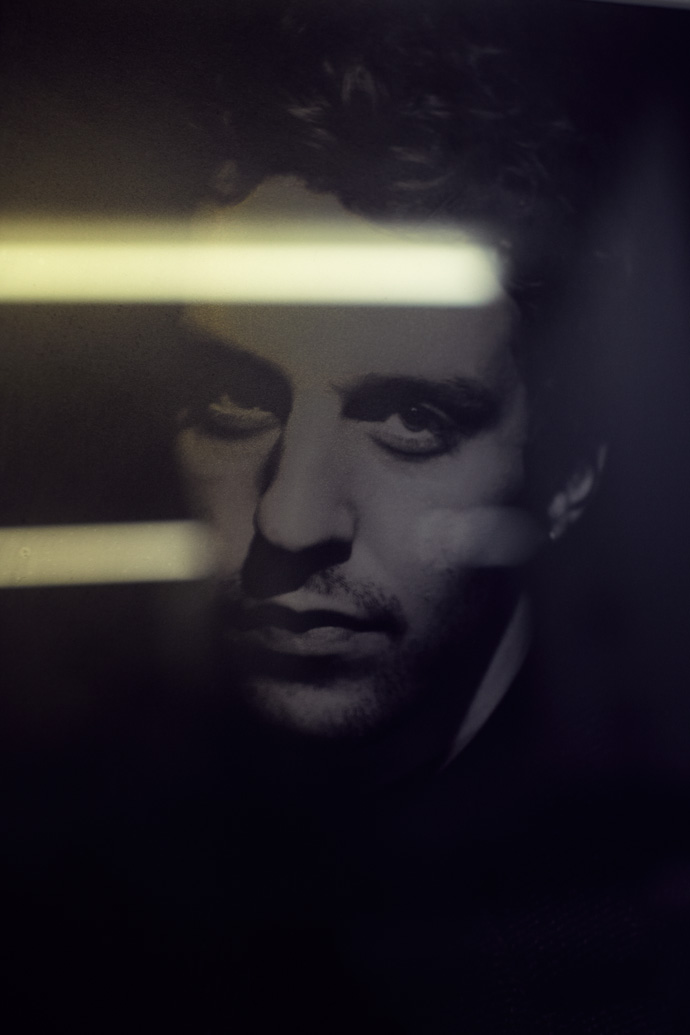
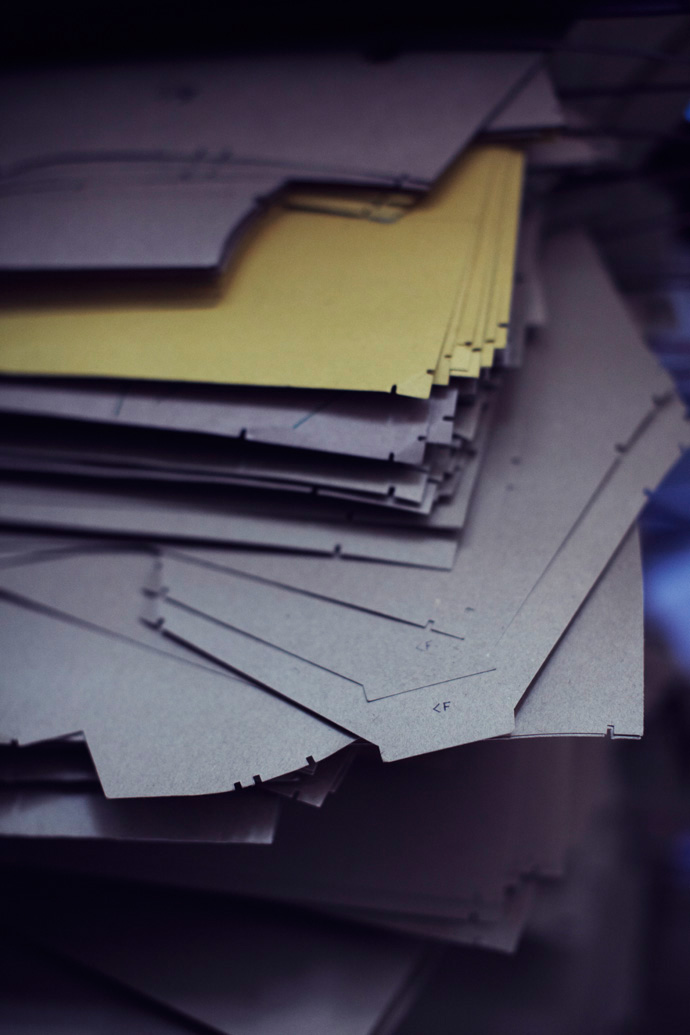 Vintage print of Marios portrait by Paolo Roversi, and Patterns at the studio. Photography by René Habermacher
Vintage print of Marios portrait by Paolo Roversi, and Patterns at the studio. Photography by René HabermacherIn the last five minutes you used the word “craftsmanship” for more than five times. How important is craftsmanship in your work?
It’s the most important thing for me. The way I learned the trade was going to Austria at the age of 15, surrounded by manic women, teachers that knew everything about traditional techniques, probably not very used these days unless of course you work for a couture house. It became my obsession and also something I am very much fond of. I like the humbleness of a craftsman and the sound of craft. I feel so comfortable sitting next to a person that is s specialized and so focused into his work. There is certain romanticism in it that I always go back to. I like sitting in a studio surrounded by the fabrics I just got from the manufacturer and then turn them upside down doing things I didn’t even suspect. I get a kick out of it, not to buy something that is finished but apply something to it.
I guess that can be said about women or the girls that inspire me. It’s a woman with personality- I don’t like women with no character. I don’t see a woman only as a body to dress. I see her as a strong persona that has a little bit more that just attitude. For me, women should be running the world at this point.
I like women who are intellectuals and private at the same time …I make a subtle story each time for them that does not overload their personality, enhances their personality.
While having a closer look at your past collections, I noticed that you continue to focus on the women’s body structure, emphasising on the waist and shoulders. Though now, your work has become more confident and much more strict than before…Do you agree, how do you see your work through the years?
Basically the starting point of a collection is always a naked body –in that I draw around the bodylines that are very much continued over the years I have been working. Whenever I dress a body I like to reveal what I also hide under a garment. From an architectural and proportional point of view it’s the most interesting part for me. What you cover you can reveal in a very sophisticated way on the surface of the fabric but also the cut.
There was certain toughness in your winter 2011-2012 collection with the use of leather and all…
The winter collection indeed had a feeling of toughness and that’s a classic element I guess in Marios Schwab that contains this femininity within something that is the good girl and the bad girl together. There is the prettiness and a sexual element within something that is sometimes quite strong and tuff. And I like to mix leather in a sense that you take the lady completely away from clothes. I don’t like ladies. I like to have a non-pretentious woman and I think that when you look closely to the garments you can see that they are not pretentious and that’s very much about the aspect of Schwab. My dresses need to be appreciated close by and I like that they don’t scream aloud but at the same time with a closer look you learn to appreciate them, their line and the detailing.
Taking elements that are very lady like and gentlemanly, for instance the broking and the pro necklaces kind of annoy me when I see them on women cause they are just too preppy.
I use them in a way that they become almost irrelevant of their status, hidden behind seams or they grow out of a seam either the are attached in a different way and become a utility, not just decoration. This is something I like doing also, using decoration at the same time in a functional way.
Remember the metal piece from an earlier collection of mine? The point wasn’t to create something shiny with a reflection in order to simply impress the guests of the show.
I thought of it as a garment that gives you this extra support when you dress up and feel you are wearing “something”. Psychologically, in some dresses this is missing, also in fashion these days. People used to take time to prepare themselves, so I tried to modernize this vintage routine within this shiny dress.
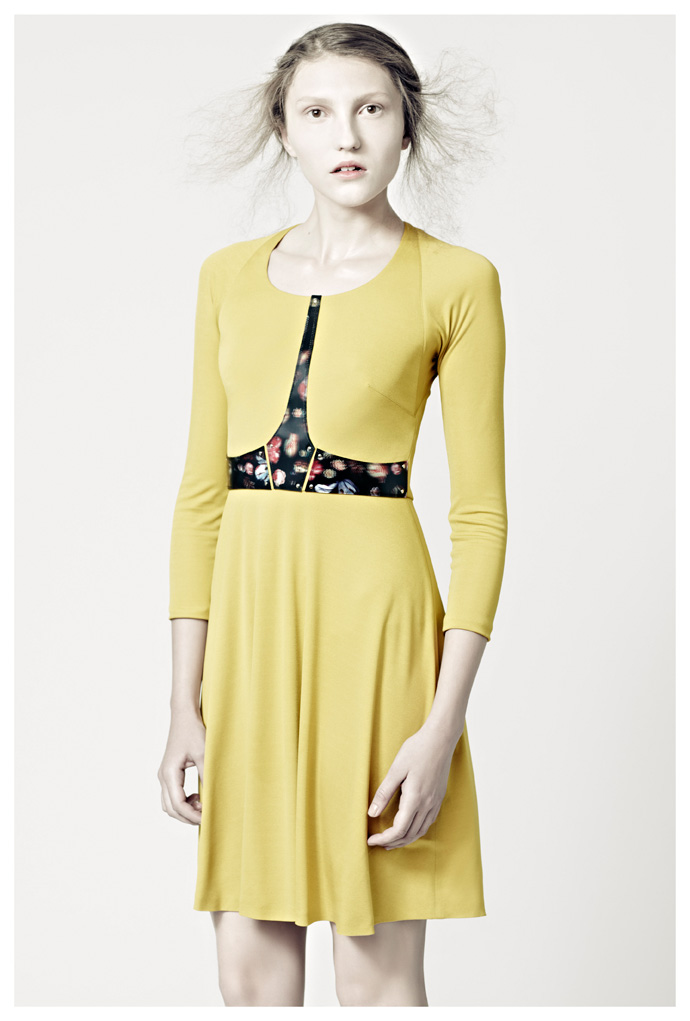
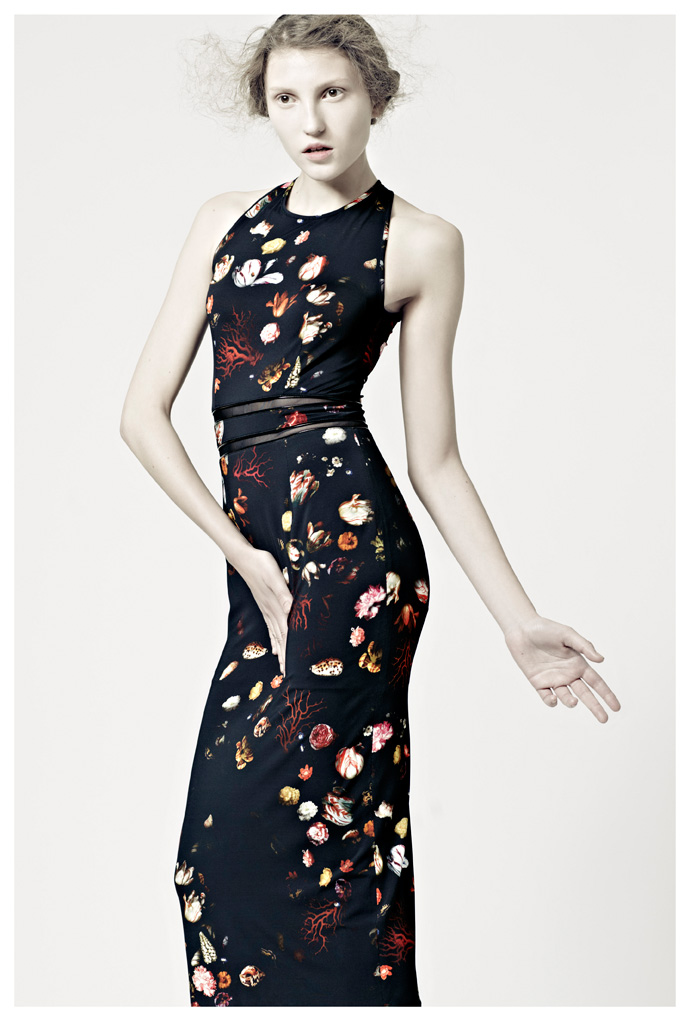 Marios Schwab resort collection 2012. Photography by René Habermacher
Marios Schwab resort collection 2012. Photography by René HabermacherHow has your involvement with Halston help your own brand you think?
I think it is such an interesting thing to work for another brand, with another team, travelling in a different country to produce a collection, which proved to be such a precious part of my Halston commitment. Basically you have a team that works abroad, that you are not very close to most of the time, you have different deadlines than your own. All these made me feel much more strong. You know also since I am the only designer there, I don’t have a team that designs alongside me which is exactly the opposite from what happens at Marios Schwab. It surprised me quite a lot. I always thought that it was going to be hardcore, working for two brands at the same time. It is hard but not as difficult I had in mind it would be.
Crazy in what sense?
Meaning the sense of “switching off”. I was surprised on how I could switch off from my collection, going to Halston do something else and then back again and back again… I felt a little bit scared before taking the job. It’s indeed a huge responsibility but you learn to do it, that’s it. Its pretty much like “you have to get on with it”!
What made Halston such a rarity as a House?
Halston as you know was concentrating on enduring fashion and I’d love to see Marios Schwab doing that,..
Halston encloses a story behind it that you can always see something else if you try looking closer. At his time Halston was creating, he offered something that was a very subtle, a minimal way of looking glamorous by wearing something simple and yet looking beautiful and seductive and expensive and clean. He had a very modern way of making clothes. The principle probably is the attractive one, what it was all about. But it was also attached to Studio 54, a very special place of that era and it was in everyone’s expectations. People just love it and for them Halston is attached to Studio 54.
Do you think your customers understand you better than your critics? Also how do you respond to bad criticism?
I don’t read reviews anymore because it just confuses me. After a show you are very tired and very emotional and personally the last thing I want to do is read criticism, good or bad. One critic can lift you up or drag you down which sometimes its not very relevant to a person that works in a very personal way and in private. I go meet people, the consumer, and the woman who wear what I create. You want to hear both at the same time, it normal but when you are still conquered by the after show adrenaline, you can’t just bother with that.
You belong in the Kane, Katrantzou, Pugh and Pilotto generation. It’s somehow like the “Antwerp’s Six” story. What in your opinion, all of you offered in fashion that was missing at the point you appeared?
I think quality, good fit within something that is very special and still acceptable and wearable. London at the time was about things that were more phantasmagorical..
So you are saying that you guys made the difference?
I’m not speaking about the rest, but yes I think that was what was missing at the time without pointing out someone specific.
Let me do that (laughs) all you have to do is agree or disagree (laughs). You all came at a point where as you said everything was very phantasmagoria and finally we had some wearable clothes coming from London, which was not the case before.
Yes, London started having a good balance. More than anything, the overall look was a little bit overwhelming. But I have to say that London is very special on that and supports all kinds of new developments, new ideas in fashion. It has to be said; you can’t really find that anywhere else’s in the world. Many people wonder, “What’s this thing about London, anyway?” But its true, London within this experimental nonsense or sometimes good sense it creates certain movements and in a way creates the platform for all of us to stand onto tomorrow..
What would be a designer’s weakness you think? What’s your weakness in that case?
Deadlines (laughs), free time. I can never organize myself to have a life. In this business you become very critical about what you do. It’s the mentality of living in your own bubble, creating for somebody else can be quite intimidating at some times, for others as well..
How difficult is for a designer to cross lots of different ages in one collection?
It’s a matter of confidence of the client. If you see a curvaceous person that wears a skin-tight garment, regardless of her age, whether she is a young girl or a woman and she has the confidence and attitude that matches the whole personality and appeal its instantly a success. This equals that the designer must have done something right.
Would you tell a client if she doesn’t look good in your dress?
Yes if she would ask me I would definitely tell her my opinion. If she didn’t, then why I would I tell her if she is happy with it? It’s her choice and one needs to respect that.
How do you see the present of Fashion?
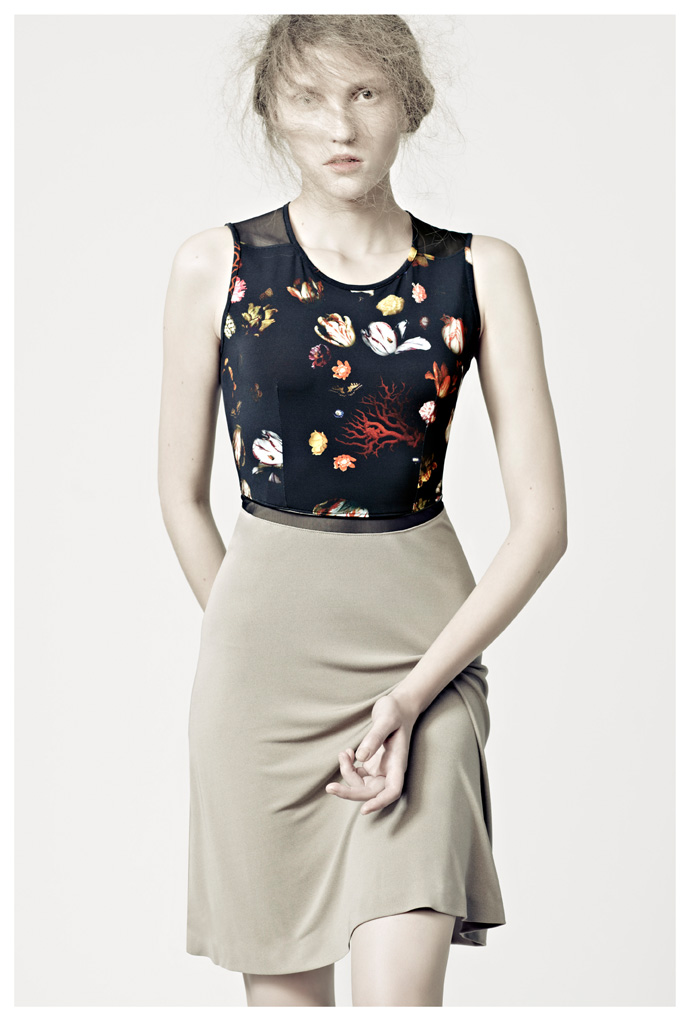
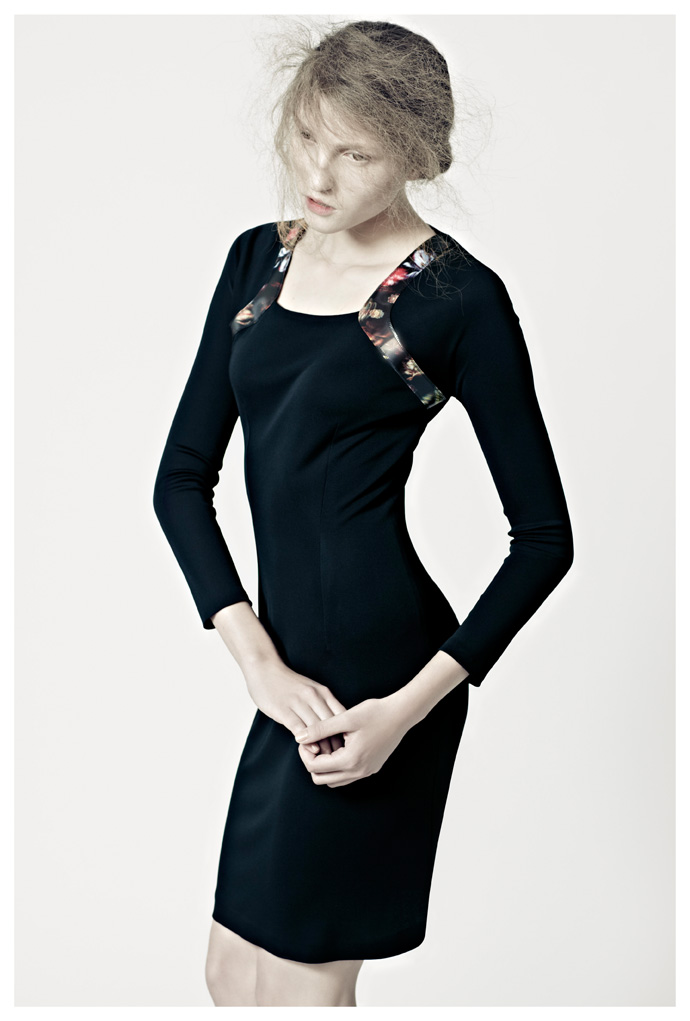 Marios Schwab resort collection 2012. Photography by René Habermacher
Marios Schwab resort collection 2012. Photography by René HabermacherShall we move to the next question? (Laughs). It’s interesting because it’s changing and its not changing at all. I think what changed is the way we get informed, how we advertise, and talk about things, how we buy things.
Everybody has a question mark about what they are doing these days…
The non-interesting part of this global change is throughout this financial downhill, the how quickly we gain information around us can make things very boring and very …
Things are supposed to be fast in fashion and although it seems that way, there is no new development in music and so many other creative sectors; and that is a shame because people stopped thinking unnaturally and they want to get into so many different characters since there are surrounded by so much information and don’t know how to handle it. They don’t have the time to study the new, see it from a distance, observe it, analyse it. It’s not a concrete period, there’s no certain opinion about things. You want to dive into so many different things because you have no other option.
It takes one bad collection to take a designer out of the spotlight you think?
I don’t know how it is but I wouldn’t see it that way I don’t know. You can have a bad collection because you decided to go on extended holydays and have a bit of a life.
Its interesting to mention that fashion can be such a fluff in the air. People think Balenciaga is amazing and next season they think Givenchy is the most interesting thing…sometimes it can become a little…I don’t know how to explain.. Do people have an opinion at the end? In previous decades or centuries this wasn’t much the case. Things were very specific. I’m talking about how people dressed, the way people reacted on fashion, art, their opinion…It was about dressing up your own way, to look pretty your own way and the way they looked upon things. Its not about buying the total look its about buying items from a collection in order to combine them with what you already have and make your look your own.

 Marios at his favorite afternoon stroll and part of his butterfly collection. Photography by René Habermacher
Marios at his favorite afternoon stroll and part of his butterfly collection. Photography by René HabermacherYou own your own company—nobody owns you. How’s that for a responsibility considering the reality of the fashion houses today?
I don’t think it’s necessarily a bad thing, no. The point is that our times as it is, its quite difficult to increase your team members, the structure, to tap into things you always dreamed of, like the way you want your company to spread out…
It’s not easy to do it by yourself without investment, or being helped by another source. It would be a shame to only be able to create clothes and not a whole product, that doesn’t only concentrate on fashion, not being able to communicate it right. Sometimes you don’t have the time or the money or both. But help must be welcomed.
I am curious to know, how many people work for you?
Hold on I need to count…Five full timers, mainly administrative and office work. I have one assistant that concentrates on fabrics and the boards.
Do you give chances to interns?
YES!! Yes!! Interns are so important, I like teamwork and when I refer to the team as always say “we”. It’s confusing for people. Who’s “we”?
I see myself as a craftsman, as I said before, I like to work within like a team that creates something that needs to be educated to us , to find our how its done and how its made and it takes a team of people that are special and committed to do that .
You can drive people crazy when you just give directions and not get involved in the making with them. For us especially, as we make all the samples in-house and it can get a little crazy. Students and the team that is here for years working with me seems like a family, we get emotional and fun and relaxed at the same time.
What I want from a student is to learn something special while running around in all the sections of the company, doing things, the boring jobs even,.. They need to have a complete idea on what it takes to be a designer because their time will come to open their own business.
Fashion is not a fantasy nor a party…
Do you ever let yourself go? Is there anything in your personality that you really have to keep a tight grip on?
The most important thing for me is family. They are part of what I do. My dad and mother enabled me to leave home at 15 to do what I wanted to do, feel free. They are critical about my work, which is very very important for me. Sometimes my mom doesn’t like certain things as she is a woman with style and she was the first who gave me the inside of quality and aesthetics.
In my private life I collect images I find beautiful. I like a variety of things, I love the impactful emotion when I sit on a beach somewhere in Greece, or sitting with old women on an island’s quiet little street, hearing them talk …Easy things and simple like that…
I like creating through emotion and experiences, history, the women I met n my life, their attitude, character. It can be very cinematographic. I build up a whole fictional character, created from my acquaintances with different women throughout my life.
What was the last thing that Stimulated you?
…my boyfriend..
-

LIFE AND DEATH OF MARINA ABRAMOVIC – LAST REHEARSAL
-Marina, Willem, Bob, Carlos and the Serbian girls.
Only a few more hours left to marinate, before the feast.The stage doors. The note is to be taken very serious. Photography by René Habermacher.
Today Marina had her shaman coming from Santa Fe, New Mexico, in order to clear any bad spirits in the theater.
Magick is in the air, the mood has eased the morning following the preview.
Some eruptions excluded.Willem Dafoe noting remarks on his text. Photography by René Habermacher.
Preparations in the Make up rooms. Photography by René Habermacher.
After all, the puzzle of endless rehearsed scenes makes sense now, its emotional power in effect to captivate both spectators and cast.
As the premiere nears, the ticket office and press department whirl faster.
During breaks, we hear big names to will attend.
They have to be seated the right way. Tickets are limited and getting sparse.Carlos Soto. Photography by René Habermacher
Marina Abramović and Antony Hegarty. Photography by René Habermacher.
The Serbian girls, that form the chorus with peasant songs, cook and cater everyone with traditional baked beans.
The longer they marinate, the better they are supposed to get. Though the longer you leave the beans to marinate, the higher the risk of having your portion snapped away – perhaps we should put name tags on the glasses in the backstage fridge?
Anyway, it’s all about MARINAting. The effect is, it melts on the tongue….
Marina riding on her wooden horse Bruno. Bruno is a darling, but not too comfortable... Photography by René Habermacher.
Svetlana sings the chorus while the soldiers shout parts of Marinas artist's manifesto. Photography by René Habermacher.
Life And Death Of Marina Abramovic
at Manchester International Festival
July 9 – 16, 2011. -

LIFE AND DEATH OF MARINA ABRAMOVIC : GUNPLAY
-Four more days to go until the premiere. The rehearsals proceed until late at night with great concentration. After four weeks of work, the cast, creative team and crew are almost ready for the first preview tonight. Bob Wilson, Marina Abramovic, Willem Dafoe and Antony Hegarty. An ensemble this beautiful doesn’t happen very often, perhaps just once in a lifetime.
The premiere is just hours away. Bob is orchestrating his cast and crew and the multi chromatic illumination of the play. Antony continues to conduct the music, snapping the tempo for the band while singing on stage. Willem recites his text in an endless mantra, a flood of whispers. His face and body moving through their various expressions. There is tension under the roof of the Lyric Theatre at the Lowry in Manchester. There have been troubles and tears and there have been shiny moments of camaraderie and playfulness, all in an effort to tell you a story. The story of Marina’s life. It is a story that will carve out a space for her in your heart forever…
Now, we go into our last rehearsal before the preview. The vultures are flying, Marina is slipping into her red, feathered dress and Bob….well, Bob is setting light cues.
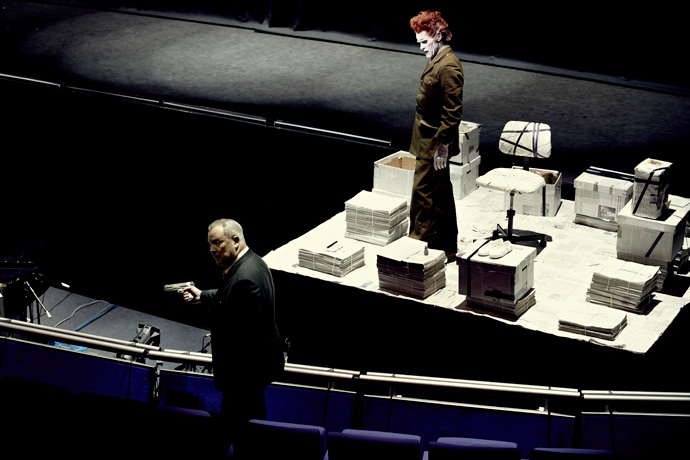 Robert Wilson instructs Wilem Dafoe in Gunplays. Photo by René Habermacher
Robert Wilson instructs Wilem Dafoe in Gunplays. Photo by René Habermacher
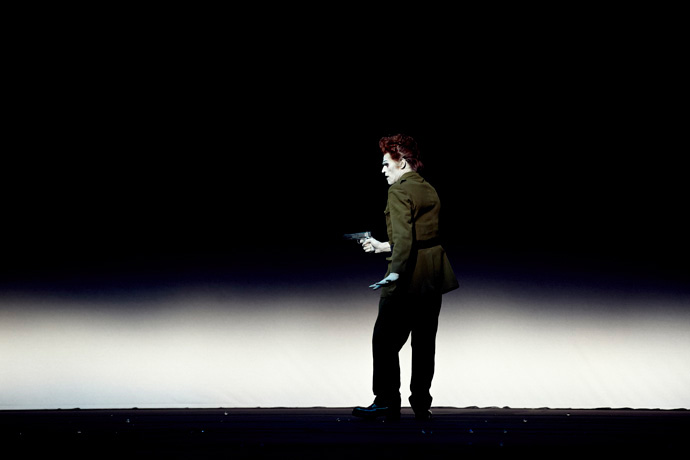 How Willem plays the gun. Photography by René Habermacher
How Willem plays the gun. Photography by René Habermacher
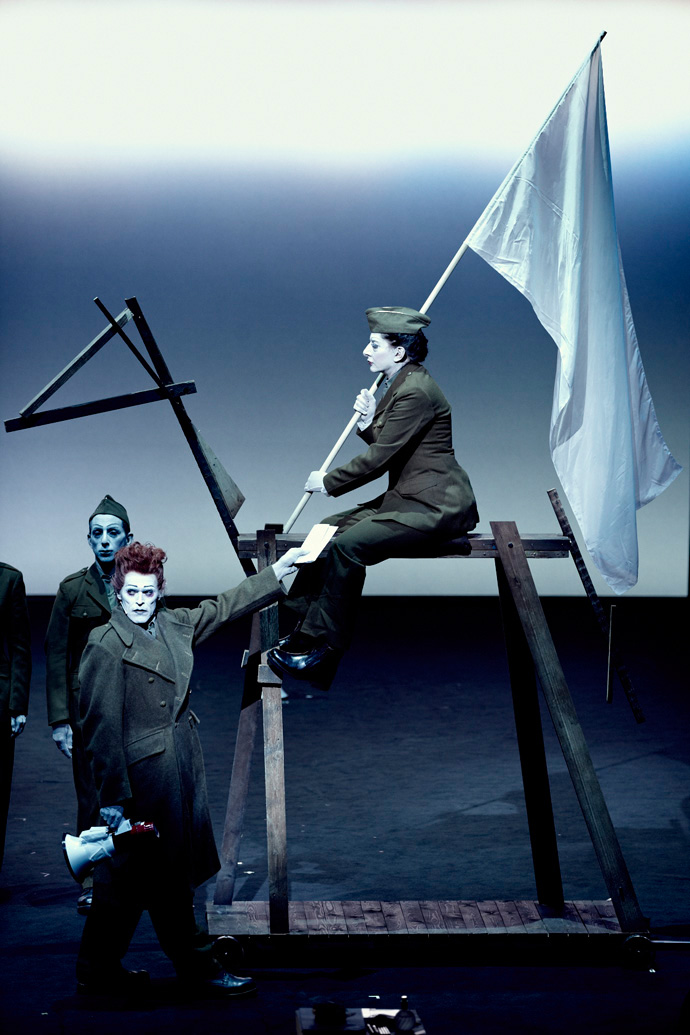 And finally on stage: "Bruno" as Marina calls him is the new Horse that replaces "Stiffy".
So here Bruno, Willem and Marina. Photography by René Habermacher
And finally on stage: "Bruno" as Marina calls him is the new Horse that replaces "Stiffy".
So here Bruno, Willem and Marina. Photography by René Habermacher -

SIREN SUZANNE von AICHINGER
-Suzanne von Aichinger is a modern archetype of the Parisian muse, in spite of the fact that she was born in Germany, and grew up in Canada.
She was discovered by the legendary illustrator Antonio Lopez, whom she considers to be one of the great influences in her life, as well as a very close friend. She inspired and collaborated closely in the design studios, with Christian Lacroix, John Galliano and Jean Paul Gaultier. Suzanne von Aichinger posed for iconic photographers Serge Lutens, Paolo Roversi, Mario Testino, Jean Loup Sieff, Ali Madhavi, David Seidner, and strutted down the catwalks of Yves St Laurent, Thierry Mugler, Claude Montana, Gianni Versace, Christian Dior (Galliano) , Hermes, Martin Margiela, John Galliano, Jean Paul Gaultier.
In Greek mythology, the Sirens with the irresistible charm of their song, lured mariners to their destruction on the rocks surrounding their island..
In modern mythology, Sirens are dressed in Rick Owens, pose for photographer René Habermacher and share their secrets and thoughts on current and past affairs with Stimuleye Filep Motwary…
SUZANNE VON AICHINGER feature, is a collaboration between Un nouVeau iDEAL and THE STIMULEYE Fashion Editor : Ines Fendri ⎜ Make Up : Akiko Sakamoto ⎜ Hair : Karin Bigler Production : Lynsey Peisinger for THE STIMULEYE Special Thanks to Mr Rick Owens and Anne van den Bosche @ Rick Owens Press Office
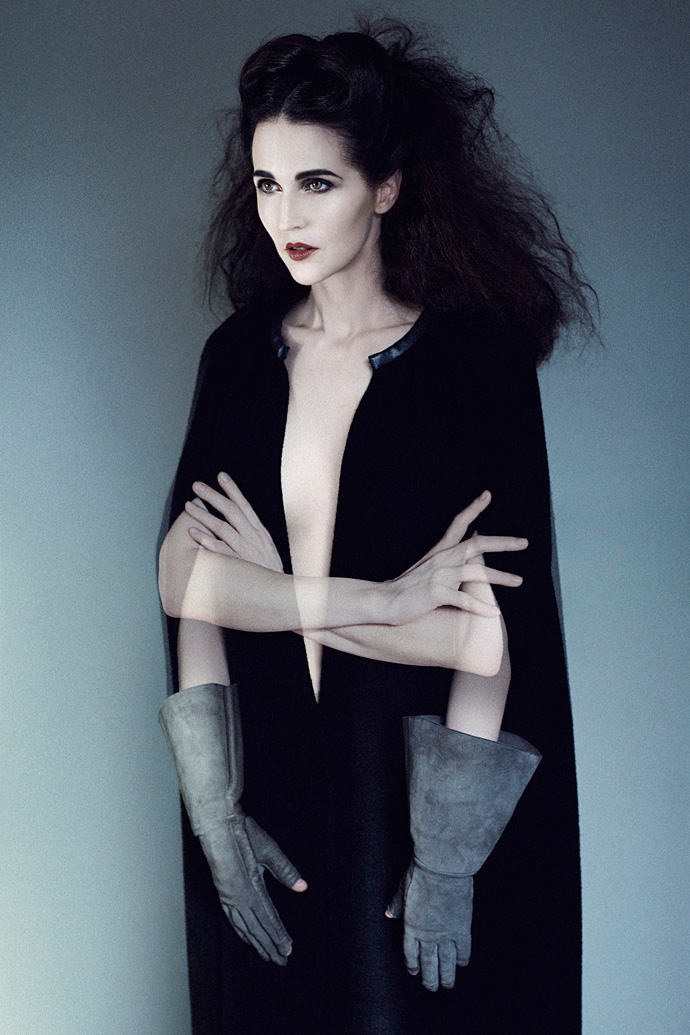 KALI, Suzanne von Aichinger wears a Rick Owens cape and gloves, all FW2011. Photography by René Habermacher
KALI, Suzanne von Aichinger wears a Rick Owens cape and gloves, all FW2011. Photography by René HabermacherI always liked her and when we finally became friends, I liked her even more. In the following conversation Suzanne shares her thoughts on fashion, music, talent, the water, mythology and other obscurities. You are about to discover the muse, the model, the artist, the stylist..
I caught her leg on her daybreak between styling for a Vogue photo shoot and organizing a major project.
FILEP MOTWARY: Hi beautiful? So it was very difficult to catch you in the past two months. What have you been up to?
SUZANNE von AICHINGER: I know Filep. I’ve been a little like Houdini…escaping. But for a good reason. I had plenty of work and styling projects
Tell me more about it please. It seems you work non-stop.
It’s been good for me lately. I’ve been styling some perfume campaigns, editorials for Russian Vogue, Italian Vanity Fair, doing photos with Dita, and now I’m preparing another perfume campaign, and a major photo shoot with one of the MOST gorgeous women on the planet.
Oh Gosh, indeed its a lot. You mean the actress, Elisa Sednaoui? Ali posted a shot of her on twitter…
Oh what a beauty Elisa is!!! But, I’m referring to another lady…very iconic. I don’t know if I should say who it is. I don’t like to talk about things before they come out…
I understand. How easy it is for you to collaborate with people. What a concept needs to have in order to get you involved in it?
Collaborating with people is my ultimate way of creating. I find the dynamic of working with another or others, stimulating, and proven a successful way of expression for me.
How do you make your choices? Is money an important motive or not always?
There has to be an element that compels me, something that excites my imagination. I also have to feel that I have something relevant to bring to the story. Money is very often not a motive. But, sometimes it is an essential part of creation. We must also live, make a living, etc. You have to know when to give and when to sell!! There is no shame in being paid for a job well done. Andy Warhol considered making money the highest art form. I’m not sure that I adhere to this philosophy, but I don’t love being broke either. I like the freedom that having some cash on hand can procure you.
On the other hand there might be talented people, who would love your contribution but, lets say, cannot afford you. How would you react in such conditions?
I usually say YES to a project, which stimulates me. It’s not about the $$$. It’s about the action. I believe in working with people that I consider talented or kindred spirits. As people of great talent have wanted to work with me, when I had no money to pay them. Just for the sheer joy of seeing an idea become a reality.
I wanted to ask you about the photo shoot you just did with René Habermacher. It’s so iconic, yet in a very special way. How was working with René?
I loved it. We had a beautiful day together, with a great creative team. We wanted to express in this series, something that is based more on personality, than fashion. I feel that there are many stories to be told in my future with René. There is a quality in his vision that is very strong and appealing.
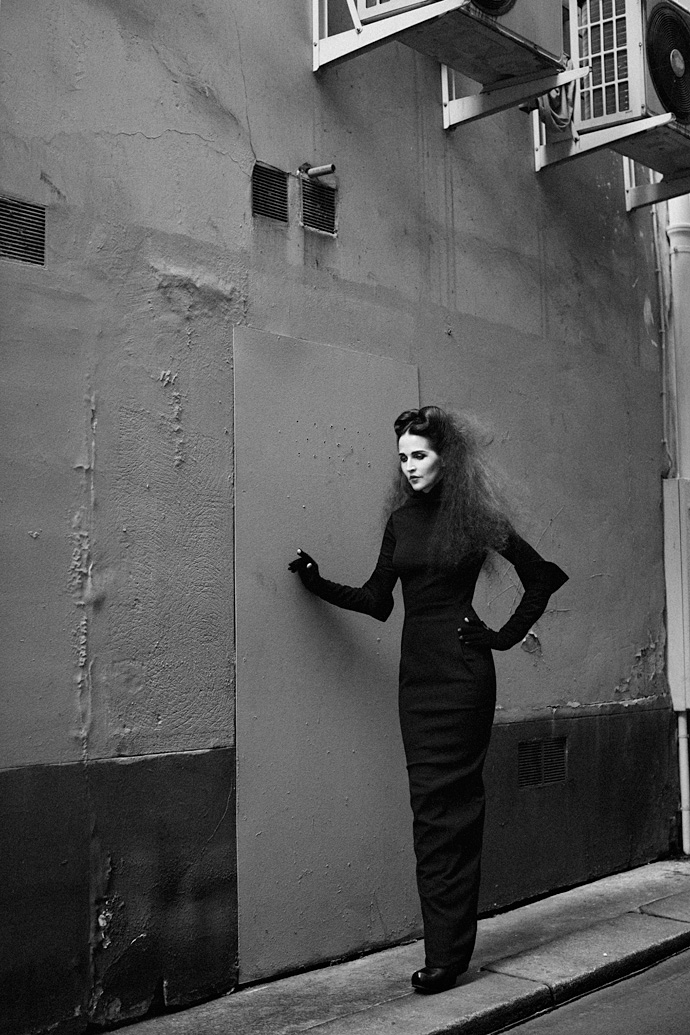 CASSANDRA, Suzanne von Aichinger wears a Rick Owens dress, boots and gloves, all FW2011.
Photography by René Habermacher
CASSANDRA, Suzanne von Aichinger wears a Rick Owens dress, boots and gloves, all FW2011.
Photography by René HabermacherExactly my point. The photographs serve our conversation so right! I’m very happy that Rick Owens was so positive when I contacted him for the garments. He is always so nice to me. Also for the fact that we shot his winter collection which is by far my favorite!
So am I! I LOVE Rick! He is one of my favorites. And, his fashion is timeless. I know that this can sound cliché, but if you have some pieces by Rick from 12 years ago, they are as relevant as pieces that he has made 2 days ago. They don’t go in and out of fashion. They have their own essence and place.
Having in mind that Rick’s clothes are so special, yet the 2000’s are the epitome of diversity. Each designer points out a different outline every season, there is so much choice. How do you see fashion now yourself, as a stylist?
It’s hard for me to answer this. I see many great things happening, no doubt. But, I see a lot of nonsense going on as well. There is not enough power any more in the hands of the creators. Now, big design houses change designers like they change their underwear. Just ridiculous. There is no time for the designer in place to create a brand identity, that he is fired. And very often, they find out that they’ve been fired, by reading about it in the papers.
It’s as if the financial/commercial people at the heads of some houses, envied the position of creator, and wished to usurp it. They believe that they are capable of being the creator. WRONG!!!!
(more…) -

TEASER – LA MAIN DANS LE SAC
-Bags ! Lanvin ! Prada ! Crime ! Dries Van Noten ! More Bags !
It’s LA MAIN DANS LE SAC / CAUGHT RED HANDED !
TEASER - LA MAIN DANS LE SAC by Antoine Asseraf & Rene Habermacher, A Short Film With Jamin Puech for Vogue Italia.
Coming July 1st on the THE STIMULEYE, playing exclusively on Vogue Italia, our short film commissioned by Vogue Italia for bag designers Jamin Puech, “LA MAIN DANS LE SAC / CAUGHT RED HANDED”.
La Main Dans Le Sac – Website
La Main Dans Le Sac – YouTube Teaser -

NEXT: SUZANNE von AICHINGER
-In Greek mythology, the Sirens with the irresistible charm of their song, lured mariners to their destruction on the rocks surrounding their island..
In modern mythology, Sirens are dressed in Rick Owens, pose for photographer Rene Habermacher and share their secrets and thoughts on current and past affairs with Stimuleye Filep Motwary…
Stay tuned..
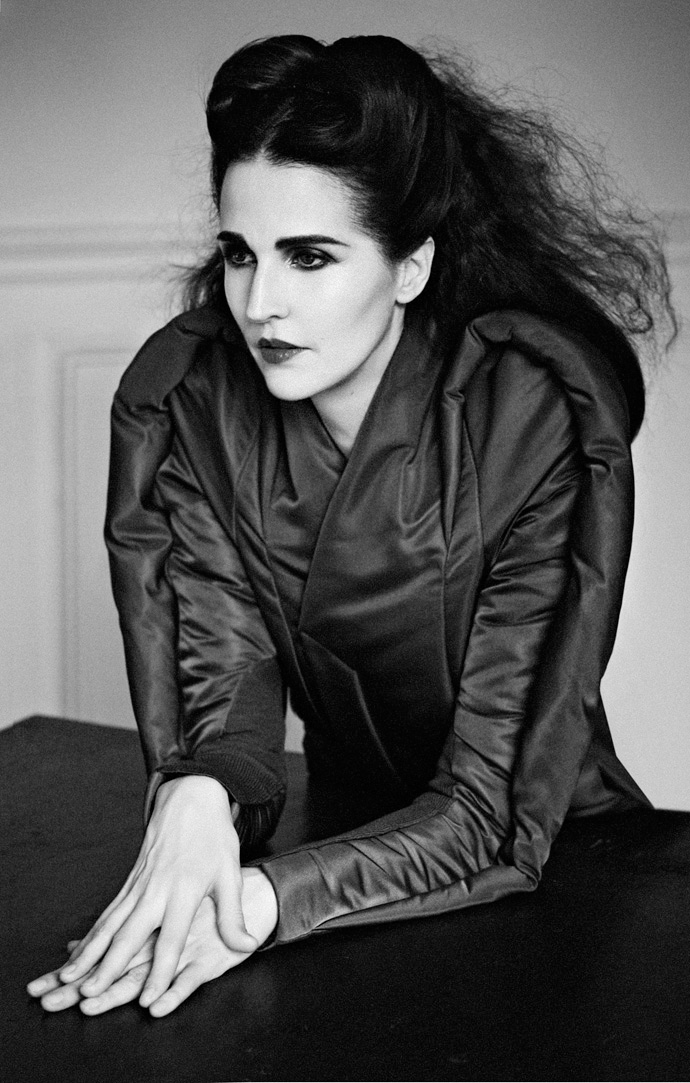 Siren Suzanne von Aichinger wears Rick Owens FW2011. Photography by René Habermacher.
Fashion Editor : Ines Fendri ⎜ Make Up : Akiko Sakamoto ⎜ Hair : Karin Bigler ⎜ Production : Lynsey Peisinger
Siren Suzanne von Aichinger wears Rick Owens FW2011. Photography by René Habermacher.
Fashion Editor : Ines Fendri ⎜ Make Up : Akiko Sakamoto ⎜ Hair : Karin Bigler ⎜ Production : Lynsey PeisingerWhat was the last thing that stimulated you?
Suzanne von Aichinger:
“Shooting Haider Ackermann’s portrait for Vogue.” -

MAREUNROL’S
-Mārīte Mastiņa and Rolands Pēterkops, the minds behind fashion brand MAREUNROL’S pulled their strings for the installation TENANTS which just closed at the Villa Noailles in Hyères, France. The Latvian duo from Riga had already won the two biggest prizes at the Hyères fashion festival in 2009, made a stunning return fashion show in 2010, but his year’s exhibition proves not only their virtuosity in fabricating elegant and wearable pieces of clothing, but also their ability to create a much broader, often dark and poetic universe.
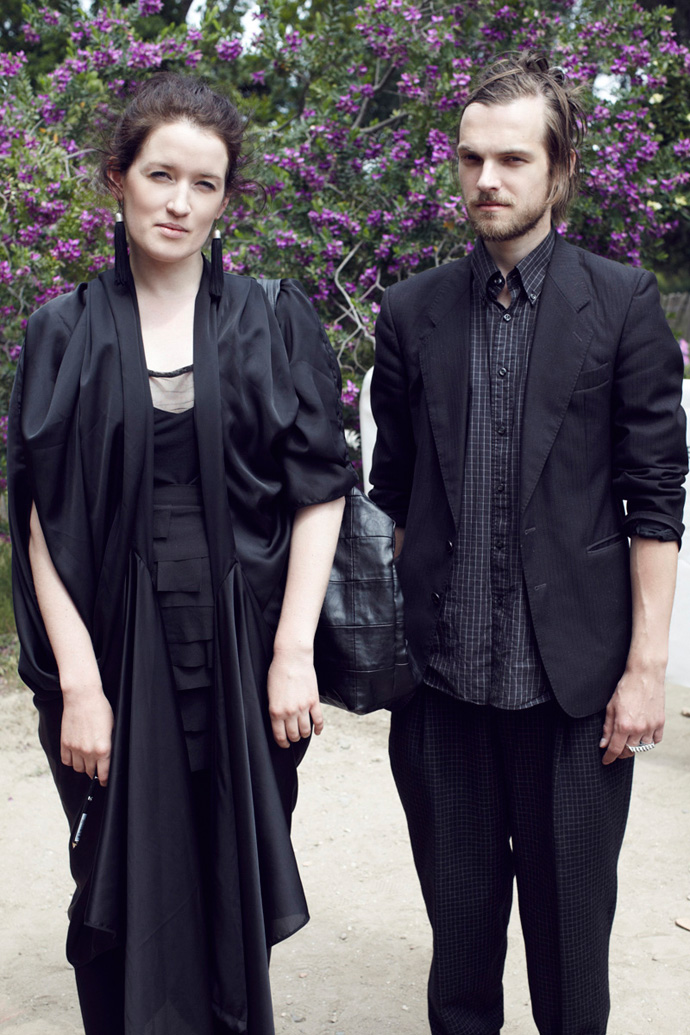 Mareunrol: Mārīte Mastiņa and Rolands Pēterkops at the garden of the villa Noailles.
Mareunrol: Mārīte Mastiņa and Rolands Pēterkops at the garden of the villa Noailles.RENÉ HABERMACHER: what was the point of departure for this installation and the inspiration behind it?
ROLANDS PETERKOPS & MARITE MASTINA: When we start to work on a new collection, we always make the designs first to fit on miniature mannequins. And each time we both have discussed the idea of beautiful dolls as models so we could our ideas of garments to shoot as small style photos and to show them as the newest collection. That is why this idea came naturally.The advantage of the small scale is that we have the freedom of implement anything, all our ideas without leaving out any of those costing an absolute fortune to make. Visual inspiration came in recent years moving from one apartment to another. That’s why our project is called TENANTS. As any of our works, this work also reflects our experience.
The inspiration for the installation came from artists’ constant moving from one apartment to another, from one neighbors to others, from one room to next and due to moving to new environment always makes you get used to new mystical noises, strange objects, loud or too quiet neighbors and other peculiarities connected with the apartment. But of course, with time you get used to all that. However, that all provoked thinking of how space influences those living in it and vice versa, and whether all these things in one way or another influence people and whether one imperceptibly starts to change, and whether this oddity is just in one’s mind, not reality. This is how emerged the idea for the installation with people/ tenants who dwell in their apartments and become as one with it. All their belongings are like a huge enormous shell/ attire which tell all their peculiarities, interests, specific hobbies and many other things.
These stories are made as small installations which show short sketches from character’s daily life. They communicate through costumes, scenography, sound and light. It is important that not only costumes and puppets are made for the installation, but also environment/ scenography, where they can express themselves and show the intended story, by forming a figurative composition which is combined with a surreal fantasy, mystique and a pinch of wit.
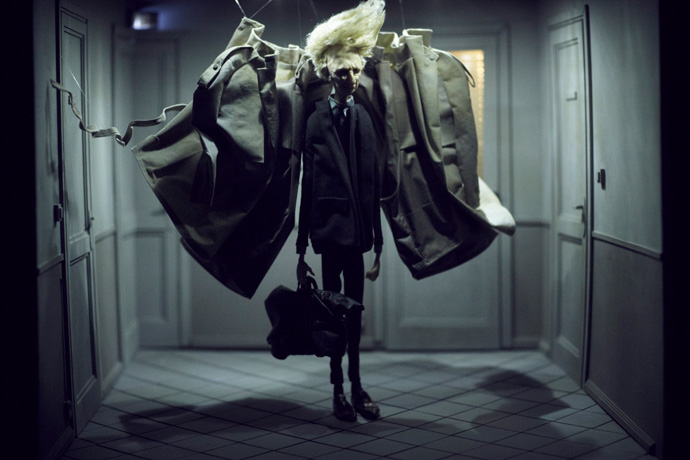 Mārīte Mastiņa and Rolands Pēterkops: Tableau from the exhibition TENANTS.
The dolls character is inspired and modeled after Keith Richards.
Mārīte Mastiņa and Rolands Pēterkops: Tableau from the exhibition TENANTS.
The dolls character is inspired and modeled after Keith Richards.Can you explain me the process of planning and making the installations?
First we had a few visions of the project, then we started working on sketches slowly crystallyzing the characters. At the same time we started looking for people who could make the puppets we had envisaged. It was really important for us to find a puppet master who could make the dolls with movable head and arms. It is really important for our Prague project.
(more…) -

COMING JUNE 1ST
-One of the reasons we’ve been away recently… La Main Dans Le Sac, a film commissioned by Vogue Italia.
The Stimuleye presents
A Short Film With Jamin Puech
for Vogue Italia
“Caught red-handed”
Directed by Antoine Asseraf & René Habermacher
Styling by Michaela Dosamantes
Assisted by Alexia Hollinger
Starring Quinta Witzel @ IMG Paris
Make-Up by Tracy Alfajora
Hair by Romina Manenti @ Artlist
Assisted by Masako Hayashi
Filmed at Prunier, Paris
Music by Shane Aspegren & Lori Schonberg of The Berg Sans Nipple
Thank You: Lisa Kajita, Nicolas Barruyer, Erotokritos Antoniadis, Yoann Lemoine.
-

ERWIN BLUMENFELD: through the eyes of his son Henry.
-On the second day of the fashion and photography festival in Hyeres, I watched Henry Blumenfeld, elementary particle physicist and son of Erwin Blumenfeld, inconspicuously walking through the exhibit of his father’s work at the Villa Noailles. He was wearing a tan suit, sneakers and a baseball cap that was slightly crooked on his head. Before long, the spacious, bright room where the artist’s photographs and videos were being exhibited became empty and quiet. Only the slight hum of voices around the villa could be heard through the walls. Here, surrounded by a collection of stunning and rare examples of his father’s work — large-scale, restored prints — Henry sat down with us for an intimate conversation: Erwin Blumenfeld the artist, the father, the mentor and the man of perseverance.
by Lynsey Peisinger, Photography René Habermacher
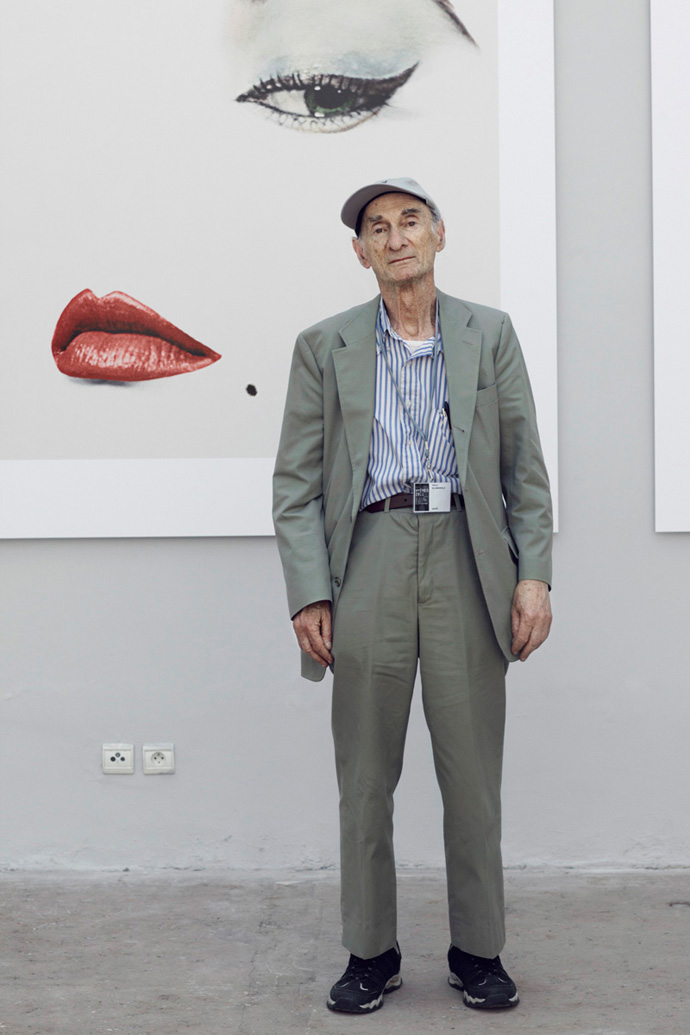 Son Henry Blumenfeld in front of his fathers DOE EYE with Jean Patchett for Vogue US 1950
Son Henry Blumenfeld in front of his fathers DOE EYE with Jean Patchett for Vogue US 1950LYNSEY PEISINGER: Where were you born?
HENRY BLUMENFELD: I was born in 1925 in Zandfoort near Amsterdam. My father had been an ambulance driver during the first World War. During the war, he had met my mother who was Dutch, Lena Citroen, who was a cousin of Pal Citroen, a German/Dutch artist. He grew up in Berlin with my father and they went to school together and they were very close friends. Through Pal, he met my mother and they corresponded during the war. My mother came to visit him in Germany when he was a soldier there. He tried to leave Germany, but he couldn’t. So, just after the war he came to Holland and then, a little bit later, married my mother in the early 20s. I guess, 1921. And because he was German and she was Dutch, she became German — that was the Dutch law at the time. I was born in Holland, but because I had a German father, I also became German.
LP: What was your father doing at that time?
HB: He was surviving. Leaving Germany at the end of the war, he tried to survive with the help of my mother and set up some kind of art dealing business with a friend, but that didn’t work very well. He was doing a lot of collage and kept in touch with other German Dadaists. After two years, he started to work as a clerk in a department store. Later, around the time I was born, he opened his own shop called the Fox Leather Company, selling ladies handbags and suitcases on the Kalvestraat. That went fairly well, but soon Hitler came to power and the business went badly and eventually bankrupt. That’s when he decided to become a photographer in 1934.
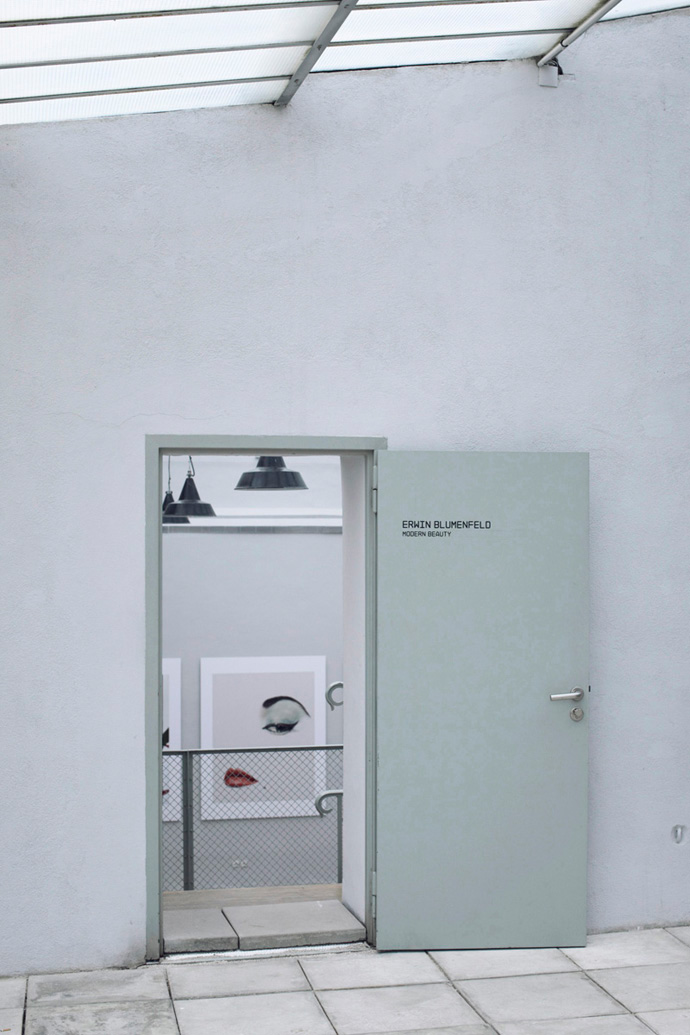
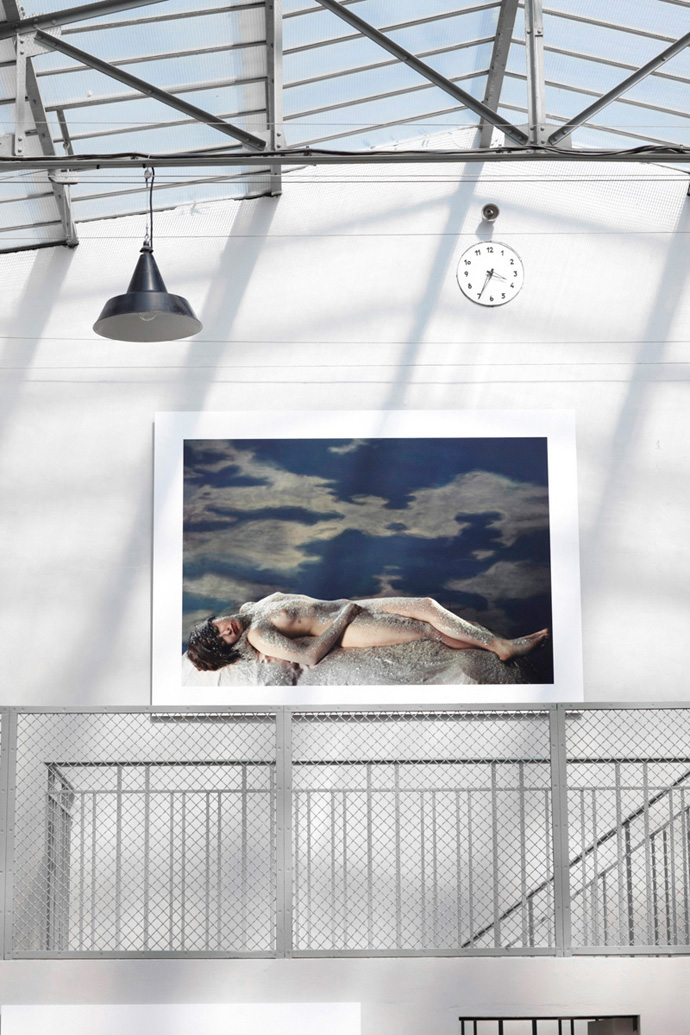 ERWIN BLUMENFELD Exhibition at the villa Noailles Squash Court. Right: Erwin Blumenfeld OPHELIA 1947
ERWIN BLUMENFELD Exhibition at the villa Noailles Squash Court. Right: Erwin Blumenfeld OPHELIA 1947RENE HABERMACHER: So your father’s first art oriented interest was collage and he was in the Dadaist movement?
HB: He was already interested in photography. He got his first camera when he was about 6 or 7. But his main interest was perhaps the theatre. That was something he was strongly attached to: the German language. His Dutch always remained a little bit feeble to say the least. He worked quite a lot, but with theatre in German language, he couldn’t make much of a living… With his collages he couldn’t make a living with that either but always kept in touch with the Germans — Grosz and Richard Huelsenbeck and other people of the Dadaist movement. Recently there was an exhibition in Berlin on this periods work of my father and a book has been published.
LP: Did he continue to do collage later on when he started doing photography?
HB: No. When he was doing collage, he was also painting — he was a Sunday painter: He did quite a bit of painting on Saturdays and Sundays. But he dropped doing his collage and the painting and started doing photography in Amsterdam. The business went rather poorly, he had health problems and more or less escaped to Paris around the 1st of January 1936. The first year it was very difficult for him to make a living. He got support from the family of his wife, of my mother. On his side he didn’t have much family left. His father had died before the first world war and his mother deceased shortly afterwards. He lost his brother in the war as a soldier in the German army and his sister died of Tuberculosis shortly after.
My father was friends with Walter Feilchenfeldt’s wife Marianne. He was a quite well known art dealer in Zurich. Mariane Feilchenfeldt helped him to rent his studio in Paris at 9 rue Delambre.
RH: So in Paris he got introduced to photography on a professional level?
HB: Already in Holland he was doing it on a professional level. He took many portraits and pictures there, but they didn’t sell much. He got in touch with some French people who came to Holland and they eventually supported him when he went to Paris — like Andre Girard the painter. Then, after about a year later, he started to sell photos to small photo magazines in the US and England, such as Lilliput. In 1937, he met british photographer Cecil Beaton who introduced him to Vogue. My father started to work for Paris Vogue in 1938.
When he was in Paris, he worked only in black and white. Color was not yet really developed for photography. It was very difficult for individuals to use color in their own studios, so he only did black and white while he was in Paris. I should mention that for his Paris period, his publications in Verve were very important. He had some of his striking black and white photos published in the first issues of that magazine. In the dark room, he experimented a lot, but only in black and white.
Then came the war and during the war, we were foreigners in france — we were not really refugees, but were without status, so it was quite difficult. In the beginning of the war, we were more or less exiled, we lived in a hotel in Vessely nine months, a sort of medieval town in Burgundy, France with a really nice cathedral. Then the Germans came and my father and sister were put in a camp. My mother and my brother and I, with the help of some Citroen cousins, managed to escape to the south of France. Our father was then in a rather horrible camp in France. We stayed in the Country until 1941, trying to get out. Then we managed to get a visa for the US — my father had been to the US already, in June of 1939. That was were, I think he took his first color photographs. He came back to France in July 1939 and he was stuck in France for two years. Then when we got to go to the US, he started working first with Harper’s Bazaar for two or three years, switched to Vogue and started doing color photography. At the time, he took his color pictures in the studio, using different color lights and so on — he was very experimental. But for the development and the printing, it was completely out of his hands. It was always done by Kodak. At the time, he couldn’t do anything in color on his own in the laboratory.
Most of these photos here were printed by Kodak. When I say printed, they weren’t really printed, they were large color transparencies. Like big negatives — 12 by 15 inches. I think that all of these photos here were taken in this large format and they were transparencies. The pictures were only printed for Vogue — working from the transparencies. Sometimes my father would give some direction on how they should be printed, but he was not generally involved in the printing itself. Only later, around 1956, they started to develop a new process called C-Prints. He bought the C-Print machine and he could start doing his own color. But C-Prints were very unstable as far as the color went — if they were exposed to light, in a few days they would essentially vanish. So all of his work in C-Print is essentially gone. Even the color transparencies that we have of his work have either faded or changed color a lot. Especially the reds, had faded. So, our doughtier Nadia has worked a lot with Olivier Berg at a laboratory in Lozère to try to restore the original colors. She is using the original publications because those prints have kept their color much better than the transparencies. So what you see in this exhibit is the result of the work that Olivier Berg and Nadia have done.
RH: Would you say that your father was somebody who was very progressive and pushing for new things in general?
HB: I don’t know about new things…. He was for the experimental, which is a little bit different. I don’t know if he was really striving for new things, but he tried to do do things differently and experimented. He was very much inspired by especially old painters like Goya and Renoir and much impressed by Picasso. I don’t know if he ever got to meet Picasso in Paris at the time. But he met quite a few artists as Dali and others.
 Erwin Blumenfeld advertising for PALL MALL circa 1957.
Erwin Blumenfeld advertising for PALL MALL circa 1957.RH: But he liked the experimental, so maybe that was something that remained with him from the Dadaist movement?
HB: Yes, that was important to him.
LP: I heard Michel Mallard talking earlier about how remarkable it is that there was no photoshop or digital editing at that time… this image, this one with the lips and the eye, DOE EYE, where the nose is missing and there is color separation, was this done in the retouching process?
HB: This was done in the process of retouching. It was an original black and white picture. It was colored afterwards by my father and by Vogue. They worked on it together. That was a special case because the others that you see were done in color and then reworked. This one did not originally have these colors.
RH: When your father was working, did you often witness his process and how he worked in his studio?
HB: No. When he was in Paris, working in black and white, I was somewhat present. But afterwards, in the States, I was not really present anymore. So I didn’t really witness him working in color.
RH: Was his approach as a photographer more controlled or more spontaneous?
HB: I think both. He was quite controlled — all of these pictures here were taken in a studio. But he also traveled quite a bit in America and in Europe and he took many 35 millimeter color slides. Incidentally, the color of those slides kept much better than the color on the transparencies. But, in the studio, he was very controlled and would take many pictures to get something specific in a sitting.
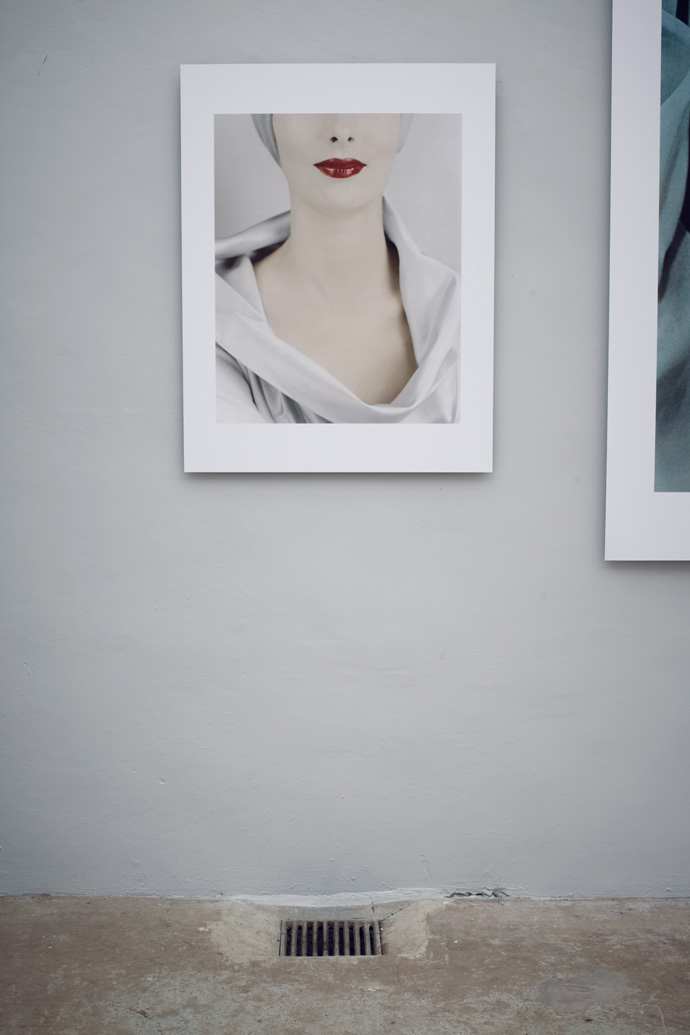
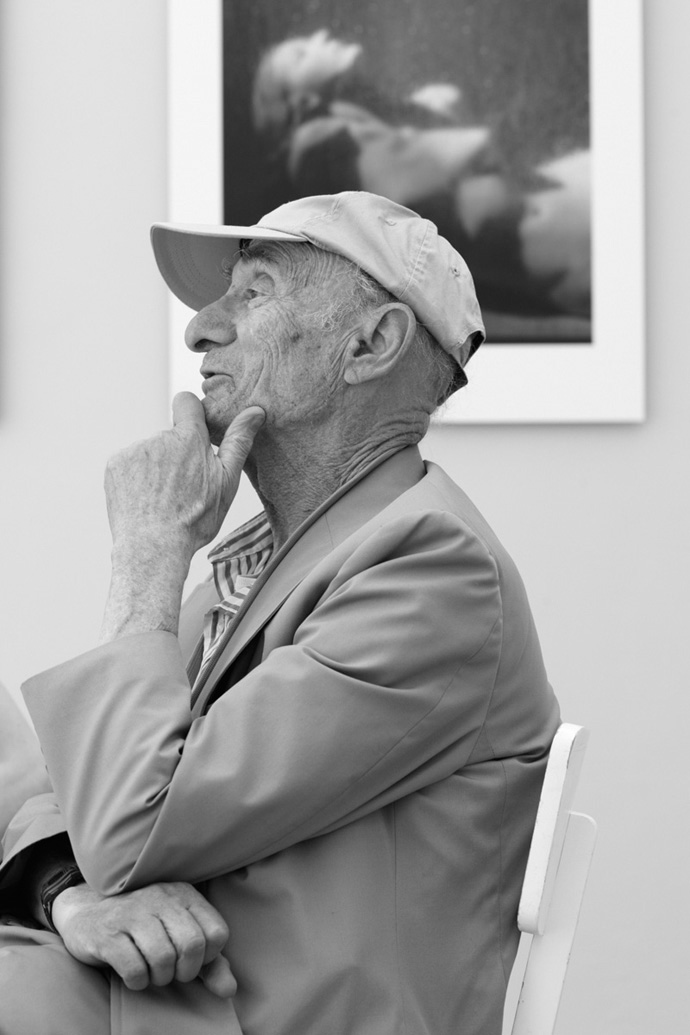 Left: Erwin Blumenfeld LE DECOLLETE 1952, RIGHT: Henry Blumenfeld in Conversation
Left: Erwin Blumenfeld LE DECOLLETE 1952, RIGHT: Henry Blumenfeld in ConversationLP: In Paris, were you present when he would shoot people in the studio?
HB: Sometimes, but not very often. I was more present when he was working in the dark room.
RH: I recently saw notes from Richard Avedon where he had a black and white print and he marked on it all of the places where he wanted the development to be darker or lighter using manipulation techniques in the dark room. Was your father working with these techniques too?
HB: Yes in the dark room, for black and white, he manipulated a lot. It would have been interesting to see what he would have done with color photography if he had been born fifty years later. At the time, the technology wasn’t there for him to do anything after a picture was taken in color.
RH: Where would your father have his intellectual and creative relationships — in other photography or painting etc?
HB: I would think painting. Very much painting, classical painting. Many of his photos were inspired by different painters. He was also inspired by modern life and by life in NY at the time, in the 40s and 50s. He liked jazz music very much, in the New Orleans style.
And he was quite interested in looking at television when it first came out. We got our first television set around 1950 or so. It was black and white at the time. I don’t think he ever saw color television. Maybe he saw it, but he never had one. He liked movies — but more for the content than for the photography. He liked Nanook of the North, about a Danish explorer. He was interested in movies — liked Erich Von Stroheim and he liked Sunset Boulevard and Billy WIlder.
RH: Was that love for cinema also what led to him making films?
HB: The filming was more in line with advertising. I think he was trying to see if he could use the filming for advertising, rather than to tell a story like in movies. Now you see everything mixed, advertising and movies. But at the time, it was an experiment.
RH: Do you think that your father really divided the things that he did for himself and the things that he was commissioned to do? The time after the war was quite commercial driven in America — was it easy for him to also do what he wanted to do?
HB: For one thing, the black and white and the color were two different things. In black and white, he could do what he wanted. In color, probably none of them were published in the exact way that they had been taken. They were made and developed specifically for Vogue. He did appreciate the possibility to work in color, but the whole fashion business and the way it worked was not very attractive for him. But still, when he had started out in Germany, he had started out working for a textile company and so, even then, he was interested in materials and fashion. Still, he didn’t really appreciate the fashion magazine business, but he knew that he could make his living there. So there were two sides to it for him — on one side, it was a place for him to make a living, on the other side, it gave him the opportunity to work in color, which he might not have had otherwise. He did have certain resentments, which is true for everyone in any job.
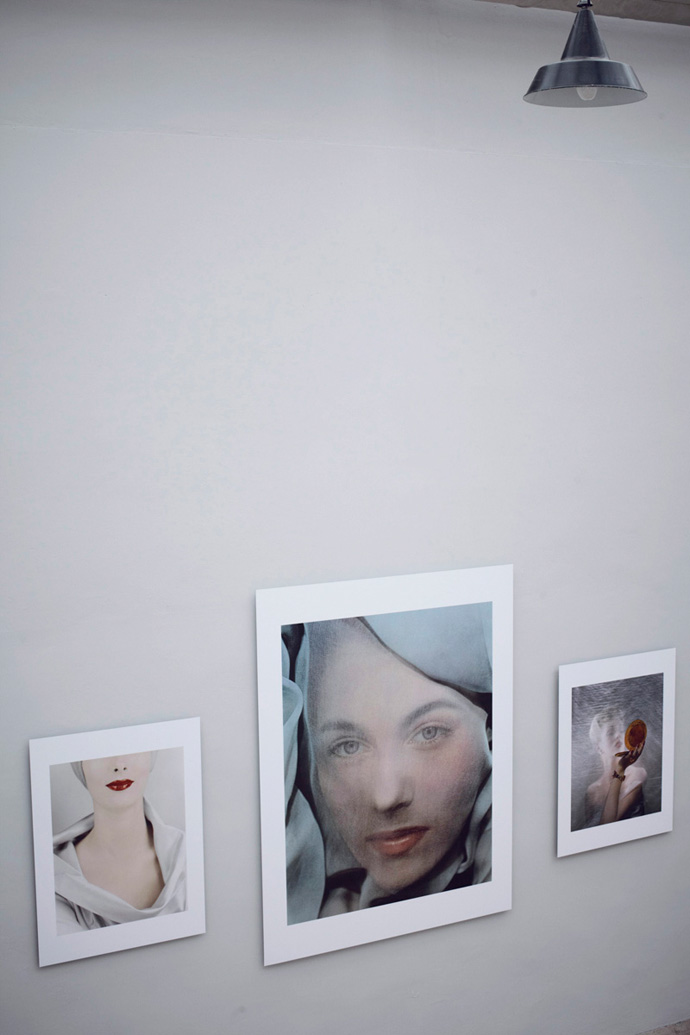 Erwin Blumenfeld DECOLLETEE and BLUE both 1952, and POWDER BOX 1944
Erwin Blumenfeld DECOLLETEE and BLUE both 1952, and POWDER BOX 1944RH: There are artists who suffer between the economical need to do something commercial and the desire to make the work that they are passionate about. They can feel torn…
HB: I don’t think that was his case. First of all, he did well financially in the 40s and 50s and he appreciated that. And then, because of that he was able to continue his work in black and white. You might have seen his book “My One Hundred Best Photos”. We have people comment on the fact that there is almost no fashion in that book–he did a little fashion photography in black and white for Vogue before the war, but later he didn’t do any fashion work in black and white. But, it gave him a lot of satisfaction to be able to do that book of his black and white work.
Still…he wasn’t always satisfied with everything. Becoming old for him was very difficult. It made him suffer a lot…some people accept it, but he accepted it quite badly.
LP: You said that he was experimental as a photographer. As a person and as a father, did he also have that type of attitude? And did he transmit that type of approach to his children?
HB: Well….I think he had his ups and downs. He was a very active father in many ways. He was involved with his children and either pleased or displeased with what they were doing. I don’t know….the children turned out very differently. I became an elementary particle physicist. My brother became a writer. He is not exactly politically minded… he is interested in art, sociology in many ways and in the way people behave. He was very rich in ideas my father, perhaps more so than his children.
LP: Did any of his children take an interest in photography?
HB: Interest yes, but not active in photography. Though, my wife became a photographer. She was born in Paris to an Algerian/Russian father and a British aristocratic mother. She survived the war in France — her father was Jewish, her mother was British, but anyway they would have liked to capture her. After the war she came to New York and worked for one year for the New York Times, one of the first women to work in a non-secretary position at the New York Times. Then she went back to France and when she came back to the States, the New York Times fired her because her vacation to France was more vacation than they were willing to give. Then she met the wife of Alex Liberman, the editor of Vogue, and became model editor at Vogue. Her job was to provide models for the photographers. Then she met my father and after a fews years, she started working for him. She started representing him. She never got any lessons from him in photography but she worked with him as an assistant– sending his photographs to different commercial companies. Then after we got married, she became a photographer herself and worked quite actively as a photographer. First a bit in Princeton where we lived. Then in Geneva for a few years. Then we came to Paris and she started working for Vogue and other magazines. She did mostly portraits of personalities and important political people and scientists etc. And other side projects, like children photography too. To a large extent inspired by my father. Of course, after we got married and had children, my father got another assistant, Marina Schinz. She became a photographer too — mostly garden photography and published a book on that.
LP: It is interesting that she worked with your father, who was doing a lot of fashion photography and then she became a garden photographer…
HB: She admired his work very much and when he died, she bought his studio on Central Park South. And she didn’t have a single photograph of his on the wall.
Both she and Kathleen, my wife, probably wouldn’t have become photographers without him. They were inspired by him, but they probably felt that they couldn’t really rival him, so they chose different styles.
LP: Do you think that he was a good teacher?
HB: He wasn’t really a teacher. But he was a big influence. My wife saw how he worked, but he never tried to give her lessons. Same with Marina Schinz.
When my father died, he let Marina handle his photographic inheritance. From the point of view of his will, it was never very clear…He left the photos with her and she tried to handle it the best possible way. So she divided all of the black and white photographs into four lots–one for each of his children and one for herself. Then she gave essentially all of the color transparencies to Nadia. Now Nadia has been quite active in promoting her grandfather’s work. She is now working on an exhibit for next year in Chalands sur Seine. There is a photography museum there and next year they will do an exhibit of my father’s work.
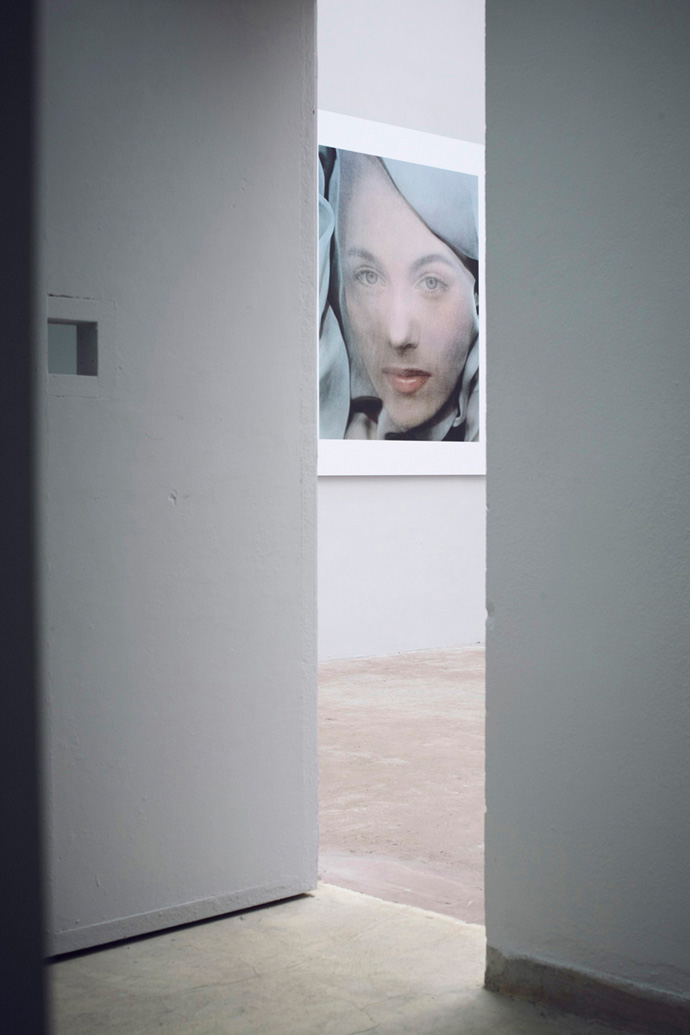
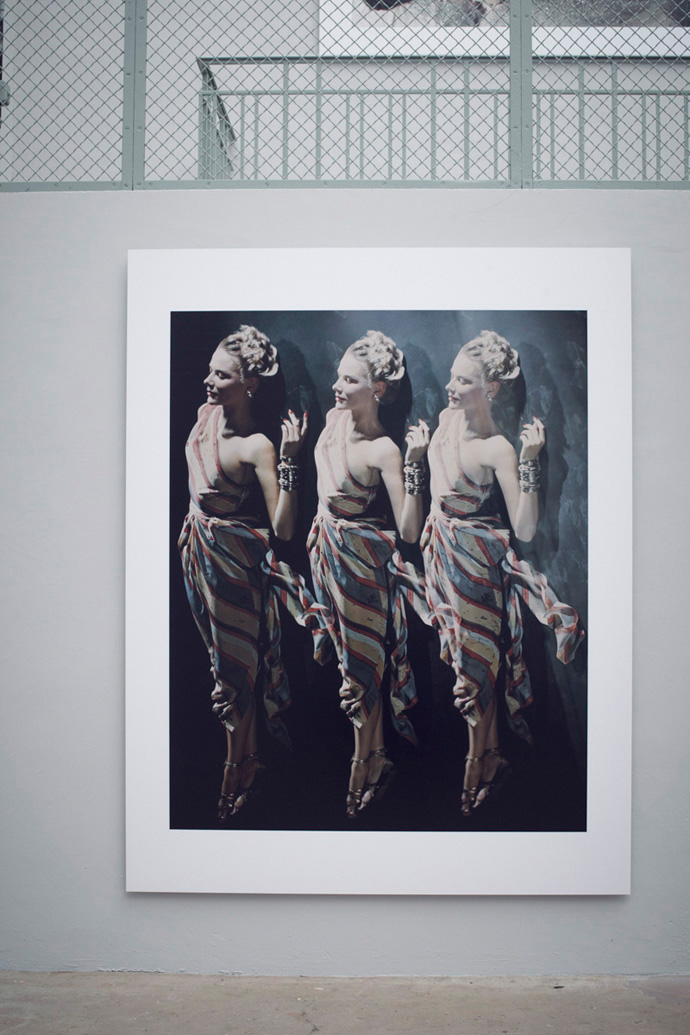 Left: Erwin Blumenfeld BLUE with model Leslie Redgate 1952. Right: Erwin Blumenfeld VARIATIONS, unpublished 1947
Left: Erwin Blumenfeld BLUE with model Leslie Redgate 1952. Right: Erwin Blumenfeld VARIATIONS, unpublished 1947LP: What is the last thing that stimulated you?
HB: What do you mean by stimulated? Something that affected me? Well, the thing that affected me is that my wife, Kathleen, died three months ago. Clearly that affected me. She had been sick, her brain didn’t work anymore. She was going downhill for ten years and in the last two years, she didn’t talk anymore. I don’t know what went on in her head. And three months ago, on the 9th of February, she died next to me…That is the thing that affected me. Also, what affected me was, she died very peacefully next to me. I didn’t realize that she was dead until I felt her and she was still warm and the kin came and said “votre femme est morte”. The morning afterwards, I got the announcement that a second great grandchild had been born. That also affected me. The day afterwards was the funeral and that was quite a moving event–we had five of the grandchildren and they made speeches and my children made speeches and I made a speech. One of the granddaughters filmed it and I now have it on dvd. So, that too affected me. I could tell you more, but maybe that’s enough for the moment.
Kathleen had been very close to my father and she admired him very much. Over the last ten years, she slowly went out of this world.
Thanks to our daughter Nadia, Kathleen had two double page spreads in Match in the last year. Nadia had given the pictures of Kathleen to Roger Viollet and he organized the spread.
RH: What is your work?
HB: I am an elementary particle physicist, experimental! Which is quite different. But I worked first with Cloud Chambers and then with Bubble Chambers and so I surely took more pictures than my father did. Of particles. Millions of pictures.
-

SANDRA BACKLUND: is knitting herself to the top
-Wherever Sandra Backlund picks her thread it will lead to an incomparable result. That earned her the jury prize in Hyères 2008 and with it international recognition, on which Louis Vuitton had bought in shortly after. The dark Swede impresses with knit works that go far beyond the discipline of fashion and render the use of traditional artisan technique to visionary, body oriented sculptures. Looking at her latest installation CUPRUM 2010, it comes not as a surprise she had studied art history.
The Piece made entirely of finest copper yarn, was commissioned by the Villa Noailles for this years exhibition.The Stimuleye talked with Sandra about here recent work. The conversation was shortly interrupted by yet another request from the international glitteratti circuit: Sandra is truly knitting to the top!
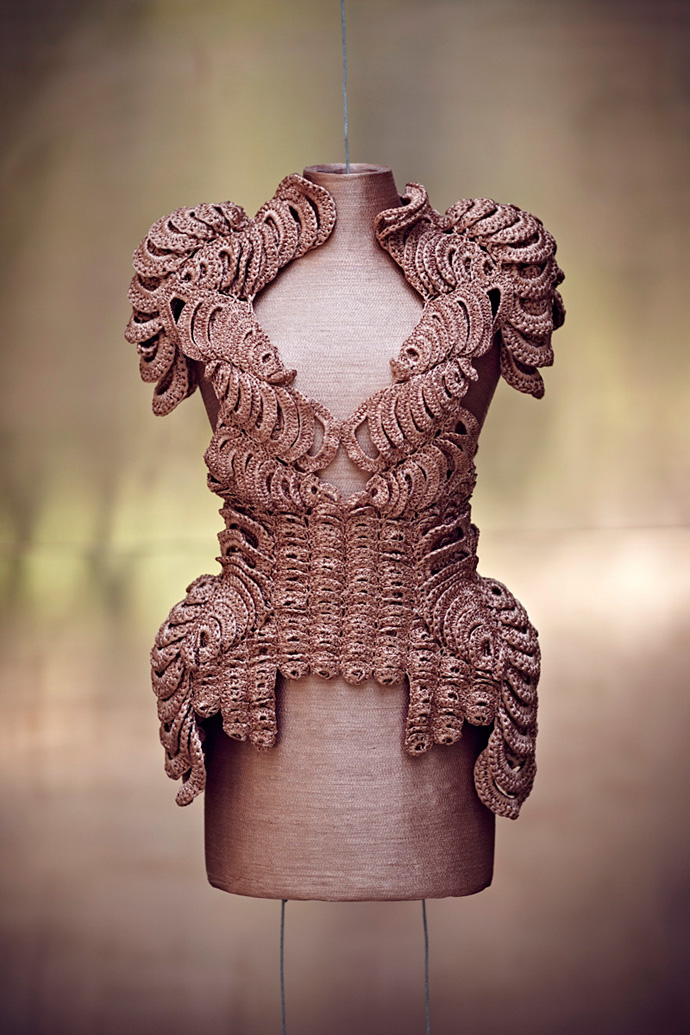 Sandra Backlund's installation CUPRUM 2010 at the Villa Noailles' pigeonnier. Photography by René Habermacher
Sandra Backlund's installation CUPRUM 2010 at the Villa Noailles' pigeonnier. Photography by René HabermacherRENÉ HABERMACHER: What was the point of departure for this installation and the inspiration behind it?
SANDRA BACKLUND: Everything took off from the position they gave me for my exhibition, the Pigeon House in the north garden of Villa Noailles. I think it’s a very beautiful space, so I wanted to use it as a frame, rather then just a location. Because the house is partly open and the exhibition would run for one month outside, I had to carefully consider what material to work with. Already for my current S/S 2011 collection I had been working with a metal yarn made from 100% copper, so in a way it came natural to me to continue exploring that material. With a history of use that is at least 10 000 years old, copper is an important part of both our history and the future. It’s one of the world’s most useful natural resources, 100% recyclable without any loss of quality and it’s estimated that 80% of the copper ever mined, is still in use today. In a way I feel like the story of copper as a material and the way I try to approach fashion go very well together.Can you explain me the process of planning, and the making of the dress?
As always, the handicraft techniques and the human body is the main starting point for me. I never sketch, instead I work with a three dimensional collage method where I develop some basic bricks that I multiply and attach to each other in different ways to discover the silhouette. The only thing I decided already from the beginning was that I wanted some kind of link between the signature piece (the paper origami top) of my winning collection from the 22nd edition of the festival in 2007. Because of the different techniques, materials and colours and because of the process, I guess in the end the link is not so obvious, but there is a few things that is still noticeable, like the silhouette and the size gradings for example.I’ve witnessed you working day and night on this piece – do you have a clue how many hours went into the making?
To be honest, I think that this is the longest piece I have ever worked on. First of all, crochet is always extremely time consuming, especially when it’s layered like this. The copper tape is also very fragile and ones it’s used it, it’s impossible to change, so I had let go of the control and in a way let faith guide me to the end result. If we are talking hours, my estimation is around 500-600 hours.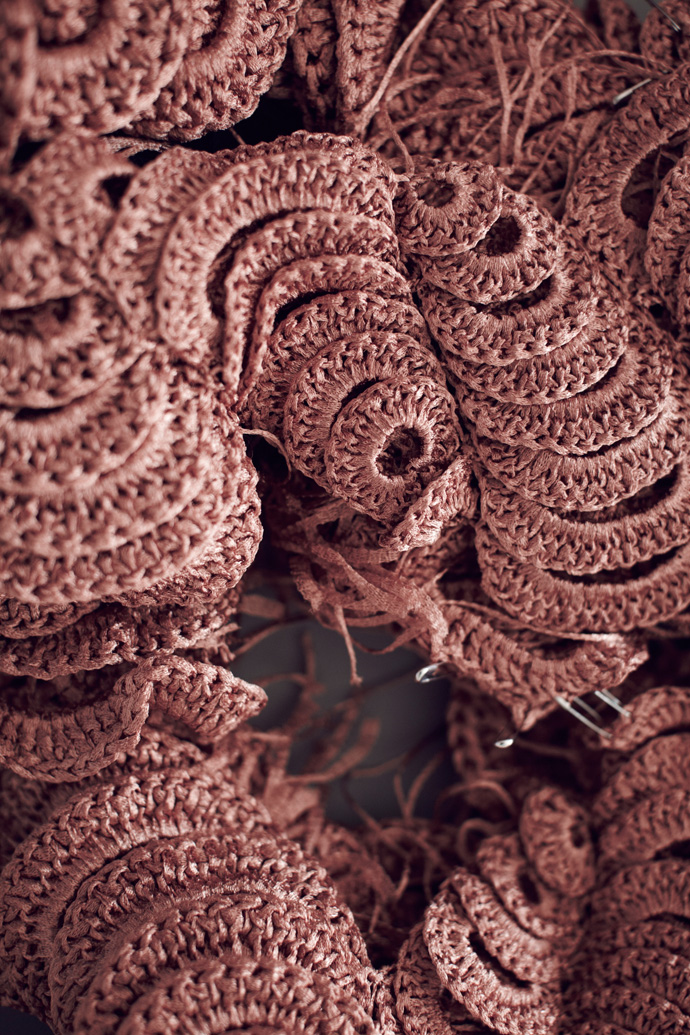
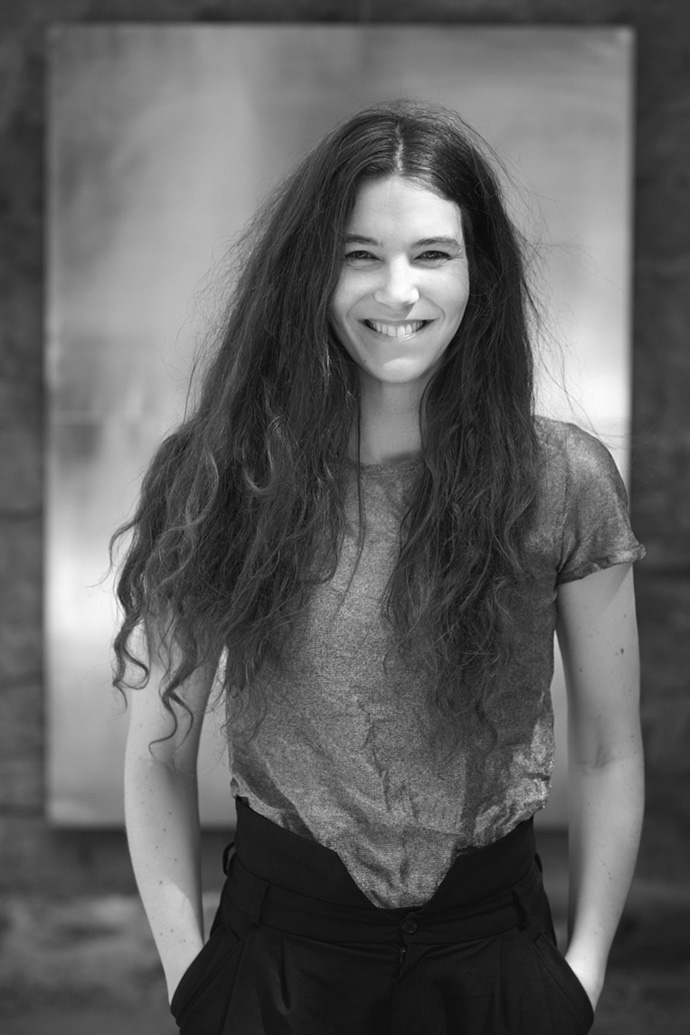 Pieces of copper yarn in the the making, and Sandra at the exhibition space. Photography by René Habermacher
Pieces of copper yarn in the the making, and Sandra at the exhibition space. Photography by René HabermacherYour pieces are often very sculptural, with the artisan work involved, i wonder wether you consider to put your work in a different context than fashion?
Of course I have consider this and many times questioned if fashion is really the right context for my work. As you said, my clothes are always quite sculptural and I also use methods when working that is more close to a sculptor’s, then a tailor’s. But somehow I always come back to the human body. I like to consciously dress and undress different parts of the body and I am very fascinated by all the ways highlight, distort and transform the natural silhouette with clothes and accessories. For me fashion is also one of the most democratic art forms, something that we are all related to. You don’t have to be a designer or a stylist to use clothes as a creative statement, but people in general could of course be more self-governed when t comes to fashion.To me it seems difficult to render your unique approach into industrial production. How are your experiences with that?
About two years ago I was introduced to the long tradition of Italian top knitwear and apparel production. The challenge was to add to my collections something inspired by my hand made pieces that could require only a limited amount of manual work. It was of course a big step for me to go from working alone in my studio, inventing pieces while doing them myself by hand, to suddenly be working in a team of experts within a field of fashion that I never before have had the chance to get to know. I was overwhelmed by all the possibilities I saw and even though I will never give up doing my hand knitted signature pieces, these production tests really made me understand that there is ways to develop my collections that I never thought was possible.What is this festival of Hyères to you? How was it to win – and to be back for this project?
The whole event is really an experience for life when you’re a young designer, all the people you meet and the rush from showing your work in a context like that. I didn’t know about the festival before I met Diane Pernet and she suggested that I should apply. I was crazy happy already when I was selected for the finale and then the wind up… It’s really an important moment in my career so far and to be back again this year and meet everyone was kind of a flash back. When I think about it, I’m still a bit shocked that I was the winner.What’s up next?
F/W 2011-2012 production, S/S 2012 collection and some up coming exhibitions.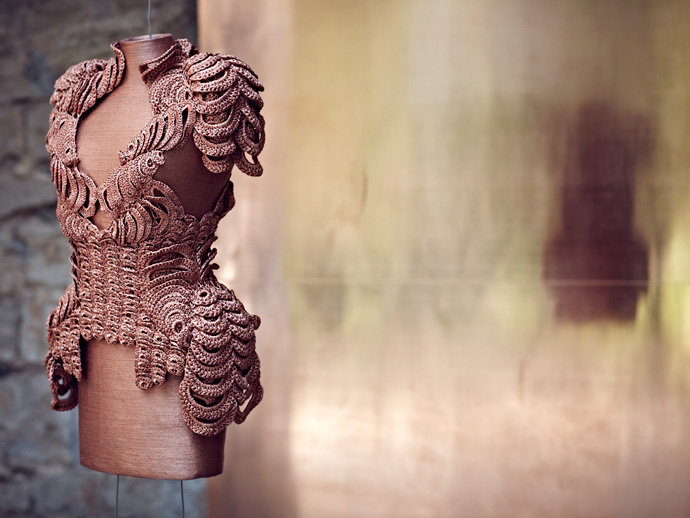
The dress weights over 6kg, made from an archaic material that was the first to be 100% recyclableFurther information on Sandra Backlund: sandrabacklund.com
The Exhibition at the Villa Noailles in Hyeres runs throughout May until the 29th
